Better Sailing
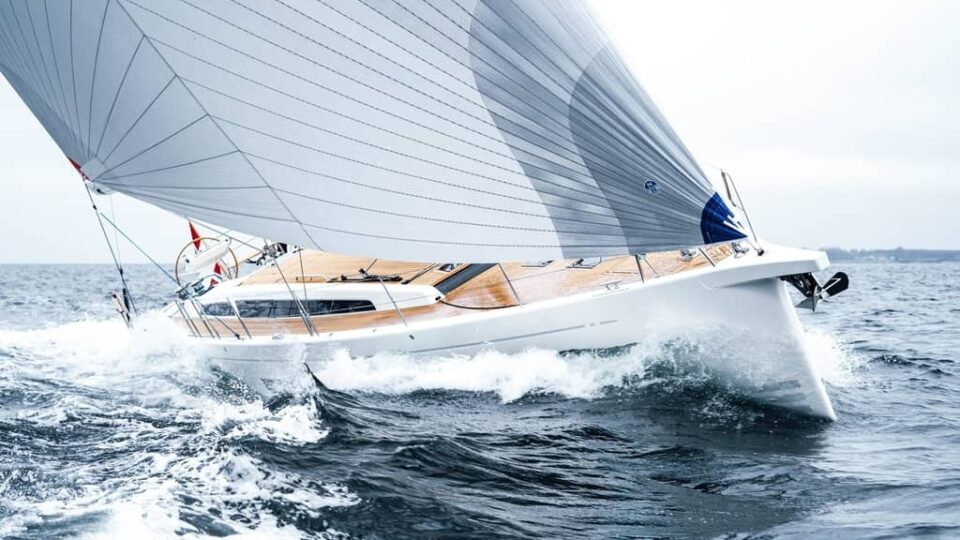

Names of Sails on a Sailboat
Are you a beginner sailor and want to get acquainted with the names of the sails? Are you an experienced sailor and want to learn more details about the sails on a sailboat? Then this article is written for you! Sails form a crucial part of the sailboat because without them, there’s no starting up. For that reason, there are many details about different types of sails concerning their utility, functionality, fabrication materials, and performance. Simply put, each sail serves different purposes when out on the water. Since the sail is the engine of your sailboat, in terms of it being the basic source of propulsion, it’s important to know when best to use either type of sail and why.
Types of Sails on a Sailboat
So, in order to better explain the types of sails, let’s look at their characteristics. The first important distinction between sails is their placement. Generally, the mainsail is placed aft of the mast , which means behind. On the contrary, the headsail is in front of the mast. There are also other sorts of sails that are used for specific conditions. These can be the spinnakers or balloon-shaped sails for downwind use. The second important distinction for the sails is their functionality. The specialized sails have different functionalities and are used in different sailing circumstances and weather conditions. A rule about sails is that large sails are appropriate for downwind use, whereas small sails are good for upwind use. Moreover, large sails perform better on weak winds while small sails are good for strong winds.
The Parts of a Sail and its Shapes
- Head: This is the top of the sail.
- Luff: The forward edge of the sail.
- Leech: Back edge of the sail.
- Tack: The lower front corner of the sail.
- Clew: The bottom back corner of the sail.
- Foot: Bottom of the sail.
There are two sail shapes, the fore-and-aft rigged sails, and square-rigged sails. Nowadays, fore-and-aft sails are more popular, have better performance and maneuverability. To grasp the idea square sails are the ones that Vikings had on their ships and are good at sailing downwind because they run from side to side. But they’re not suitable at all when sailing upwind. On the other hand, a fore-and-aft sail is tied from the front of the mast to the stern and is much better at sailing upwind.
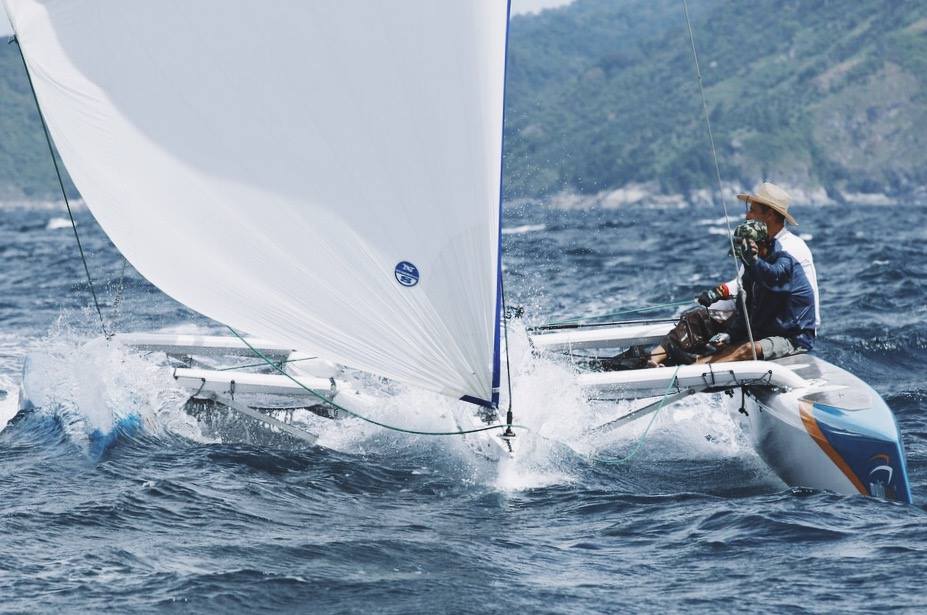
Also Read: What is Sailboat Rigging?
Types and Names of Sails
There are a lot of reasons why you’d want to put one sail over another, but the most important thing to remember has to do with the point of your sail and the wind strength. These points help you understand how your sailboat generates wind power. These points of sail include: into the wind (in irons), beam-reaching, broad-reaching, close-hauled, close-reaching, and running. They all go from windward to leeward and are symmetric from port to starboard . So, let’s get to the point and see the names and explanation of each sail:
- Mainsail : The large sail behind the mast which is attached to the mast and the boom, is called the mainsail. Mainsails cover a lot of surface area concerning incoming winds and by doing that they don’t need very strong winds to provide forward propulsion on a sailboat.
- Headsail or Jib : The small sail placed in front of the mast, attached to the mast and forestay (ie. jib or genoa), is called the headsail. Headsails are smaller than mainsails, thus their surface area is smaller. As a result, they can’t catch the same wind as a mainsail does. However, this is important because in case that the current wind is strong and the mainsail has been enough trimmed, being able to remove the mainsail and depend on the headsail alone, is a good strategy in order to reduce speed.
- Genoa : A genoa is like a large jib and it’s attached to the front of the forestay, like a headsail. When you use a genoa sail then you are expecting light to medium winds. Also, your sailboat would be somehow in a rush point of sail, meaning that the wind comes directly from the rear. Moreover, the surface area of a genoa sail is quite large, so it’s important to use it when winds are relatively low.
- Spinnaker : These downwind sails are symmetrical which makes them more sensitive to the reaching points of the sail and therefore more suitable for the running point of sail. Spinakkers are lighter than other types of jibs, and they don’t cover the mast like a genoa sail. Moreover, they remain unattached to the forestay and stretch out toward and past the bow of a sailboat.
- Gennaker : Gennakers are a mixture of genoa and spinnaker sails. There are small and big gennakers and both are downwind sails. They aren’t as symmetric as a spinnaker and aren’t attached to the forestay like a headsail. Furthermore, the gennaker sail is able to take on a more flexible point of sail while taking advantage of softer winds.
- Drifter Reacher : A drifter is a light air sail, and it’s basically a larger genoa for use in light winds. Its extra sail area offers better downwind performance than a genoa. It’s mostly made from lightweight nylon.
- Code Zero Reacher : This sail is a type of spinnaker, but it looks like a large genoa. However, code zero is designed for better reaching which makes it much flatter than the spinnaker.
- Windseeker : This sail is small, and it’s designed to guide light air onto the lee side of the mainsail. Moreover, it’s tall and thin and ensures a smoother flow of air.
Sail and Mast Configurations
Now that you got an idea of the different types of sails on a sailboat, it would also be an advantage to know how these types of sails are related to the configuration of a sailboat’s mast. There are numerous combinations when it comes to sails and mast configurations, let’s see some of them!
- Cat: A cat is similar to a dinghy and has one mast and one sail. The mast is located at the bow of the sailboat.
- Sloop: The sloop has the classic single mast and a double sail setup. The headsail can be different kinds of jibs, is connected with the forestay on the mast, and runs all the way up to the mast.
- Fractional Rig Sloop: A fractional rig sloop is different from the sloop because its forestay doesn’t reach the top of the mast. Its headsail is restricted to a fractional amount of space and this means that less wind can be captured, therefore the speed of the sailboat is reduced.
- Cutter: Having two forestays on the mast and cutters that are able to house two headsails this setup allows easy cruising because it offers a wide combination of points of sail for different strengths of wind.
- Ketch: Just like a sloop the ketch has a mast that enables the mainsail and headsail to a full range forestay. However, it also has a smaller mast between the mainmast and the stern of the sailboat.
- Schooner: A schooner is when a sailboat has two or more masts but it has a couple of sails to manage. A schooner’s aft mast is taller than the forward mast and sometimes a schooner can have up to six masts.
Names of Sails on a Sailboat – Summary
So, how many types of sails are there? In general, sailboats have one mainsail and one headsail. The rigging also affects the types of sails you can use. As we’ve explained before, the mainsail is a fore-and-aft Bermuda rig. Then, for a headsail, we use a jib or genoa. Most experienced sailors use extra sails to ensure better performance for their sailboat. For example, the spinnaker (a common downwind sail), the gennaker, the code zero (for upwind use), and the storm sail. Keep in mind that every sail has its own use and performance. Want to go downwind fast? Use a spinnaker. Don’t just raise any sail you think suits you best and go for it! It’s of great importance to understand the functionality, use, and performance of each sail.
Peter is the editor of Better Sailing. He has sailed for countless hours and has maintained his own boats and sailboats for years. After years of trial and error, he decided to start this website to share the knowledge.
Related Posts

Lagoon Catamaran Review: Are Lagoon Catamarans Good?

Best Inboard Boat Engine Brands

Are O’Day Sailboats Good? A Closer Look at a Classic Brand

Why Do Sailboats Lean?
- Buyer's Guide
- Destinations
- Maintenance
- Sailing Info
Hit enter to search or ESC to close.
Sail Types: A Comprehensive Guide to 8 Types of Sails
Sailboats come in all shapes and sizes. And that means there are many types of sails on the market! For those who might not know, sails are made of canvas and use wind power to propel sailboats through the water.
Understandably, different sails are required for different types of sailboats . And sailboats are categorized by the number of hulls they have. Monohulls have a single-hull design, catamarans have two hulls, and trimarans have three. Generally, sailors use catamarans for upwind sailing (but they can be used to sail downwind in certain conditions).
The type of sail you'll need for your sailboat depends on the kind of sailboat you have. Additionally, sails are highly dependent on the wind and weather conditions. Therefore, it's always a good idea to have different types of sails on board to navigate the ever-changing weather conditions.
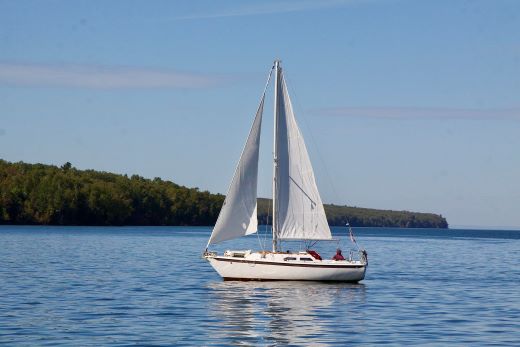
8 Types of Sails for Sailboats
As mentioned, you should carry multiple sails when sailing to prepare for various weather conditions. Here's a brief overview of the types of sails for sailboats:
1. Mainsails
The mainsail is the largest and most important sail. Therefore, it's probably the first sail to come to mind when you think of camping. Typically, it's situated directly behind the mast — connected to the boom — and uses wind energy to move the vessel. The mainsail plays a significant role in tacking and gybing, making it essential for any voyage.
Since the mainsail is a larger sail, it doesn't require wind to propel it forward. And the fact that it can be moved by moving the boom makes it uber-easy to operate.
Learn More About Sailing
2. Headsail
The headsail often accompanies the mainsail, though it is smaller in size. Regardless of your sailboat type, the headsail is positioned at the front of the mast – over the sailboat's bow.
Because headsails are small, they are helpful when navigating through windy conditions. Smaller sails catch less wind, preventing them from propelling your boat as strongly as larger sails. Additionally, headsails help lift, balance, and protect the vessel from inclement weather conditions.
While the term 'headsail' refers to any sail in front of the mast, the jib is the most common type of headsail. (And when a jib is so large that it overlaps the mast, it's called a genoa.)
Learn More About Sailboats
3. Genoa
The genoa is a large sail that attaches to the front of the forestay. (In this instance, it's similar to a headsail.) However, the genoa is larger than the headsail and overlaps the mainsail partially or completely to help the boat go faster.
Genoa sails are useful when sailing through light or medium wind. You can also use it when the wind comes directly from the rear. If you use a Genoa sail during high winds, you'll probably start sailing too quickly and put yourself and your boat at risk.
4. Spinnaker
The spinnaker is a large and whimsical (often colorful) sail. Spinnaker sails are usually symmetrical, allowing them to reach different points of sail. Generally, these are lighter sails and don't cover the mast like the genoa.
Because spinnaker sails are on the larger side, you have to be incredibly careful with them. Don't use them in rough conditions. Instead, save them for sailing in low winds and calm seas.
5. Gennaker
As the name suggests, the Gennaker sail combines a spinnaker and a Genoa sail. They are as large as the spinnaker, although they're not symmetrical.
They come in handy whenever the wind changes from a pure dead run to a reaching point of sail, as sailors can navigate various wind types with the same sail. It's still only meant for lighter and milder winds, but it's more versatile than the spinnaker and genoa.
6. Light Air Sails
Light air sails are useful in calmer conditions when the headsail and mainsail alone aren't cutting it. They include:
- Code Zero : A code zero sail is a gennaker sail ideal for sailing in light to mild winds. It's designed to create lift and boost boat speed whenever regular sails don't generate enough power. For that reason, many racers and cruisers use code zero sails to improve performance and gain control in various situations.
- Windseeker : This small, special sail is reserved for no wind or light wind. Essentially, it helps boats remain maneuverable in extremely calm conditions. And for that reason, it's valuable to long-distance sailors.
7. Storm Jib
Storm jibs can be used as a headsail whenever the weather is particularly rough and windy. Because it functions as a safety seal, it prevents boats from capsizing by reducing the sail area exposed to the wind. Therefore, it's a necessary sail for every sailor.
Read Next: Boating in Inclement Weather
During strong winds and storms, sailors can raise a trysail — a small, triangular sail near the boat's stern — for better control and stability. Generally, sailors do this whenever the mainsail becomes too large and challenging to maneuver.
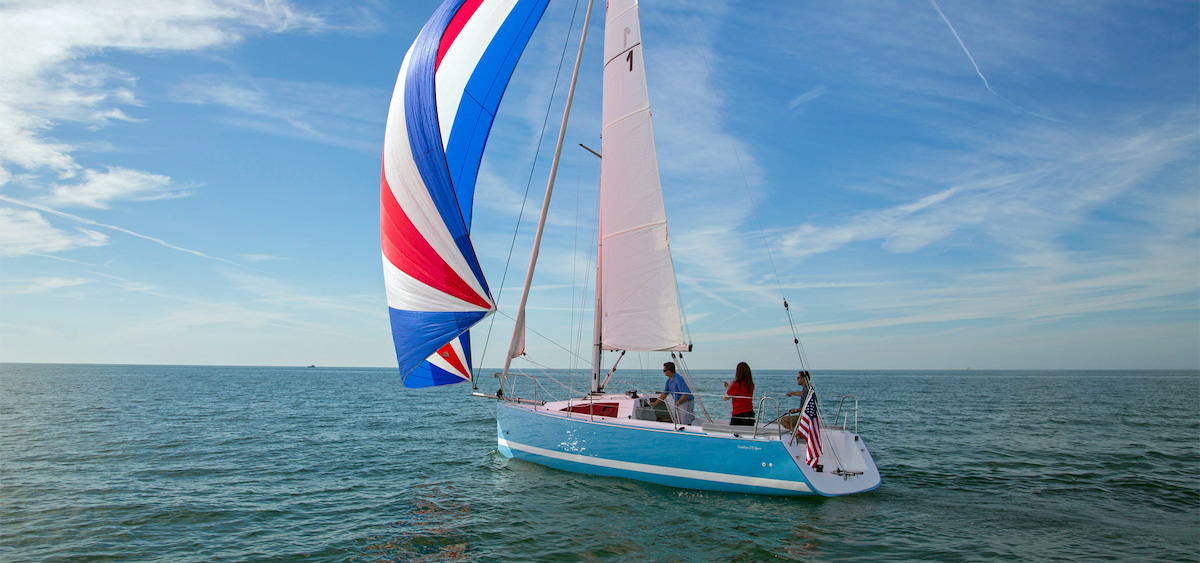
Join Our Newsletter!
Get community news, buying bargains, and how-to guides at your fingertips.
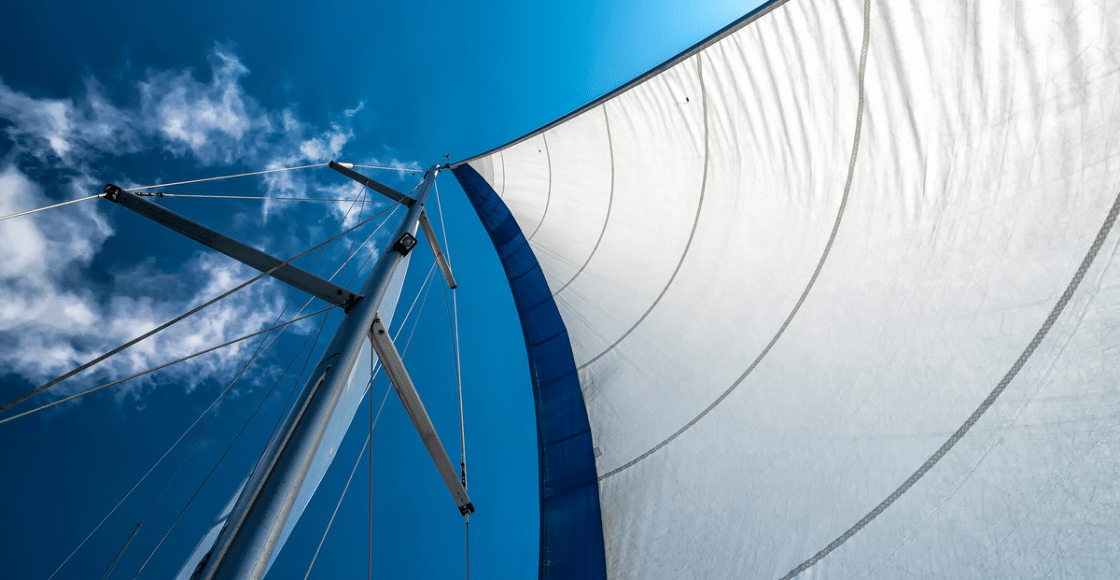
Type Of Sails: A Complete Guide

Table of Contents
Last Updated on September 29, 2023 by Boatsetter Team
If you are approaching sailing and sailboats from a very beginner’s perspective , then the concept of different kinds of sails can be a strange one. We often believe we see one kind of sailboat with one kind of sail, and our simple minds lead us to believe you are only meant to move them around, and you will get to where you need to go.
However, you would not have landed on this article if you did not suspect that there was more to sails and sailboats. So here, you can have a kind of in-depth, kind of summarized review of the different kinds of sails and the most popular sail and mast configurations out there.
It is also important to understand why there are so many different kinds of sails. When you are out on the water, different weather conditions can occur. Your sail acts as a motor of some sort, moving your sailboat forwards, but your sail is also highly dependent on the wind conditions around it. This is why having different kinds of sails can help you navigate your weather conditions and turn them to your own advantage while sailing.
Different sails also come with different danger levels in case of strong wind, so knowing what kinds you might need to watch out for is also extremely important. So, without further ado, let us get into it.
You may have heard of this one before or seen it portrayed in movies and TV shows. As the name suggests, the mainsail is the most popular kind of sail on any sailboat, and they are found behind the mast. They are also attached to the boom. Because they take up so much space on your sailboat, they are also one of the most important sails to take care of and keep an eye on.
Since the mainsail is such a large sail, it does not require too strong a wind to propel it forward , as its large surface area will easily catch a breeze. At the same time, the fact that it can be moved around by moving the boom makes it, so it is easy to steer. This makes it so that the mainsail is the most important sail on your sailboat.
Headsail/Jib
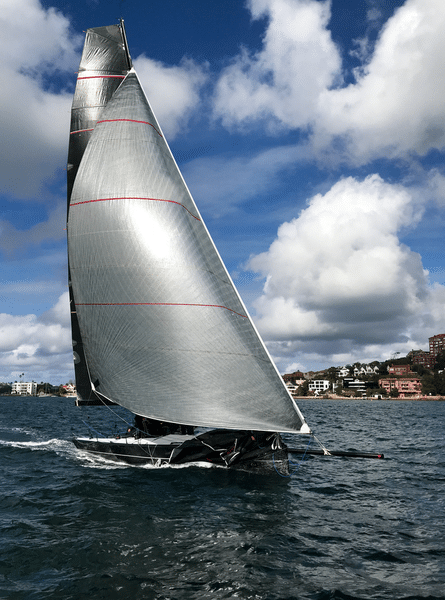
The headsail, or the jib, is likely the second most popular kind of sail found on sailboats. This is because it often accompanies the mainsail, the most popular kind. On all sailboats , the headsail is put at the front of the mast over the sailboat’s bow . It is always a smaller sail than the mainsail.
The fact that the headsail is smaller can be especially useful if you are caught in strong winds. In this situation, you likely do not want to use your mainsail (or trim it as much as possible) to move slower and not be thrown around by the winds. Smaller sails catch less wind, meaning they do not propel your boat as strongly as larger sails.
Having a good headsail can be an incredible safety measure, especially if the seas you are trying to sail are known to be wild and unpredictable.
You may have seen a genoa sail before if you have been around boats or have ever lived in a coastal town. This kind of sail is a large sail that you can attach to the front of the forestay (similarly to the headsail). This is a larger sail than the headsail and can even cover the mainsail either partially or completely. For this reason, the genoa also used to be called an “overlapping jib.”
You should use a genoa if you are sailing through either light or medium winds and if your sailboat is at a dead run point of sail (this means that the wind is coming directly from the rear. If you attempt to use a genoa sail in stronger winds , you might start going too fast and put yourself and your boat at risk since it is such a large sail. So, it is important to be careful .
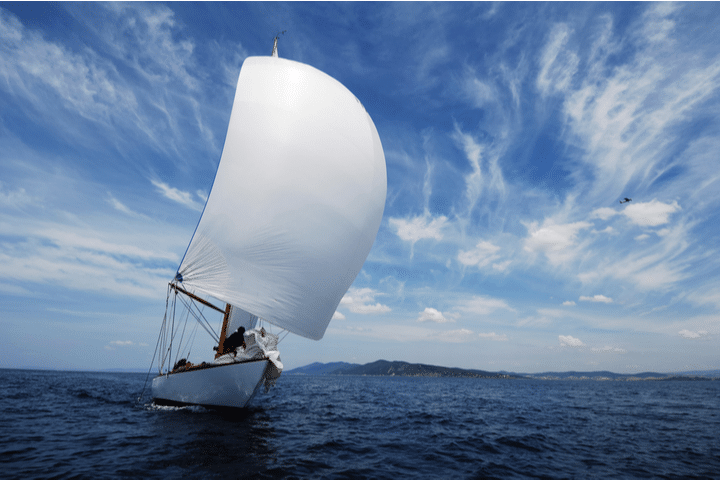
The spinnaker is the most whimsical kind of sail since it is a large and colorful kind. They are also often symmetrical, which means they are more appropriate for reaching different points of sail, such as the running point of sail. They are lighter sails, and they do not cover the mast as the genoa sail does. You do not attach a spinnaker to the forestay and instead let it stretch out past the boat’s bow.
The large surface area of the spinnaker means that you have to be even more careful than with others on the kind of conditions you choose to use this sail in. If the winds are too strong, you could be putting yourself and your passengers at serious risk using this sail, so you should choose to use it only at times when the wind is low or in seas that are known for their low winds and tranquility.
As the name suggests, the gennaker sail mixes the genoa sail and the spinnaker sail. These kinds of sails are more recent inventions. They are as large as the spinnaker sail, but they are not symmetrical. Unlike the genoa or the headsail, they are also not meant to be attached to the forestay, like the spinnaker sail.
The usefulness of this sail is that if the winds change from a pure dead run to a reaching point of sail, then sailors do not have to resort to using a spinnaker from a genoa, instead of being able to take advantage of different winds while still using the same sail as they were before. This kind of sail is still only meant for lighter and milder winds , but there is more flexibility with the gennaker than the genoa and the spinnaker sails.
Popular Sail and Mast Configurations
There are many different ways to place the sails we have learned about in the above section. We have compiled a list of some of the most popular ones so you can understand how these sails can be used to make a sailboat move through the oceans.
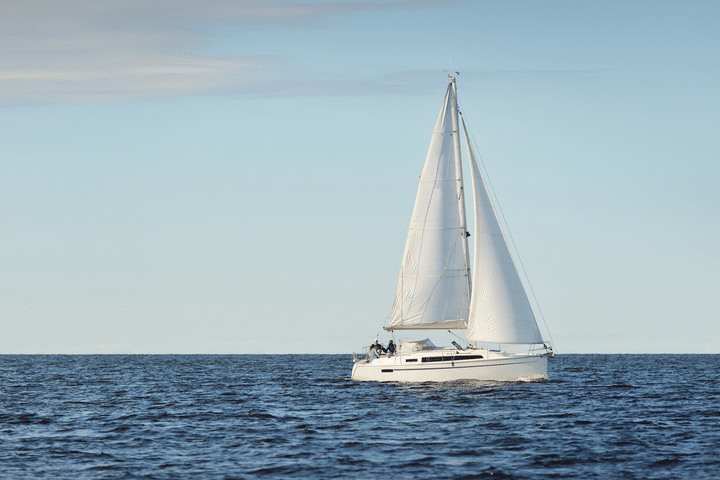
A sloop is by far the most popular configuration. It features a single mast, double sail (the mainsail and the headsail), and mast configuration. The headsail is located from the forestay on the mast to the top of it. The type of headsail used can also vary from a genoa, a spinnaker, or a gennaker sail.
Fractional Rig Sloop
A fractional rig sloop also features a single mast with a double sail setup similar to a sloop. However, what makes the fractional rig sloop different is that the forestay does not reach the top of the mast. This means the headsail is constricted to a smaller amount of surface than on a regular sloop, making it so that your sailboat captures less wind and moves slower .
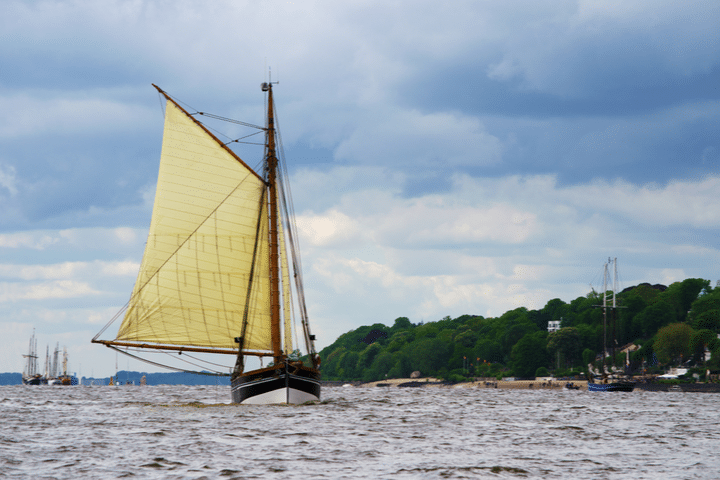
Cutters are interesting because they’re like a sloop but with a second forestay. This can be useful because it allows them to carry two headsails (a mainsail and one of the jibs). Cutters are good for cruising because they offer a range of wind options, giving you more time to get from place to place.
This is a less common mast configuration than previous others on this list. This is because a ketch features two masts. There is a larger mast fit for the mainsail and the headsail and a smaller mast between the mainmast and the stern (the rear) of the boat. This kind of mast configuration is more commonly found among Northern European freighters or fishing boats. This mast configuration is also called the mizzen mast.
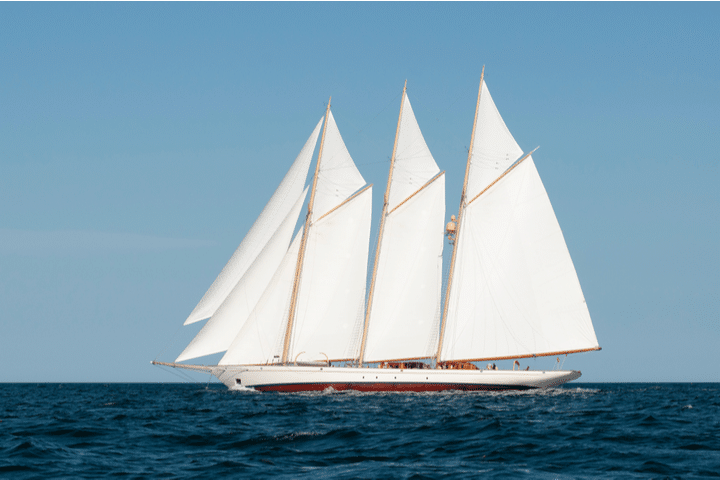
A schooner mast configuration features two or more masts. This is similar to the previous configuration, the ketch. It also features multiple sails. While a ketch’s aft mast (also known as the rear mast) is higher than the forward mast, a schooner’s aft mast is shorter than the forward mast. A schooner can also have up to six masts (although two are the most common). These are the main differences between the two.
This one is quite similar to a ketch mast configuration (mentioned above). The only real difference between them is that the mizzen mast is put directly behind the sailboat’s rudder post in a yawl.
A cat sail will have one mast and one sail. The mast is put at the bow of the sailboat. This kind of mast configuration is often found on smaller boats, more specifically on dingy boats. Boats with the cat mast configuration are also often called catboats.
Final Verdict
Having the appropriate kind of sail on your sailboat is incredibly important. At the same time, being aware of the kinds of sails that there are and the kind of sail and mast configuration can make you into a more well-rounded and informed sailor. With that in mind, we hope that you leave this article feeling more confident in your skills when you are out at sea.

Boatsetter empowers people to explore with confidence by showing them a world of possibility on the water. Rent a boat, list your boat, or become a Boatsetter captain today.
Browse by experience

Explore articles
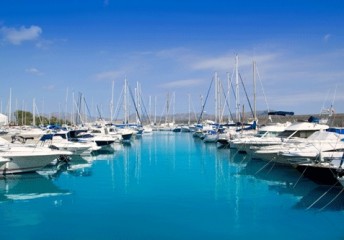
Boatsetter & Marinas International Announce Partnership
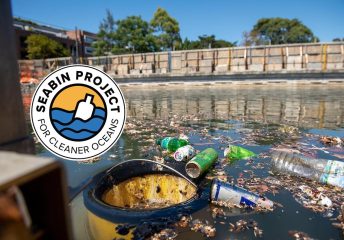
Seabin Project for Cleaner Oceans | #MindYourWake Series
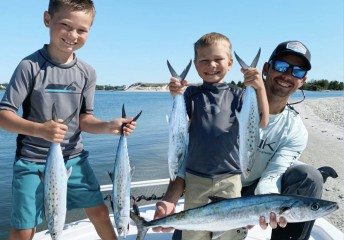
Zachary Shares How His Sons Amplify His Love For The Water
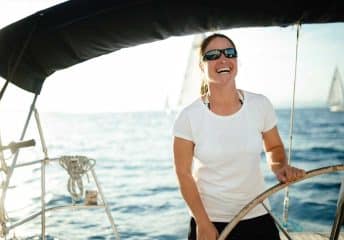
Boating for Beginners: How to Start Boating

The Different Types Of Sails And When To Use Them – Complete Guide

Sail forms an integral part of a sailboat. When you sail on the open water and observe other boats (in various sizes), you’d have noticed how each boat type has a specific model of sail. If you’re a beginner in boating, you must know that there are a ton of different sails and they each have their own purpose.
As a general setup, sailboats will use three common sails, including headsail, mainsail, and specialty sail. Due to the varying wind conditions and the model of the sailboat, there are many types of sails including jib, genoa, trysail, storm jib, code zero, gennaker, and spinnaker.
While that sounds like too many models of sails, you can easily differentiate between them and choose the ideal model based on your purpose. This article guides you on this aspect. Let’s begin!
Different Types of Sails & When To Use Them
1. mainsail.
Mainsail is by far the most widely spotted sail model, and it’s usually fixed to the boom and fitted behind the mast. This offers the highest mileage to your sailboat, thereby maximizing speed and performance.
You can use a mainsail if:
- You’re concerned about the performance
- You need to go faster and utilize all wind power
- You need to steer your boat irrespective of the wind’s status
- You’ve a large boat and can offer adequate space to this sail.
This mainsail displays a wide surface area to make the most out of the available wind condition. As a result, you can steer your boat quite easily. However, the downside is its size. It is very large and hard to store if you need to take it down for some reason.
Check out my other article all about maintaing sails!
2. Headsail
Similar to a mainsail, it’s very easy to spot a head sail. Just look at the bow of the boat and see if there is a sail. If you see one then yes that’s a headsail. Also called a jib or genoa, a headsail is smaller in size compared to a mainsail and attaches in front of the mast to the forestay. The Foresail will not have a boom for the clew of the sail to attach to. The clew will be attached to the foresails sheet. It can be used without the mainsail in certain conditions but for the most part the two sails are used together. The foresail is always forward of the main.
The headsail comes in many different forms such as a jib, genoa, spinnaker or storm jib. The most common headsail is a jib or genoa.
You can use a headsail if:
- Your sailboat is set up for it.
- You don’t want to use the mainsail at this time.
- Your mainsail is not usable.
The biggest advantage of a headsail is the option to protect yourself even if the wind turns unpredictable or wild. This all depends on the type of headsail you are using.
So, what are the different types of headsails? Let’s take a look!
As more boaters chose to use a headsail for their boats, the jib was introduced as one of its forms. The Jib is a form of headsail that is attached to a shackle present on the deck’s front region.
The Jib is a sail that does not go past the mast when it is raised and in use. If it goes past the mast then you probably have a genoa.
You can use a jib if:
- You are out for a normal day of sailing in moderate wind speeds
- You have a roller furling. Which is a sail that wraps up around itself.
Some weather conditions can make maneuvering harder or tighter than usual. As a result, it’s essential to use a jib in such cases. It functions well with boats containing a roller furling as the jib handles different positions and tackles the movement of the boat at ease.
2.2 Genoa
Just when you’ve got acquainted with the jib, genoa comes into the picture as a larger version of the jib. If you’re boating along a coastal region, the genoa sail is the one widely used and is attached to the front area of the deck as well.
Here’s a quick trick to find out if a boat has a genoa sail. This genoa is usually larger than a Jib. This means that the genoa effortlessly overlaps and extends itself beyond the mast, thereby covering the mainsail as well.
You should use a genoa sail if:
- You’re planning to sail in minimum wind conditions. Less wind means you need more sail.
- You find the wind to originate from the rear area.
- You own a large boat. Remember that genoa can partially or completely cover the mainsail too. Larger sails for larger boats!
While it’s great for sailing in regular conditions, there are downsides associated with it. A genoa can put you in a dangerous situation if you are sailing in high wind conditions and don’t have the ability to furl in the sail. Furling in the sail will reduce the area of the sail and catch less wind.
Genoas do come in many sizes as well such as 110% or 120%.
The next section of the sail list are ones that aren’t necessary but can be helpful in certain situations. Let’s look at specialty sails!
3. Specialty Sail
While headsails and mainsails are quite commonly used, there are also specialty sails in the market to address specific requirements. Some of the widely seen specialty sails are spinnakers, storm jibs, and code zeros.
3.1 Spinnakers
Spinnaker is a sail dedicated to downwind and is quite large. Think of a beautifully covered parachute.
It’s easy to spot spinnakers as they resemble kites or parachutes. However, it crosses the bow of the boat and isn’t attached to the forestay.
Unlike the genoa sail that covers the mast, a spinnaker fails to do so. The advantage of a spinnaker is the surface area. When the wind is light, the spinnaker can catch a lot more wind giving you more speed. The Spinnaker is usually fixed to three points – pole, halyard, and sheet.
You should use a spinnaker if:
- You have minimal wind on a run.
- You are trying to harness as much wind power as you can.
While it has a wide surface area, the downside is its inability to steer the boat during strong wind conditions. It can even put the passengers at risk when the wind is at high speeds.
Make sure you have experience before trying out the spinnaker.
3.2 Storm Jibs
Storm jib is another type of specialty sail meant exclusively for rough weather. It’s a tiny, triangular structure that helps during offshore racing or cruising. Just think of it as a smaller jib.
You should use a storm jib if:
- You’re going to sail in heavy weather conditions.
- You anticipate high wind speeds.
- You’re going to be in an offshore race and they are an approved sail type.
Note: In the case of an offshore racing requirement, it’s critical to take prior permission from the regulatory authority for using a storm jib.
3.3 Code Zeros
Code zero is another updated version of a spinnaker that’s meant to be a combination of genoa and gennaker sails. It resembles the look of a genoa but is a lot bigger.
You should use a code zero if:
- You’re looking for an overlapping flying headsail.
- You’re sailing only in light air conditions.
- You’re looking for an alternative to a Genoa.
Having said that, a code zero or a screecher does the job of a genoa with better efficiencies.
3.4 Trysail
Trysail is another type of specialty sail that’s tiny, triangular, and can be fixed right above a gooseneck on the sailboat.
The Trysail is less known in the market as most boaters go ahead with common mainsails and headsails. It’s essential to acknowledge trysail as a front-and-aft mainsail model. It offers excellent performance and contains a permanent pennant in it.
You should use a trysail if:
- You’re sailing in heavy weather conditions.
- You’re looking for a storm replacement.
- You are experienced with using them.
The quadrilateral sail in a trysail is usually turned and bent to a mast, and this helps in heading the vessel during windy conditions.
3.5 Gennakers
If you’ve been able to spot genoa and spinnaker in the past, identifying a gennaker is incredibly easy. A gennaker is a hybrid sail form that is small, slow, and requires no pole attached to the mast.
You should use a gennaker if:
- You’re looking for a smaller version of a spinnaker.
- You’ve no space to fix a pole to the mast.
- You require the sail to be easily manageable.
- You’re sailing in a region requiring minimum downwind levels.
Choosing a hybrid sail has a lot of benefits as it combines the usefulness of 2 sail models. However, being aware of their cons is critical to planning a safe sail.
As you begin using these sails, you can also look for better customizations. There are drifters, wind seekers, and other jib types that are meant to handle different wind conditions.
How Many Sails On A Sailboat ?
In general, a sailboat contains two sails. Two sails is the typical setup for the best performance of the boat during different wind conditions. It’s essential to pick your two sails based on your sailing plan.
Why Are There Two Sails On A Sailboat?
A sailboat uses two sails because the wind left over by the first sail is easily caught by the second sail. This helps in steering the sailboat to a better extent and gives the sailboat more power.
Final Thoughts
Sails are one of the major assets of a sailboat. From managing wind to maximizing the performance and longevity of a sailboat, the type of sails you use, plays a huge role. From the various sail types listed in this article, you can choose the best model that fits your sailing routine. Just make sure to remember to check and make sure they are the correct size for your vessel.
Make sure to plan ahead and have the right sails for your sailing weekend. Cheers!
Boatlifehq owner and author/editor of this article.
Recent Posts
How to Repair a Sailboat Hull: Step-by-Step Guide
Maintaining your sailboat's hull is crucial for ensuring its longevity and performance on the water. Hull damage can occur due to various reasons, such as collisions, grounding, or general wear and...
10 Steps For Anchoring Your Sailboat
Anchoring a sailboat is a fundamental skill every sailor must master. Proper anchoring ensures your boat remains secure, preventing it from drifting and potentially causing damage. Whether you're...
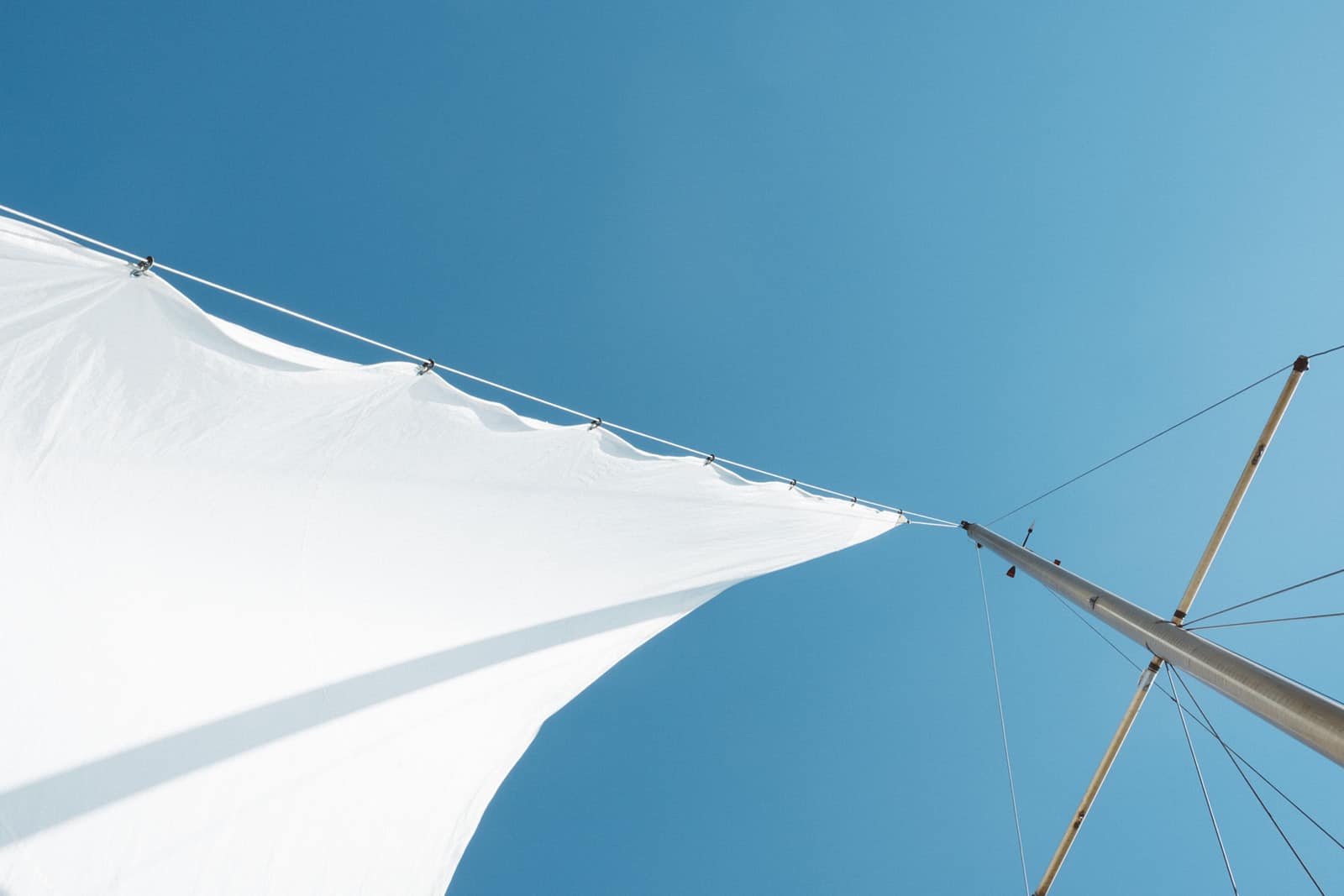
Names Of Sails on a Sailboat: What Are The Most Common Types Of Sails?
In this article, you are going to see more about the world of sailing.
There are different types of sails used in specific boats.
Check out some of the names of sails listed below to find out the most common sails names …
Drifter / Reacher Sail
Common types of sails.
This is the largest piece of the mast in a sailing vessel.
However, on a square vessel, it is the lowest on the main-mast.
The mast is responsible for the navigation of the boats from one end to the next.
Perhaps, it is safe to say that the speed of the bat will be determined by this piece of sail.
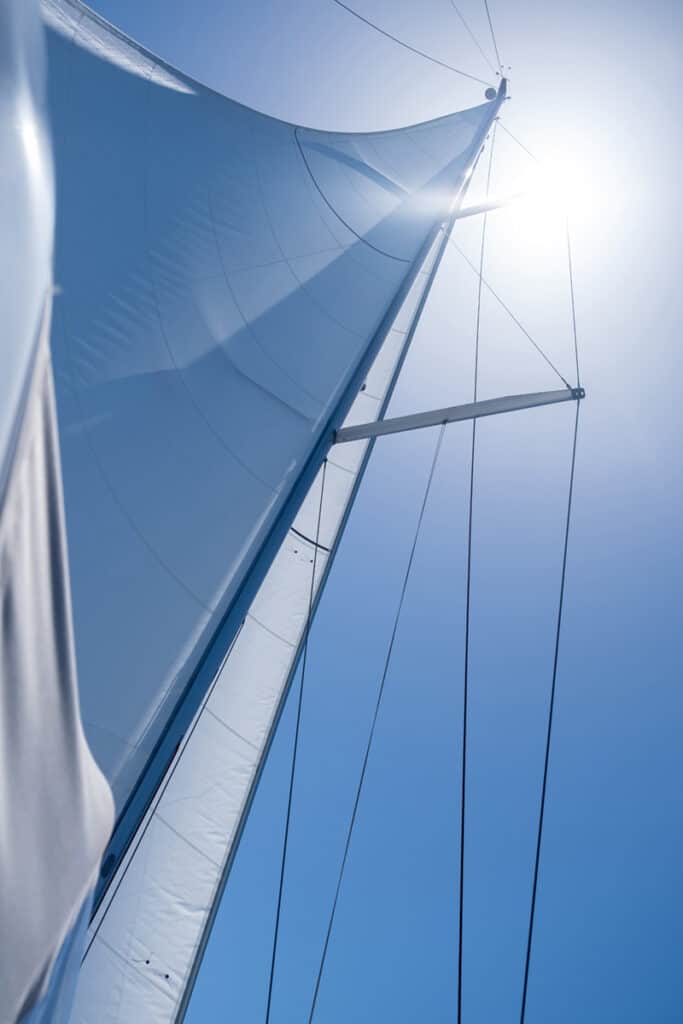
This type of sail is always triangular although, some of them always have four corners.
The triangular staysails that are used at the foremost position on the boat are called jibs.
In boats, these rigs help in tacking which will further help in preventing the lumbering up of the windward side.
Genoa is the largest jib that overlaps the mainsail.
It extends past the mast when you have a different view from the side.
The jib was originally given the name overlapping jib, which further changed to what you know it for today.
However, it is only fair to know in what types of boats the jib is well fitted to work.
You can find them in boats such as yawls and ketches.
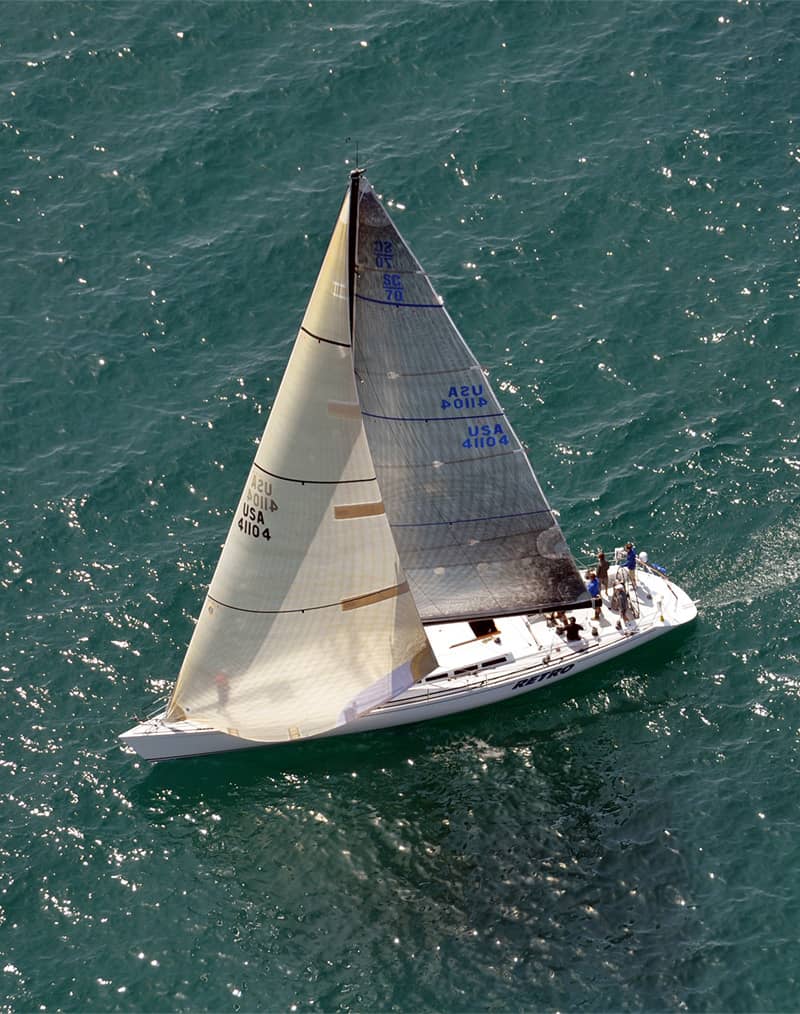
Spinnaker is a different type of sail due to the functions it performs on the movement of the boat.
It is designed for sailing off the wind from reaching the downwind.
As the boat is in motion, the spinnaker is filled up with wind creating a balloon like shape.
It has a construction that is purely made out of lightweight fabric like the nylon.
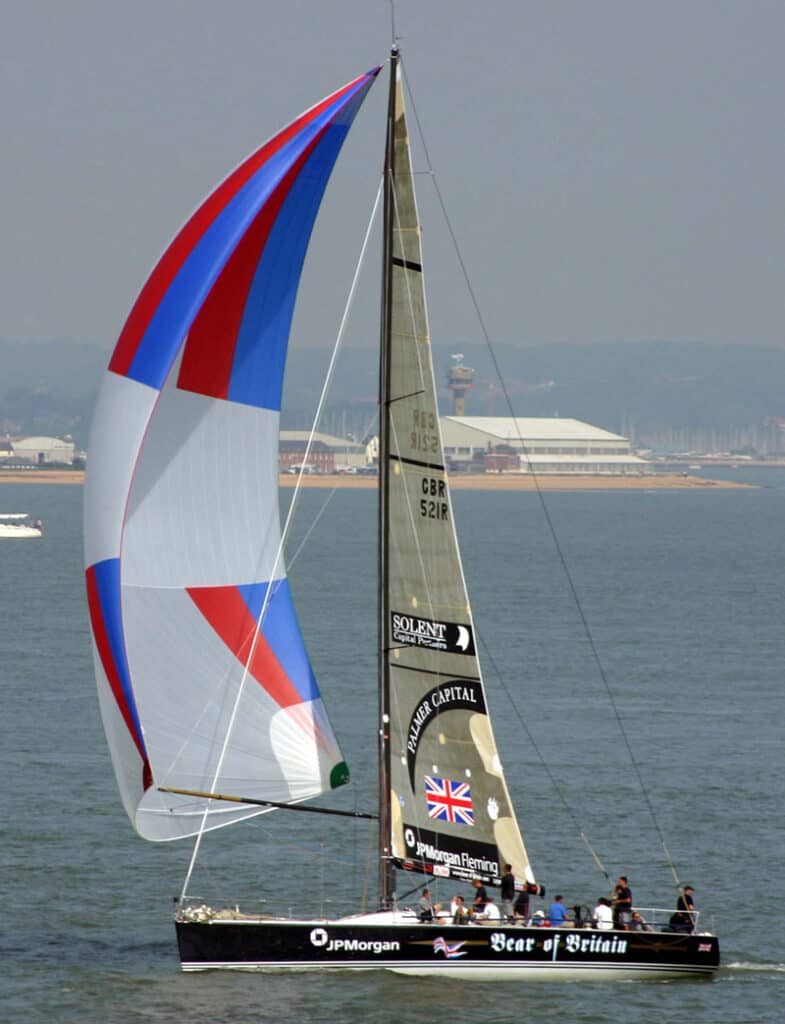
The Gennaker has recently been developed in the 90’s which a design showing that it is majorly, a crossover between Genoa and the spinnaker. Gennaker is rigged as the spinnaker but it’s tack is fastened to the hull.
The best thing about it is that it can obtain the optimum generation of lift within a short period of time.
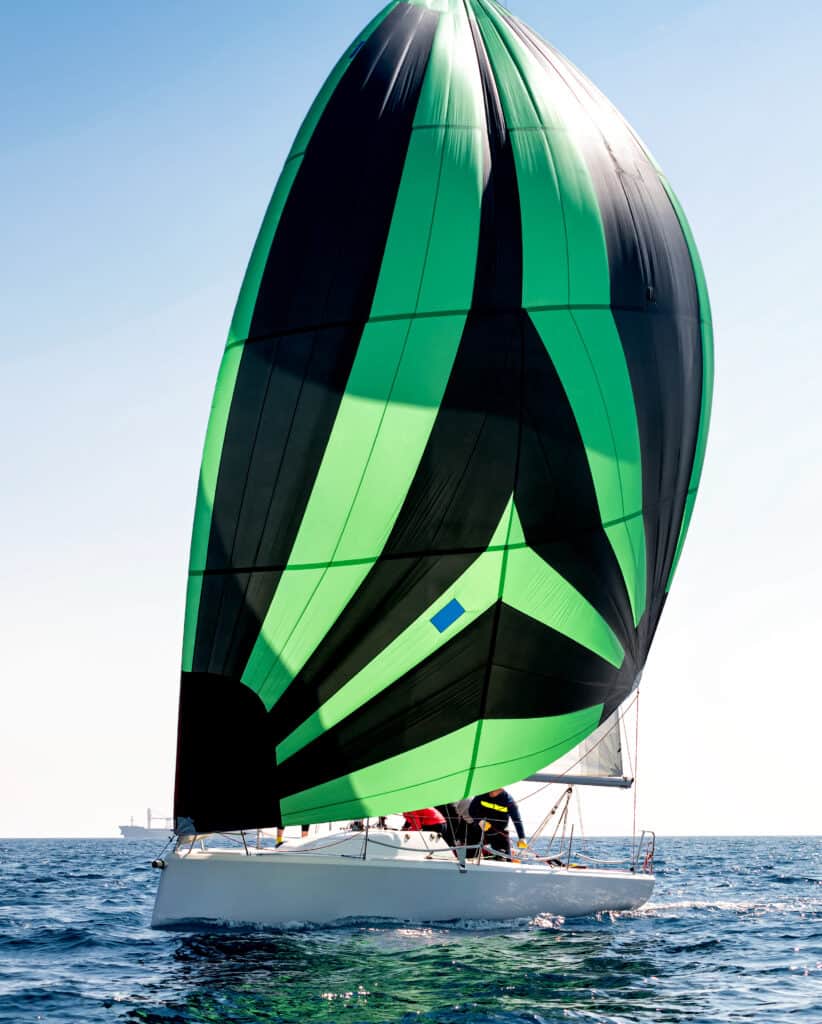
The drifter is a full draft lightweight made of nylon.
Drifters are designed with the ultimate purpose of cruising the sailors.
A drifter can make the work of a spinner much easier when cruising a spinmaker.
The best thing about drifters is that they come in different choices of colours and so you have the choice to mix and match.
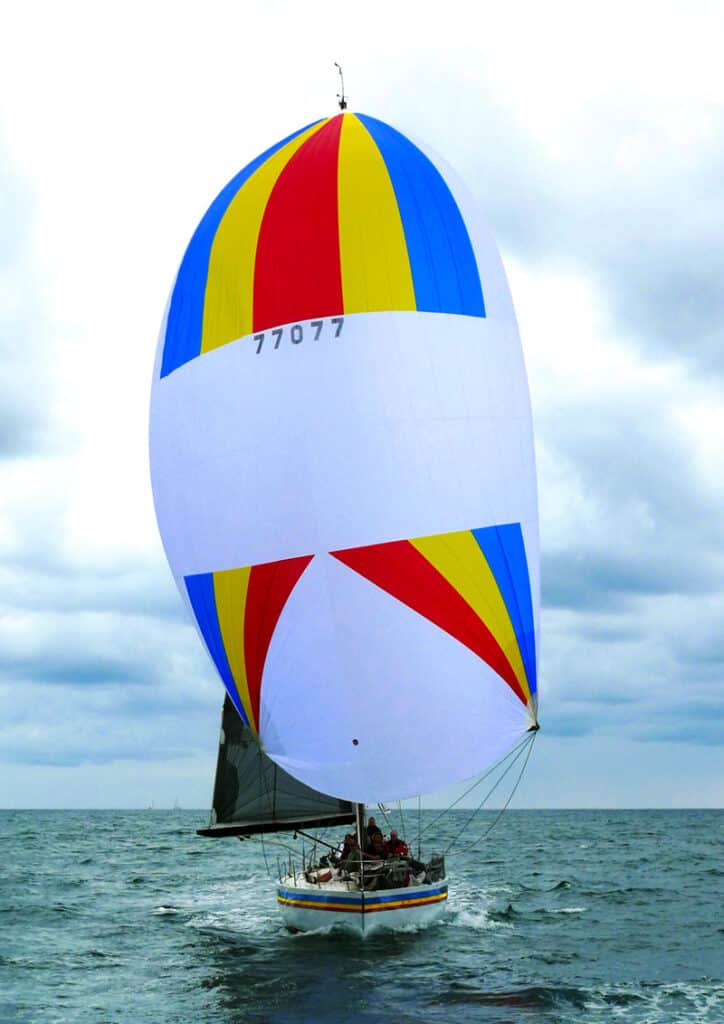
The most common types of sails are as follows:
- Drifter / Reacher
So, these are what you’ll find most commonly on boats.
Disclaimers
All product names, logos, and brands are property of their respective owners. All company, product and service names used in this website are for identification purposes only. Use of these names, logos, and brands does not imply endorsement.
It is our policy to make every effort to respect the copyrights of outside parties. If you believe that your copyright has been misused, please provide us with a message stating your position and we will endeavor to correct any misuse immediately.
Some of the links in this post are affiliate links. As an Amazon Associate, we earn from qualifying purchases. This means if you click on the link and purchase the item, we may receive an affiliate commission, at no extra cost to you. This helps us keep this website alive. Learn more here .

Hi, I’m Igor, Skipper of S/Y "The Hooker". A decade ago, I conquered my childhood dream: to be a sailing skipper, own a sailing yacht. Yes, it knocked dullness out of my urban life — Read more →
Leave a Reply Cancel Reply
Your email address will not be published. Required fields are marked *
Name *
Email *
Add Comment *
Save my name, email, and website in this browser for the next time I comment.
Post Comment
Related Posts

What to Do if a Fire Breaks Out in the Front of Your Boat
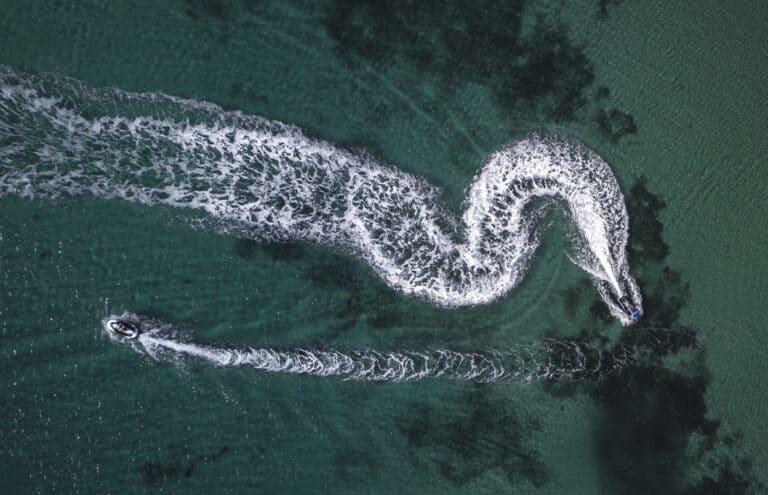
Crossing Paths With Other Boats: Frequently Asked Questions
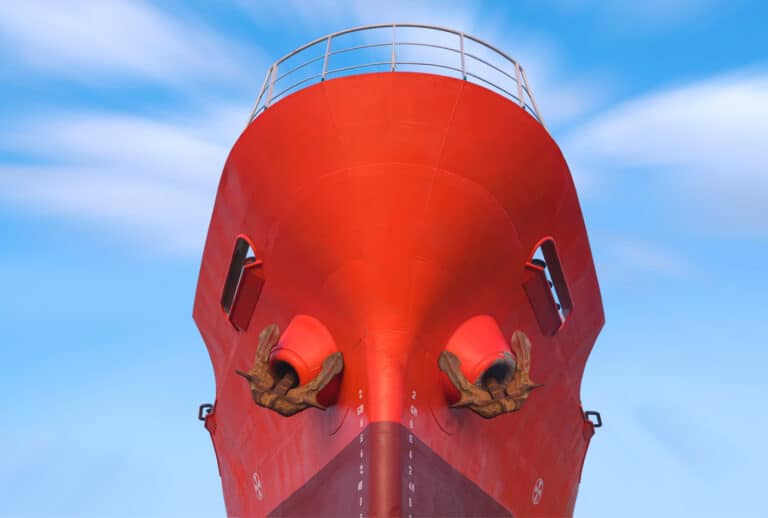
What Kind of Hulls Do Most Sailboats and Large Cruisers Have?
Amazon Disclosure
DesperateSailors.com is a participant in the Amazon Services LLC Associates Program, an affiliate advertising program designed to provide a means for sites to earn advertising fees by advertising and linking to Amazon.com. As an Amazon Associate, we earn from qualifying purchases. Amazon and the Amazon logo are trademarks of Amazon.com, Inc., or its affiliates.
Please refer to our Privacy & Affiliate policy for more details.

Types of Sails: A Comprehensive Guide
In the enchanting world of sailboat dynamics, where the dance between wind and water takes center stage, the significance of sails cannot be overstated. Like the wings of a bird, these meticulously crafted sails unfurl to catch the slightest whisper of breeze, converting it into a powerful forward thrust that carries us through the vast expanse of the ocean. They are the very essence of a sailboat, the conduits through which dreams and aspirations set sail.
Join us on a captivating voyage as we unfurl the secrets of the myriad types of sails adorning the mastheads of sailboats across the globe. From the grandeur of the mainsail, proudly dominating the skyline, to the nimble headsails that steer with precision, and the enigmatic mizzensails that add an extra touch of finesse, we shall embark on a comprehensive exploration of the diverse array of sail types.
Different Types of Sails on a Sailboat: Why Use Different Sails at All?
Different sail types for different wind conditions.
Triangular sails, such as the mainsail and jib, are commonly used on modern sailboats to optimize performance when sailing upwind. The shape of these sails helps to create lift, which propels the boat forward even against the wind’s direction. The mainsail is attached to the mast at the front edge and a boom at the bottom. Jibs, on the other hand, are headsails that are attached to a stay near the bow of the boat.
Balloon sails, like spinnaker sails, are designed for downwind sailing and catching more wind to increase boat speed when sailing with the wind behind it. These types of sails have a large surface area that allows them to catch more wind than triangular sails. Spinnaker sails can come in different shapes depending on their intended use and can be flown from a spinnaker pole or directly from the bow.
Sail Plans: Different Combinations for Different Boats
Sail plans refer to how different types of sails are arranged and combined on a sailing craft. Sail plans can vary depending on specific design features and intended use of boats. For example, some boats may have multiple masts with several triangular-shaped sails attached while others may only have one mast with one triangular sail (mainsail) and one square sail (spinnaker). The combination of different types of sails can also affect how easy it is to handle a boat under certain conditions.
Understanding Sail Anatomy
Head, tack, foot, luff, leech, and clew. These are the different parts that make up a sail’s anatomy. But what exactly are they and why are they important? In this section, we’ll take a closer look at each part and how it contributes to the performance of a sailboat.

The Head: The Top of the Sail
Starting from the top, we have the head of the sail. This is where the halyard (the rope or wire used to hoist the sail) is attached. The head determines how high or low the sail sits on its mast. A higher head means more power but less control over the sail’s shape. Conversely, a lower head provides better control but less power.
The Tack: The Lower Front Corner of the Sail
Next is the tack which is found at the lower front corner of most sails. It’s where one end of a line called a “sheet” attaches to control how much wind enters through this corner of your sail. Adjusting your sheet will affect your boat’s speed and direction.
The Foot: The Bottom of the Sail
At the bottom edge of any sail lies its foot which helps determine its overall shape and size. Generally speaking, longer feet result in larger sails that provide more power while shorter feet result in smaller sails with better maneuverability.
The Luff: The Forward Edge of the Sail
The forward edge of any sail is called its luff which runs along its mast track or forestay depending on what type of rigging you have set up on your boat. It helps maintain proper airflow over your sails by keeping them from flapping around too much in high winds.
The Leech: The Back Edge of Your Sail
Opposite from your luff is your leech – or back edge – which helps create lift by allowing air to flow smoothly over your sail. A longer leech will result in a more powerful sail, while a shorter one will provide better control and maneuverability.
The Clew: The Bottom Back Corner of Your Sail
Lastly, we have the clew which is found at the bottom back corner of most sails. It’s where the other end of your sheet attaches to control how much wind enters through this corner of your sail. Adjusting your sheet here can affect how well you’re able to steer your boat.
Primary Sail Types
The main sail is attached to the main mast and boom and can be adjusted to match the wind conditions. Its main purpose is to keep the boat steady and under control by providing stability to the stern (back) of the vessel.
There are several variations of mainsails that sailors can choose from depending on their needs. One popular type of mainsail is an in-mast furling mainsail. This type of sail can be easily furled and unfurled by pulling a line, making it ideal for short-handed sailing or cruising. Another variation is a slab reefing mainsail, which has horizontal strips called battens that help maintain its shape. Finally, there is also a boom furling mainsail, which uses a roller system inside the boom to make it easier to handle.
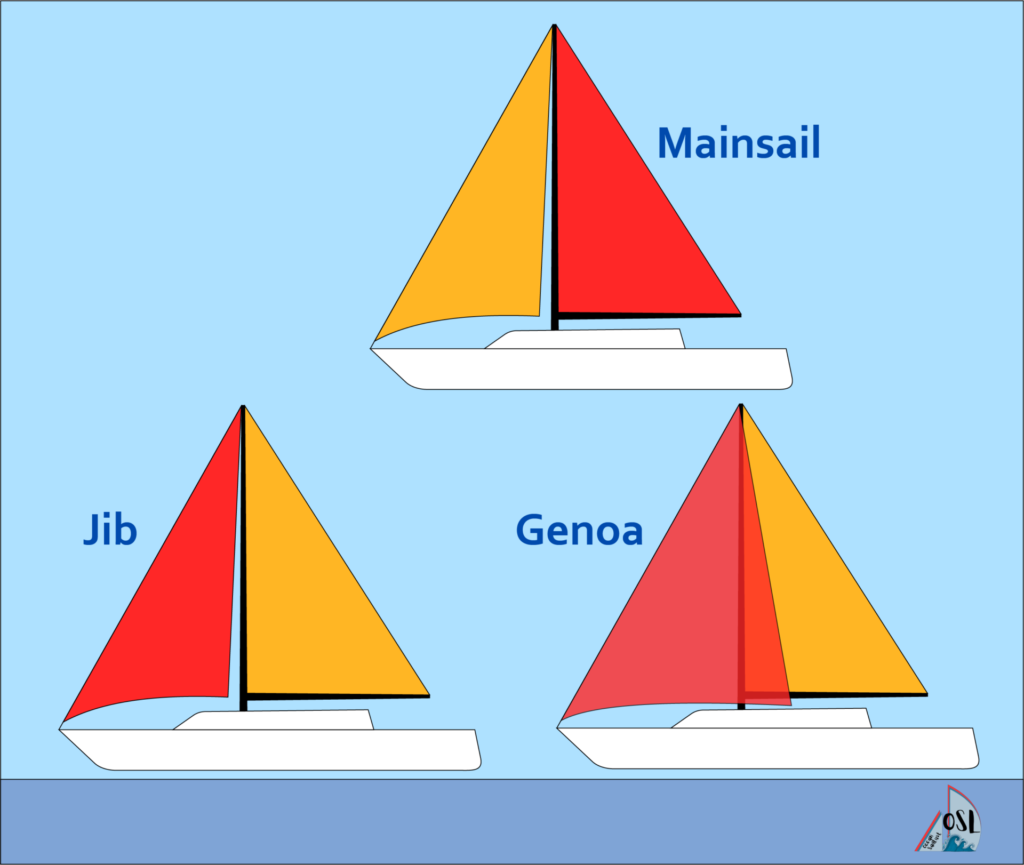
A headsail is any sail located forward of the mast on a sailing vessel. These sails are designed to work in conjunction with the main sail to provide optimal performance under varying wind conditions. There are several types of headsails available, each with its own unique characteristics and purposes.
One popular type of headsail is known as a genoa. This large foresail extends beyond the mast and overlaps with the main sail, providing additional power when sailing upwind or reaching across wind angles. Genoas come in various sizes ranging from 110% up to 150%, depending on how much overlap you want.
Another common type of headsail is called a jib. This smaller foresail does not overlap with the main sail but instead works in conjunction with it. The jib is typically used in higher wind conditions when a smaller sail area is needed to maintain control of the boat.
A staysail is a smaller sail located between the mast and the forestay. This type of headsail is typically used on larger boats to provide additional power when sailing upwind or reaching across wind angles. Staysails are often used in conjunction with other sails, such as a genoa or main sail.
Finally, there is also a mizzensail, which is located aft of the main mast on ketches and yawls. This sail provides additional power when sailing downwind or reaching across wind angles. Mizzensails come in various sizes and can be either fully battened or free-flying.
Lightwind Sails
Spinnaker sails are a type of downwind sail that can be used to increase boat speed when sailing in light winds. They are typically used in wind conditions below 10 knots, which are considered light air sails. Spinnakers come in two types: symmetrical and asymmetrical.

Symmetrical vs Asymmetrical Spinnaker
The symmetrical spinnaker is designed to sail directly downwind or with the wind coming from behind the boat. It is shaped like a balloon, with equal amounts of material on both sides of the sail. The sail is attached to a spinnaker pole, which extends out from the mast and holds the sail away from the boat.
Asymmetrical spinnakers, on the other hand, are designed for sailing at angles off the wind. They have an uneven shape, with more material on one side than the other. This design allows them to be flown without a spinnaker pole, making them easier to handle for smaller crews.
Another type of downwind sail is called a gennaker. Gennakers are similar to asymmetrical spinnakers but have a hybrid characteristic between a spinnaker and a genua. They are designed for reaching or running downwind at higher speeds than traditional cruising chutes or asymmetric spinnakers.
For those who prefer an even more user-friendly option than asymmetrical spinnakers or gennakers, parasailors might be what you’re looking for! A parasailor combines aspects of both a traditional spinnaker and a parachute into one easy-to-use package. The unique design of this sail makes it ideal for use in light winds when other sails may not perform well enough.
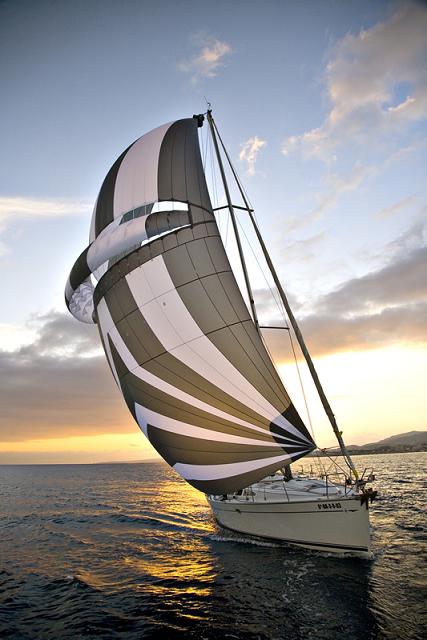
Finally, there’s another type of upwind/downwind sail called the code zero. Code zeros are designed to be used in light winds when sailing upwind, but they can also be used for reaching and running downwind. These sails have a flat shape that allows them to generate lift even in very light wind conditions.
Heavy Weather Sails
Heavy weather sailing is a challenging and potentially dangerous activity. The use of heavy weather sails, such as trysails, is crucial to ensure the safety of sailors and their vessels.
A trysail is a small triangular sail made of heavy-duty material, typically spinnaker cloth or other lightweight fabric. It is designed to be used in stormy weather conditions when winds are high and the seas are rough.
The role of a trysail is to provide an alternative source of propulsion when the main sail or jib cannot be used. In addition, it helps reduce the heeling effect on the vessel caused by strong winds. Trysails are rigged using a separate halyard and can be set up quickly when needed.
A trysail should be used in severe weather conditions when winds exceed 40 knots or more. It is recommended that sailors practice setting up their trysail before they need it so that they can do it quickly and efficiently in an emergency situation.

Another type of heavy weather sail that every sailor should have on board is a storm jib. This sail is typically much smaller than a regular jib and made from heavier materials such as Dacron or nylon. Its purpose is to provide additional stability during high wind speeds and rough seas.
The features of a storm jib include its size, shape, and weight distribution. It has a large luff (the leading edge) which allows it to be hoisted higher up on the rigging than other sails. This helps keep the boat stable during high-speed sailing in strong winds.
A storm jib should be used in extreme weather conditions where wind speeds exceed 50 knots or more. When using this sail, it is important to ensure that the halyard is properly tensioned and that the sail is sheeted in tightly. This will help prevent any unnecessary movement or fluttering of the sail.
Overview Common Sail Types
100% of mainsail
Light – High
100% of foretriangle
Moderate – High
triangular, overlapping
110% – 150% of foretriangle
Light – Moderate
60% – 80% of foretriangle
Close Reach – Broad Reach
Lightwind, Downwind
balloon shape, free flying
200% of mainsail (or even more)
Broad Reach, Running
parachute shape
100% of spinnaker
80% – 85% of spinnaker
Lightwind, Upwind
75% of spinnaker
30% – 60% of mainsail
Mainsail, heavy weather
17.5% of mainsail (or less)
Headsail, heavy weather
max. 65% of the hight of the foretriangle
Unconventional Sails
Wing sails are a type of sail design that is not commonly used in traditional sailboat designs. They are essentially vertical airfoils that generate lift and propulsion by directing the wind over the surface of the sail. Wing sails have become increasingly popular in modern sailing craft, particularly in high-performance racing boats.
One of the main advantages of wing sails is their ability to produce a significant amount of power with very little heeling force. This means that they can be used effectively in high-wind conditions without causing the boat to tip over. Additionally, wing sails are highly efficient at sailing upwind, which allows sailors to point higher into the wind than with other types of sails.
While wing sails may seem like a relatively new concept, they have actually been around for quite some time. The first recorded use of a wing sail was by German engineer Wolfgang Zimmermann in 1959. Since then, many different variations on the design have been developed and tested.

Kite sails are another unconventional type of sail that has gained popularity in recent years. Unlike traditional downwind sails such as spinnaker or parasailors, kite sails are flown from a line attached to the bow of the boat and do not require a mast or boom.
Sail Materials and Technology
Traditional sail materials.
Sails have been used for thousands of years to harness the power of the wind and propel boats across water. Traditional sail materials were flax, hemp, or cotton. These natural fibers were woven together to create a strong, yet flexible material that could withstand the harsh conditions at sea. However, as technology advanced and sailors began to demand more from their sails, new materials were developed.
Modern Sail Materials
Modern sailboats use synthetic materials such as polyester, nylon, or laminated fabrics for their sails. These materials are lightweight and incredibly strong, allowing sailors to achieve greater speeds with less effort. They are also more durable than traditional sail materials and can withstand prolonged exposure to sunlight and saltwater.
Popular Sail and Mast Configurations

The sloop rig is one of the most popular sail plans for modern sailboats. It features a single mast and one headsail, like a jib or genoa. The mainsail is typically triangular in shape and hoisted up the main mast using a backstay to support it. The jib or genoa is attached to the forestay that runs from the top of the mast to the bow of the boat.
Another popular sail plan is the cutter rig, which also features a single mast but has two headsails – an overlapping jib and a smaller staysail. The mainsail is still triangular in shape and hoisted up the main mast with a backstay for support.
Moving onto two-masted rigs, we have ketch rig, which features a main mast and a shorter mizzen mast located in front of the rudder. The mainsail is still triangular in shape and hoisted up the main mast with a backstay for support, while the mizzen sail is generally smaller and triangular or quadrilateral in shape.
Lastly, we have the yawl rig which is similar to the ketch rig but has its shorter mizzenmast located aft of the rudder. The mainsail is still triangular in shape and hoisted up the main mast with a backstay for support, while the mizzen sail is generally smaller and triangular or quadrilateral in shape.
Conclusion: Understanding the Different Types of Sails
Understanding the Different Types of Sails is crucial for any sailor who wants to optimize their performance and safety on the water. Whether you’re racing, cruising or simply enjoying a day out on your sailboat, having the right sails for the conditions can make all the difference.
Ultimately, understanding the different types of sails is essential for any sailor looking to improve their skills on the water. By selecting the right sail for your boat and conditions, you can optimize your performance while staying safe and comfortable during your time at sea.
So whether you’re a seasoned sailor or just starting out, take some time to explore the various types of sails available and find the ones that work best for you. With a little knowledge and experience under your belt, you’ll be well on your way to mastering this exciting sport!
Similar Posts
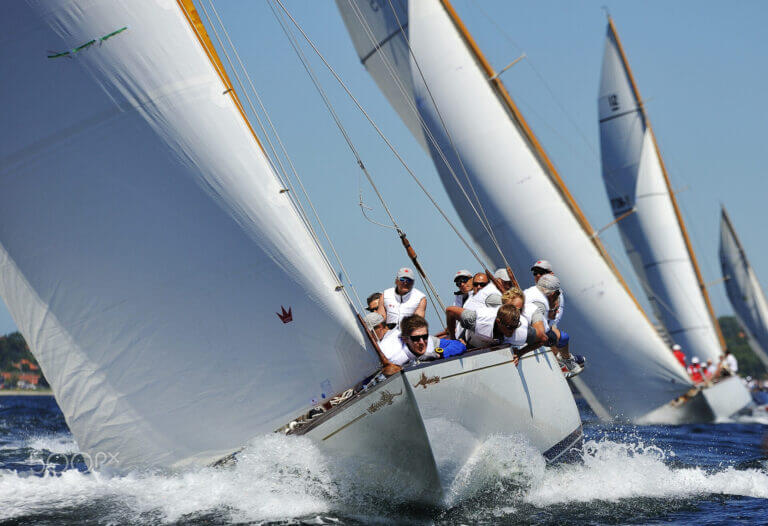
How Much Does Biofouling Slows Down your Boat?
Are you wondering how much biofouling can impact the performance of your sailboat? The amount of how much biofouling slows down a sailboat depends on various factors, such as the type of boat, its size, and the severity of the biofouling. On average, a sailboat with a heavily fouled hull can experience a reduction in…
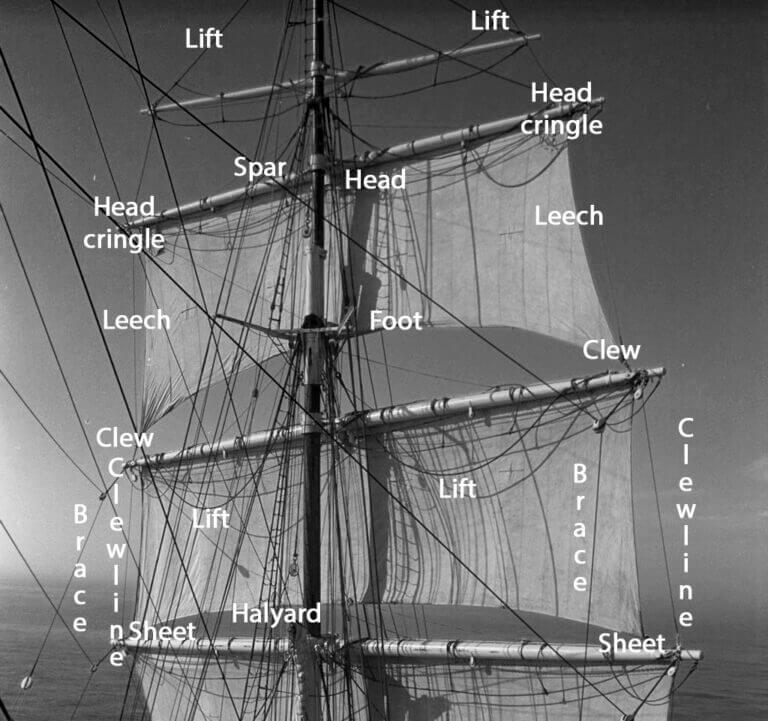
Whats the Difference between Standing Rigging and Running Rigging?
Running rigging refers to the movable lines and ropes used to control the position and shape of the sails on a sailboat. Standing rigging, on the other hand, refers to the fixed wires and cables that support the mast and keep it upright. As the sun rises on another day, we find ourselves immersed in…

Basic Sailing Terminology: Sailboat Parts Explained
Sailing is a timeless activity that has captivated the hearts of adventurous souls for centuries. But, let’s face it, for beginners, sailing can be as intimidating as trying to navigate through a dark, labyrinthine maze with a blindfold on. The vast array of sailing terminology, sailboat parts and jargon can seem like a foreign language…

What is a Keel?: The Backbone of a Ship
As ships sail through tumultuous seas, their stability and maneuverability are tested to the fullest extent. The intricate design and engineering that go into a ship’s construction ensure that it can withstand the forces of nature and navigate through any challenging conditions. One of the most critical components of a ship’s design is the keel,…

How Does a Marine Toilet Work?
Have you ever wondered how a marine toilet works? If you’re planning to embark on a boating adventure or just curious about the mechanism of a marine toilet, this article is for you. Marine toilets work similarly to the ones on land with a bowl, a seat, and a flushing mechanism that uses water. However,…

How do Boats Float? Exploring the Science Behind Buoyancy
Sailboats float because the average density of the boat is less than the density of water. When boats displace as much water as it weights, this is known as the buoyancy force generated by Archimedes’ principle. If you’ve ever wondered how do boats float and therefor enable us to embark on thrilling water adventures, you’ve…
No products in the cart.
Sailing Ellidah is supported by our readers. Buying through our links may earn us an affiliate commission at no extra cost to you.
The Most Popular Types Of Sails On A Sailboat
A sloop-rigged sailboat typically features a mainsail, a headsail, and an additional light-wind sail, such as a spinnaker or Gennaker. The mainsail is rigged aft of the mast, while the headsail is attached to the forestay. The two most commonly used headsails are the Genoa and Jib.
The sails are vital parts of a sailboat since you obviously couldn’t sail without them! There are many different sails depending on the type of sailboat and its rig configuration, and we’ll walk through them together in this article.
The different types of sails on a sailboat
We can divide the selection of sails on a sailboat into three categories:
- Standard sails
Light-wind sails
- Storm sails
Each category serves different purposes depending on the vessel’s rig configuration and the sail’s functionality.
The standard sails
The standard sails usually form a sailboat’s basic sail plan and include :
- The Mainsail
- The Staysail
- The Mizzen sail
These sails are the ones that are used most frequently on sloop, ketch, and cutter-rigged sailboats and are usually set up to be ready to use quickly.
Headsails are often rolled up on a furler, while the main and mizzen sail are stored on the boom or furled into the mast.
The halyards and sheets are kept within easy reach, making these sails the primary choice in most situations. Let’s dive further into each of them.
The mainsail is a triangular sail that flies behind the mast on top of the boom . Although it may not always be the largest sail on the vessel, we commonly refer to it as “the main.”
It is a vital sail, and keeping the sail shape trimmed properly on every point of sail is crucial for the stability and performance of the boat.
A Jib sail is a headsail that does not overlap the mainsail. It is typically between 100% and 115% of the foretriangle but can also be smaller. The foretriangle is the triangular area formed by the mast, deck, and forestay. The Jib is often used with a self-tacking system involving a sheet traveler in front of the mast.
This sail is often seen on newer boats with fractional rigs, which typically have a larger mainsail area than the headsail area. However, the Jib is versatile and also used in other configurations.
People often mix the terms Genoa and Jib. Many refer to any headsail as a Jib, which is incorrect. I personally prefer to use the correct terms to avoid confusion .
A Genoa sail resembles a large Jib but extends past the mast and overlaps the mainsail. Genoas are usually larger than 115% of the foretriangle , with sizes ranging from 120% to 150%. They are often used on vessels with masthead rigs and smaller mainsails but are also common on fractional rigs.
The Staysail is typically found on cutter rigs and is set on the inner forestay or cutter stay. It can be combined with other sails, such as a Jib, Genoa, or Yankee, or on its own in stronger winds.
The Staysail is also useful when sailing downwind, as it can be paired with a headsail and extended to opposite sides of the boat using a pole.
The Yankee sail resembles a Genoa and Jib but has a high-cut clew. This shape allows for improved airflow when used with another headsail. The Yankee is often used on cutter-rigged boats in combination with a staysail and is known for its versatility in different wind conditions.
Mizzen Sail
A mizzen sail is similar to the mainsail, only smaller . It is set on the aft mast of a boat with multiple masts, such as a ketch rig. The mizzen sail is usually used to provide balance and stability to the vessel and provides additional power when sailing downwind.
Another handy usage is to fly the mizzen at anchor to keep the bow up against waves and swell.
The light-wind sails are large, made of thin nylon, and typically shaped like a half-balloon. They are a type of headsails that are great when the winds are too light to fill the standard headsail and are often used when sailing downwind.
The four most commonly used light-wind sails are:
- The Spinnaker
- The Gennaker
- The Code Zero
- The Parasailor
They all provide excellent forward propulsion on a sailboat but usually require some extra rigging to be set.
Experienced cruisers love to use light-wind sails in nice weather, but they have a critical weakness to be aware of. These sails easily get overpowered when the wind increases, and I strongly advise being careful and observant of the wind conditions when flying them.
(Yes, I have managed to rip mine on one occasion due to getting overpowered, but that’s a different story…)
Let’s continue and take a closer look at each of the light wind sails.
A Spinnaker sail is a large, lightweight downwind sail used at deep angles between 120 and 180 degrees. It is symmetrical in shape with two clews and is often brightly colored.
The Spinnaker is set by using a pole to extend the sail’s clew to the vessel’s side. Then, a sheet is attached to the other clew and led back to the stern of the boat.
A Gennaker sail combines the characteristics of the Genoa and Spinnaker. It is made of nylon like the Spinnaker but is asymmetrical like a Genoa and rigged slightly differently. The tack is attached to the bow, and the clew has a sheet led aft to the cockpit. The Gennaker can be equipped with a snuffer to make it even easier to set up and take down.
It is popular among cruisers because it is simpler to use than a spinnaker and it doesn’t require a pole. The sail is effective at angles between 90 degrees and almost all the way down to 180 degrees, making it versatile for various light-wind conditions.
A Parasailor is similar to the Spinnaker in many aspects but has some distinct differences. It has a double-layer wing that inflates as the sail is filled with air, creating a batten-like effect pushing the leech out while providing lift to the bow.
The wing also helps to prevent the rolling movements you get with a Spinnaker and the collapsing of the leech that can occur with a Gennaker at deep angles.
This makes the parasailor effective at sailing angles between 70 and 180 degrees dead downwind. Parasailors can be set like a Gennaker when reaching or with a pole like the Spinnaker for running downwind.
A Code Zero sail combines some elements of the Genoa and Gennaker. Unlike the Gennaker, the Code Zero has a different shape, allowing it to be used while sailing upwind.
Another benefit is that it can be used with a furler which makes it easy to roll in and out. However, it can’t replace the Gennaker or Spinnaker entirely, as it is not effective at sailing angles deeper than 120 degrees.
If you see a big yacht with three forestay’s, the forward one probably holds a code zero sail. A bow spirit allows the ability to fly additional light wind sails as well!
Storm Sails
The storm sails consist of a small Mainsail and Jib in heavy-duty materials designed for rough conditions. These sails enable us to maintain speed and stability in the boat in severe weather too strong for the standard sails.
Storm sails are often brightly colored , such as red, orange, or yellow, to make them more visible at sea.
Storm Mainsail
A storm mainsail is used when the reefing setup doesn’t allow the standard mainsail area to be reduced enough to prevent overpowering. The sail can handle rough conditions and is excellent for maintaining stability.
A storm Jib is used when the headsail has been furled to the point where it is no longer effective. It is especially useful for sailboats rigged with a Genoa, as the Genoa gets inefficient when heavily reefed. As the storm Jib is smaller than the standard headsail, it also lowers the center of gravity, making the vessel heel less and become more stable.
Explaining the terms for the parts of a sail
Let us talk some more about sails. The goal is to go sailing, right?
Identifying the different parts of the sails is crucial to understanding which lines go where.
Let’s zoom in on a sail and break down the terms :
The head is the top corner of the sail . Most mainsails have a headboard or plate where the halyard is connected, while headsails use a metal ring. A halyard is a line we use to raise and lower sails with.
The leech is the aft part of a sail , located between the clew and head. We use a combination of the outhaul, main sheet, and traveler to trim and adjust the leech on the mainsail.
The headsail’s leech is trimmed by adjusting sheet tension and angle according to the wind speed and direction. A traveler is a track with a movable car or pulley system for adjusting the position and angle of a sheet, and most sailboats have one main traveler for the mainsail and car tracks along the side decks for the headsail.
The luff of a sail is the front part of the sail between the tack and head. On a mainsail, the luff runs vertically along the mast and along or close to the forestay on a headsail. Headsails are often equipped with luff foam to help maintain their shape when partially reefed on a furler.
Battens are slats or tubes inserted into pockets on the mainsail to help the sail maintain its shape and increase its lifespan . A traditional sail hoisted and lowered on the boom typically has horizontal battens. Vessels with in-mast furling can use vertical battens instead of horizontal ones.
- A fully battened Mainsail has the battens run through the entire sail length from the luff to the leech.
- A standard battened main sail has the battens along the sail’s leech.
Telltales are small ropes, bands, or flags attached to a sail to give an indication of the airflow around the sail. They help us understand how the wind affects the sail and allow us to fine-tune the trim for optimal performance. Telltales are usually found on the mainsail’s leech and in the front of the headsail’s leech.
The clew of a sail is the lower aft corner and where the outhaul is connected on a mainsail. Headsails have sheets attached to their clew for controlling and trimming the shape and tension.
The tack is the lower, forward corner of a sail. On a traditional Mainsail, the tack is attached to the Gooseneck, a hinge in front of the boom attached to the mast.
With in-mast furling, the tack is connected to the furling mechanism. This mechanism is used to roll the sail into the mast.
The headsails tack is connected to a furler drum on the forestay on most sailboats. Vessels using traditional hank-on headsails connect the tack to a fixed point on the bow.
The foot of the mainsail is the bottom portion of the sail between the clew and the tack. It is trimmed using the outhaul, a line attached to the clew, and used to adjust the tension on the foot of the sail. Some mainsail are configured loose-footed, and others are attach-footed.
The foot of the headsail is trimmed by adjusting the tension and angle of the sheets, which are the lines used to control the headsail’s clew. We use cars, or pulleys, to adjust the angle of the sheets and thus the trim of the headsail.
Traditional and less commonly seen sails
We’ve now looked at the most commonly used sails and walked through the different parts of them. But what about the less common ones? The art of sailing has a rich history, with some unique sail designs that we rarely see today.
Read on if you want to peek into some traditional sails, or skip straight to popular sail and mast configurations here.
Square sails
Square sails are rectangular and usually set across a ship’s mast, mostly seen on traditional square-rigged sailing ships and Viking ships. These sails are efficient for downwind sailing and are hung from horizontal spars called yards. Though not as agile as modern fore-and-aft sails when sailing upwind, they were central to naval exploration for centuries. Today, they’re mainly seen on traditional vessels and tall ships, symbolizing maritime heritage.
If you’ve been to Martinique in the summer, you may also have noticed the round skiff sailboats the local fishermen traditionally used for fishing in the Atlantic Ocean with their distinctive big squared sails. Tour de Martinique des Yoles Rondes is a popular yearly event where the locals race and show off these beautiful old boats with colorful sails!
A gaff sail is a traditional four-sided sail held up by a horizontal spar called the “gaff.” They are used on classic gaff-rigged sailboats and allow for a larger sail area with a shorter mast. Gaff-rigged boats were traditionally popular and usually carried 25% more sail area than the equivalent Bermudan rig, making them fast on a downwind run. The Gaff rig could also carry a topsail between the gaff and the mast.
However, they don’t sail well to windward, and modern designs have shifted towards triangular sails for better upwind performance.
Jib-headed topsail
The Jib-headed topsail is a small triangular sail used on gaff rigs and is set between the gaff and the top of the mast.
A lug sail is an angled, four-sided sail that attaches at a point on its top side, making it hang tilted. The sail is simple to use and often found on smaller or older boats. There are different types, like standing, dipping, and balance lugs, each hanging differently around the mast.
The lug sail evolved from the square sail to improve how close the vessels could sail into the wind. Because of their upwind performance, fishermen used them widely in Europe from the seventeenth through the nineteenth centuries.
Sprit sails
The spritsail, with its unique four-sided design, stands out thanks to a diagonal support called the “sprit.” It was traditionally popular in Thames sailing barges due to its ability to accommodate high-deck cargo. These days, it’s primarily found in smaller boats like the Optimist dinghy in a variant called “leg of mutton spritsail.”
The spritsail was also used in traditional wooden boats like the fearing version of the Oselvar wooden boat traditionally used in western Norway.
It is also commonly used by the indigenous Guna Yala tribes in Panama in their dugout Ulu’s up to this day. We saw plenty of them when we cruised along the coast, and some of them approached us to sell us their delicious catch of the day!
Lateen sails
A lateen sail is a triangular sail set on a long spar angled on the mast. It was originally popular in the Mediterranean and on Arab shows, and its design enhanced maneuverability and played a crucial role in historic sea exploration.
The lateen sail was used on lateen rigs, the predecessor to the Bermuda rig – one of today’s most commonly used rigs!
Which brings us to the following topic:
Popular sail and mast configurations
There are many different rigs and sail configurations between sailing vessels. From the old-school square rigs to schooners, gaff rigs, and more. However, this article will focus on the three most popular rigs seen on modern sailboats:
- The Bermuda Sloop Rig
- The Cutter Rig
- The Ketch Rig
The three rigs have similarities and differences between their sail and mast configurations. We’ll walk through each of them to understand how they utilize their different types of sail.
If you want to learn more about other rigs, take a look here .
Bermuda Sloop Rig
The Bermuda sloop rig is the most common rig on modern vessels. It is characterized by a single mast, a triangular mainsail, and a headsail. This rig is named after the Bermuda Islands, where it was developed in the 17th century.
Some of the key features of the Bermuda sloop rig:
- The mast is typically tall and raked, which allows for a large sail area and excellent stabilit y.
- The mainsail is attached to the mast and boom. It is usually combined with a single headsail at the front of the boat, making it powerful and easy to sail.
- The Sloop is usually equipped with a masthead or fractional rig and flies a Jib or Genoa as its primary headsail.
The Bermuda Sloop rig is known for its simplicity, is often used for racing and cruising, and is popular among sailors worldwide.
The cutter rig is very similar to the sloop rig. The significant difference is that it has a single mast and two headsails – a Staysail and a Yankee. The cutter rig is known for its versatility due to the multiple options in sail plans and the double headsail setup.
Some key aspects that separate the Cutter from the Sloop:
- The rig is often more robust than its Sloop sister because of the additional cutter stay and running backstays.
- The mast is located closer to the center of the boat.
- The Cutter has a staysail on the inner forestay and a Yankee sail on the outer. The sails can be used in combination with each other or independently.
- Tacking the headsail between the forestay and cutter stay is more involved than on a sloop.
- The Cutter rig has two similar variations: the Slutter rig and the Solent rig.
Like the Sloop, the Cutter rig is relatively easy to operate. Still, the additional headsail and rigging make it costlier to maintain. It is also less suitable for racing than the Sloop, but the added versatility helps in different weather conditions and makes it an excellent choice for cruisers.
The ketch rig is also similar to the Sloop but has an additional mizzen mast placed further aft of the main mast. Another mast gives it the advantage of even higher versatility in sail plans. The ketch typically uses three sails. The mizzen sail, a mainsail, and a headsail. The mizzen mast also allows it to fly a second light-wind sail.
Here are a few more distinctions of the ketch rig:
- The ketch typically carries a smaller mainsail than a similarly sized sloop and a smaller mizzen sail.
- A small mizzen and a medium mainsail are easier to handle than one large mainsail.
- The additional mizzen sail makes the vessel easy to balance and gives extra stability downwind.
- The ketch usually doesn’t point as close to the wind as the Sloop and Cutter.
The headsail setup on a ketch is generally the same as for the Sloop. But the ketch can also be rigged as a cutter ketch, which gives it the benefits of the cutter rig! The tradeoff with a cutter-rigged ketch is the higher complexity and additional rigging, hardware, and sails required.
Final words
Well done, you now have a good grasp of the most common sails and their strengths. We have discussed a few rigs and how they utilize different kinds of sails in various sail plans. Remember that more sail types, other rigs, and even more variations are available. It is a complex topic, but this guide covers the basics and gives you a great starting point.
If you still have questions, look below at the FAQ, or leave me a comment. I’m more than happy to help you out!
A sailboat is only as good as its sails, and sails need wind to work. The next logical step is learning how the wind works when we sail and practicing some wind awareness! Head to the following guide to continue your research: Learn The Difference Between True And Apparent Wind Speed.
FAQ: The Different Types of Sails On A Sailboat
What is the foretriangle on a sailboat.
The foretriangle on a sailboat refers to the triangular area formed between the mast, forestay, and deck. If you want to order a new headsail, for example, you’ll have to measure and supply the sailmaker with these details.
What is the difference between a loose-footed and attached-footed mainsail?
A loose-footed mainsail is attached to the boom only at its corners, leaving the rest of the sail’s bottom edge free. An attached-footed mainsail, on the other hand, is secured to the boom along its entire length. The main difference lies in how the bottom of the sail connects to the boom, with the loose-footed design offering more adjustability in the sail shape.
What is a high-cut clew on a sail?
A high-cut clew refers to the design of a foresail, such as a jib or genoa, where the back lower corner (the clew) is raised or “cut” higher above the deck compared to standard designs. This design allows for better visibility beneath the sail and makes it easier to sail over waves without the sail touching the water, which is especially beneficial for offshore or blue-water cruising. Very high-cut clews are commonly seen on yankee sails on cutter-rigged sailboats.
What is luff foam on a sail?
Luff foam is a padded strip sewn into the forward edge of roller furling sails. It ensures the sail is appropriately shaped when partially rolled up, especially in strong winds. This foam not only helps with sail performance but also protects the sail when it’s furled.
What are the most common sails?
The sloop rig sailboat is the most common and usually features a mainsail, a headsail, and an additional light-wind sail, such as a spinnaker or Gennaker.
What are the different types of sails?
There are several different types of sails, and we can divide the most common into three categories:
The standard sails:
- Mizzen sail
The light-wind sails
The storm sails:
- Storm mainsail
- Storm jib
What is a spinnaker sail?
A Spinnaker sail is a large, lightweight downwind sail used at deep angles between 120 and 180 degrees.
What is a Jib sail?
A Jib sail is a headsail that does not overlap the mainsail and is set on the forestay. The Jib can also be set up with a self-tacking system, making it very effective when sailing into the wind.
Is Genoa sail the same as a jib?
People often mix the terms Genoa and Jib. The Genoa is different from a Jib sail as it is larger and overlaps the mainsail, whereas the Jib is smaller and does not overlap the mainsail.
What is a Genoa sail?
A Genoa is a headsail larger than the Jib extending past the mast and overlapping the mainsail. The advantage over the Jib is the larger sail area, making it more effective when sailing off the wind.
How many types of sail plans are there?
Sail plans refer to the configuration and arrangement of sails on a boat or ship. While there are countless customizations and variations, the three most common sail plans are:
Sloop: Characterized by a single mast, a triangular mainsail, and a headsail.
Cutter: Similar to a sloop but has a single mast and carries two or more headsails.
Ketch: Features two masts, with the aft mast (called the mizzen) shorter than the main mast.
What is a Mainsail?
The mainsail is a triangular sail that flies behind the mast on top of the boom.
What is a Gennaker?
A gennaker is basically an asymmetrical spinnaker. A hybrid sail that combines the characteristics of a Genoa and a Spinnaker, designed for sailing off the wind and often used in light to moderate wind conditions.
What is a Storm Jib?
A storm jib is a small, heavy-duty sail used in strong winds or stormy conditions. It is commonly used when the headsail has been furled to the point where it is no longer effective.
What factors determine the type of sail to be used?
The type of sail to be used depends on various factors such as wind conditions, points of sail, sailboat size , and sailing experience. It’s smart to choose the appropriate sail for optimal performance. A Jib, for example, will be more effective than a Genoa while sailing to windward, and vice versa.
How do sails affect the performance of a sailboat?
Sails are the engine of a sailboat. Their design, size, and trim influence the boat’s speed, direction, and stability. Properly adjusted sails capture wind efficiently, allowing the boat to move faster and in the desired direction.
The balance and condition of the sails also impact comfort and safety, with well-maintained sails ensuring optimal performance. The sails are essential in determining how a sailboat performs in various wind conditions.
Sharing is caring!
Skipper, Electrician and ROV Pilot
Robin is the founder and owner of Sailing Ellidah and has been living on his sailboat since 2019. He is currently on a journey to sail around the world and is passionate about writing his story and helpful content to inspire others who share his interest in sailing.
Your article gave me a lot of inspiration, I hope you can explain your point of view in more detail, because I have some doubts, thank you.
What specifically do you want my point of view on?
Leave a Reply Cancel reply
Your email address will not be published. Required fields are marked *

Most Popular Types of Sails on a Sailboat
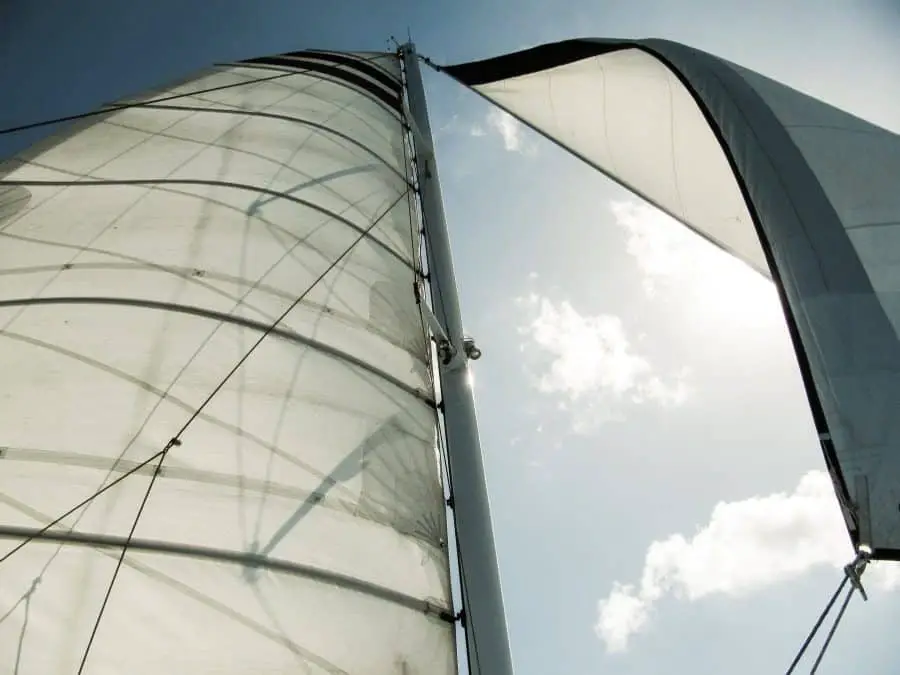
Learning about how there were different types of sails on sailboats for me was a bit strange at first. I thought something along the lines of “Don’t you just need to put some fabric on some polls and grab the wind?” Obviously, there’s far more to it than that.
So what are the most popular types of sails on sailboats? The mainsail, headsail (or jib), genoa, spinnaker, and gennaker are the most popular types of sails on sailboats. There are also a number of different configurations when considering the type of sail and mast in use including a sloop, fractional rig sloop, cutter, ketch, schooner, yawl, and cat.
Simply put, different sailboat sails serve different purposes when out on the water.
The sail is kind of like the “engine” of your sailboat (of course, sailboats can have actual engines) in that it’s the main source of forward propulsion.
So, it’s important to know when best to use either type of sail and why including the many different names of sails on a ship.

Types of Sails
There are a number of reasons why you’d want to use one sail over another, but the most important points to consider have to do with the point of sail you’re sailing in and the wind strength.
Maybe you need downwind sails, square sails, or a triangular sail. Maybe a unique sail shape, sail cloth, or sail area. With that in mind, let’s check out the different sail types!
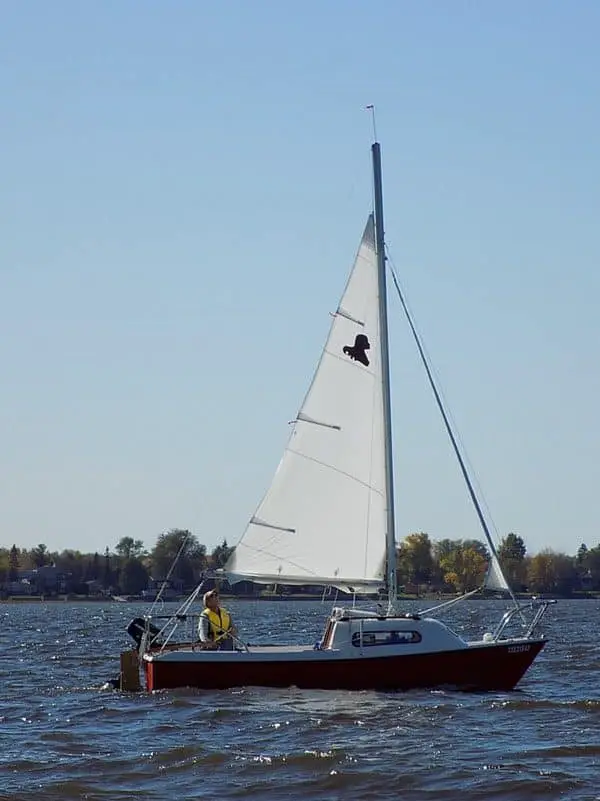
The mainsail is by far the most popular type of sail on sailboats and is often the first image that comes to mind when thinking about a sailboat.
Mainsails are found behind the mast and attached to the boom, which makes it a common part of the sailboat to keep an eye on as it takes up a lot of real estate on a boat with sails especially during a sail tack.
Mainsails are able to cover a lot of surface area with respect to incoming winds, especially since they’re attached to the boom.
The fact that they have a large surface area means they don’t require very strong winds to provide good forward propulsion on a sailboat.
Also, since the position of the mainsail can be easily configured thanks to the boom, all points of sail are achievable.
Headsail/Jib

The headsail (or jib) is probably the second most popular type of sail on sailboats since it usually accompanies the mainsail.
The headsail is always placed at the front of the mast and can cover a good amount of the bow of the sailboat. It’s also smaller than a mainsail, making it more portable and easy to work with.
Headsails aren’t as big as mainsails, therefore they have a smaller surface area which results in the fact that they’re not capable of catching as much wind as a mainsail.
This is an important point though since if the current wind is exceptionally strong and your mainsail has been trimmed as much as possible, being able to put away your mainsail and depend on your headsail alone is an excellent strategy to reduce speed.
When the wind is just too strong to keep your mainsail out, putting it away and using only your headsail is a great option.
You won’t be grabbing as much wind as with the mainsail and you’ll be able to have a much more enjoyable (and safer!) sailing experience.
One of the most picturesque sailing images one can conjure up is the one with a sailboat using a genoa sail (see the image above on the right).
A genoa is a type of large jib that’s attached to the front of the forestay just like a headsail.
One of the main differences with the genoa sail is that it’s bigger than the normal headsail and oftentimes extends behind the mast partially or completely covering the mainsail. It actually used to be called an “overlapping jib”.
Using a genoa sail means you have light to medium winds and your sailboat is more or less in a dead run point of sail (wind coming directly from the rear or sailing downwind).
Since the surface area of a genoa sail is so large, it’s important only to use it when winds are relatively low. Otherwise, you’ll be moving exceptionally fast resulting in a potentially risky situation.
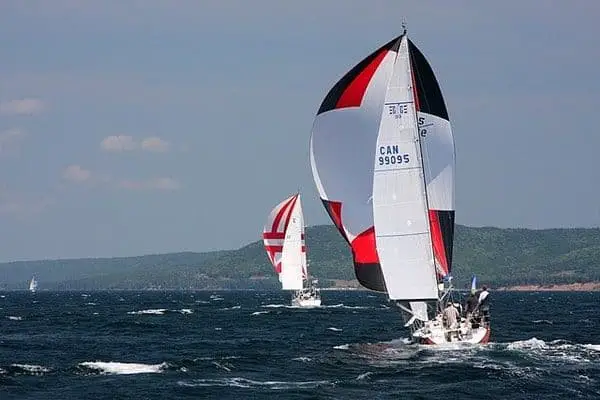
A spinnaker sail is a fun sail to use since it’s quite large, colorful, and can pick up a lot of wind.
Unlike a genoa sail, they’re often symmetrical making them more sensitive to the reaching points of sail and thus more appropriate for the running point of sail. They’re also lighter and have a “kite” kind of feel to them.
The reason they resemble a “kite” is not only that they’re generally lighter and more colorful than other types of jibs, but also they don’t cover the mast like a genoa sail.
Instead, they don’t attach to the forestay and stretch out toward and past the bow of a sailboat. Since they’re bigger than genoa sails, you want to be even more careful to only use them in relatively low and non-volatile wind environments.
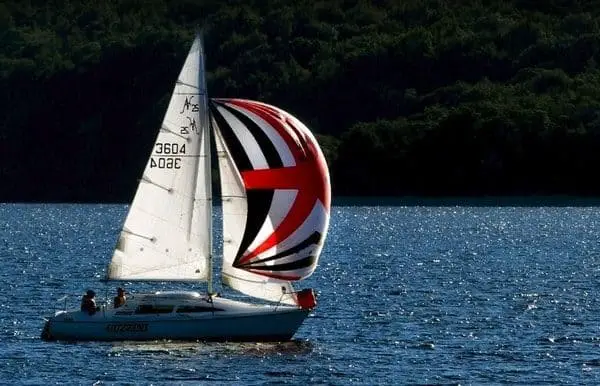
A gennaker sail is a more recent type of sail on sailboats since they were developed around 1990.
Gennakers are a cross between genoa and spinnaker sails (as the name might suggest), which are big like a spinnaker, aren’t as symmetric as a spinnaker, and aren’t attached to the forestay like a genoa sail or headsail.
The reason for the invention of the gennaker is that sailors wanted to take advantage of lighter winds without having to resort to using a spinnaker if the winds change from a pure dead run to more of a reaching point of sail.
All in all, the gennaker sail is able to bridge the performance gap between a genoa and spinnaker sail in terms of being able to take on a more flexible point of sail while taking advantage of relatively softer winds.
Popular Sail and Mast Configurations
Now that you’re familiar with the most popular types of sails on a sailboat, it’s good to get an idea of how these sail types relate to the configuration of a sailboat’s mast.
There are a huge number of combinations when it comes to sails and mast configurations, so I thought I’d lay out the most popular ones you’ll likely run into out on the water.
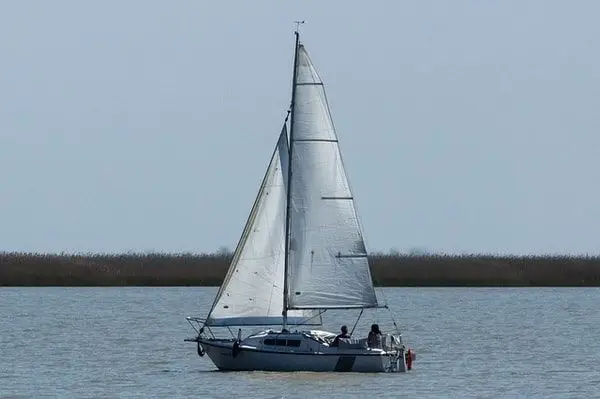
A sloop is the most common type of sail and mast configuration for sailboats. The sloop is the classic single mast, double sail setup.
The sails on a sloop consist of a mainsail and a headsail. The headsail can be different types of jibs, including the genoa, spinnaker, or gennaker sails. The headsail is connected to the forestay on the mast and runs all the way to the top of the mast.
Fractional Rig Sloop
Similar to a sloop, a fractional rig sloop has a single mast, double sail setup. The only difference, however, is that the forestay doesn’t reach the top of the mast, resulting in the headsail being restricted to a fractional amount of space a normal sloop would allow for.
This reduction of surface area for the headsail means that less wind can be captured and, thus, reduced sailboat speed.
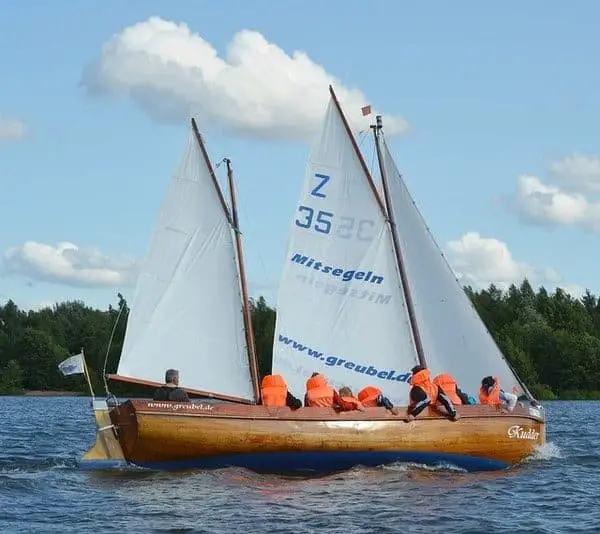
A cutter is an interesting setup since it’s just like the sloop and fractional rig sloop setup, but instead of one forestay it has two. With two forestays on the mast, cutters are able to house two headsails.
This can be a preferred setup because it allows for easy cruising due to it offering a diverse combination of points of sail for different strengths of wind.
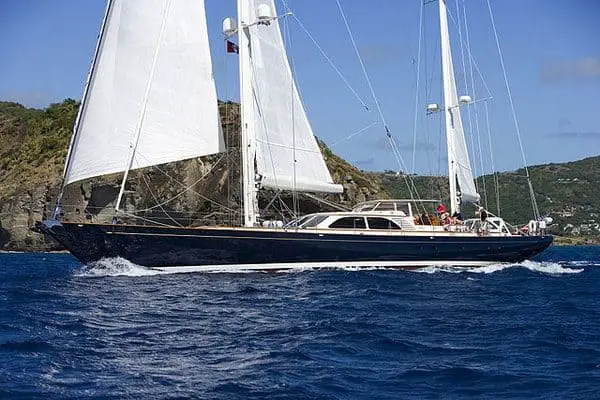
A ketch is a less common setup when compared to the previous setups since it has two masts.
Just like a sloop, it has a mast that allows for a mainsail and headsail with a full range forestay, but it also has a smaller sized mast between the mainmast and the stern of the sailboat.
This mast configuration was commonly used in Northern European freighter and fishing boats and is called the mizzen mast.
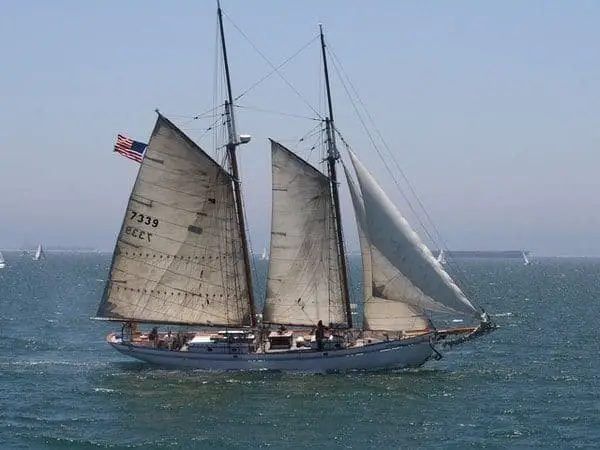
If you’ve ever seen Pirates of the Carribean, you’ll have seen almost nothing but schooners. A schooner is when a sailboat has two or more masts, similar to a ketch, while having a number of sails to manage.
The main differences between a ketch and a schooner are that a schooner’s aft mast (the rear mast) is taller than the forward mast and a schooner can have up to six masts some including a square sail or two. This makes names of sails on a schooner the fore and aft sail (or fore and aft rig).
A yawl is almost identical to a ketch with the only difference being that the mizzen mast is located directly behind the sailboat’s rudder post. In terms of a ketch vs yawl, the mizzen sail is also much smaller than the mizzen sail on a ketch due to its position on the sailboat.
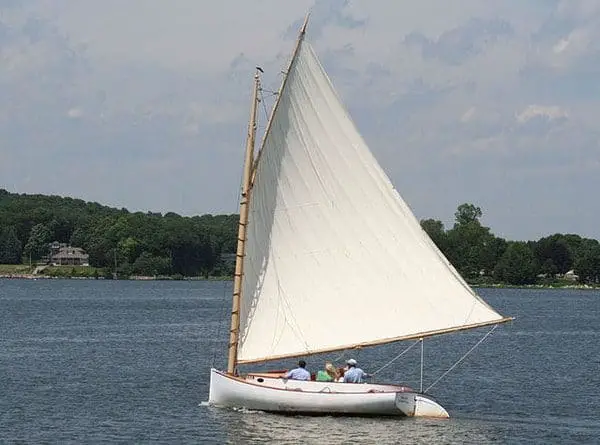
A cat has one mast and one sail with the mast being positioned at the bow of the sailboat. This mast configuration is most commonly found on smaller sailboats, especially dingy sailboats. These types of sailboats are colloquially called “catboats”.
Get the very best sailing stuff straight to your inbox
Nomadic sailing.
At Nomadic Sailing, we're all about helping the community learn all there is to know about sailing. From learning how to sail to popular and lesser-known destinations to essential sailing gear and more.
Quick Links
Business address.
1200 Fourth Street #1141 Key West, FL 33040 United States
Copyright © 2024 Nomadic Sailing. All rights reserved. Nomadic Sailing is a participant in the Amazon Services LLC Associates Program, an affiliate advertising program designed to provide a means to earn fees by linking to Amazon.com and affiliated sites.

Names of Sails on a Sailboat: A Comprehensive Guide
by Emma Sullivan | Jul 22, 2023 | Sailboat Racing

Short answer: Names of sails on a sailboat:
Sails on a sailboat are commonly referred to by various names, including the mainsail, jib, genoa, spinnaker, staysail, and mizzen. Each sail serves a specific purpose in harnessing wind power for propulsion.
Understanding the Basics: A Guide to the Names of Sails on a Sailboat
As you embark on your sailing adventure, it is crucial to familiarize yourself with the various parts and components of a sailboat. One essential element that plays a significant role in harnessing the wind’s power is sails. Sails can be compared to the engine of a vessel, propelling it forward gracefully through the water. To fully comprehend this integral aspect of sailing, we present this guide unraveling the names and purposes of different sails.
1. Mainsail: The mainsail is arguably one of the most vital sails on any sailboat. Positioned on the mast behind or beside it, this large triangular-shaped sail captures wind from straight ahead and turns it into forward momentum. Its position allows for effective control over direction due to its proximity to the centerline of the boat.
2. Headsail: Also known as foresail or jib, this sail is situated at the front (bow) part of most sailboats. Typically smaller in size than the mainsail, headsails come in several variants like genoa or jib/genaker. These versatile sails capture wind approaching from astern or slightly off-center, translating it into additional speed by working in conjunction with the mainsail.
3. Spinnaker: Known for its eye-catching colors and impressive size, spinnakers are designed specifically for downwind sailing when winds are coming directly from behind your vessel’s mainline heading toward 180 degrees opposite to your bow direction. As a powerful reaching sail, they help maximize speed while adding an aesthetic flair to your boat’s appearance.
4. Staysail: Often employed aboard larger vessels or heavier cruisers, staysails serve as useful additions in various wind conditions. Positioned between headstay and mast or bowsprit, these smaller triangular-shaped sails come into play during close-hauled points of sail when heightened maneuverability is required.
5. Storm Sails: No sailing guide would be complete without mentioning storm sails. As their name implies, they are specifically designed to withstand rough weather conditions and high winds usually experienced during storms. These small but mighty sails provide an essential means of maintaining control while keeping the rest of the boat safe.
6. Mizzen/Mizzen Staysail: Primarily found on ketches and yawls, mizzen refers to the third mast or sail positioned towards the rear of the vessel. This secondary mainsail can either be triangular or quadrilateral and plays a crucial role in balancing the boat’s overall sail plan.
Now that you have familiarized yourself with some primary sail terminology, it’s important to remember that customization options abound when it comes to your sailboat setup. Different boats will possess various combinations, modifications, and additions to improve performance in specific sailing conditions or personal preferences.
Armed with this knowledge, not only will you impress your fellow sailors with your understanding of proper nautical terminology, but you will also ensure a more successful sailing experience as you adapt to different wind angles and conditions. So next time you hit the open waters, take a moment to appreciate the beauty and intricacy behind those marvelous sails propelling you forward into exhilarating adventures ahead!
How to Identify and Navigate with Different Sail Names on a Sailboat
Sailboats are universally admired for their grace and elegance as they glide across the water, propelled solely by the power of the wind. With their towering masts and billowing sails, these vessels offer a unique experience for sailors both new and seasoned. However, for those unfamiliar with the various sail names used on sailboats, it can be a daunting task to understand how to identify and navigate with them effectively. In this blog post, we will delve into this fascinating world, providing you with detailed professional insights on how to decipher different sail names and make the most out of your sailing adventure.
Before delving into the specifics, it is essential to grasp the underlying principle behind different sail names. Sailboats typically employ multiple sails to harness the wind efficiently depending on its direction and strength. Each distinct type of sail possesses specific characteristics that enable sailors to navigate effectively in various conditions. By understanding these sails’ capabilities, you can optimize your boat’s performance regardless of whether you’re leisurely cruising or competing in regattas.
1. Mainsail: The mainsail is arguably the most recognizable sail on a sailboat as it is usually situated aft (at the back) of the mast. Its primary function is to provide propulsion and stability when sailing close-hauled or reaching (sailing at an angle to the wind). The mainsail predominately catches air from one side but can also incorporate battens (stiffeners) along its length if needed for additional rigidity.
2. Jib / Genoa: Located forward of the mast, near the bow section of a sailboat, jibs or genoas are smaller triangular-shaped sails that enable boats to catch crosswind efficiently when tacking (turning through or against the wind). These versatile sails drastically improve maneuverability by creating additional lift without sacrificing control over steering.
3. Spinnaker: The spinnaker is the flamboyant, brightly colored sail that often adds a touch of drama to sailboats gliding through the water. This sail is exclusively used when sailing downwind – with the wind coming from behind or abeam (sideways) – and excels in light to moderate winds. It provides significant boosting power by capturing the maximum amount of available air, propelling boats at thrilling speeds.
4. Storm Jib: As its name suggests, a storm jib comes into play during adverse weather conditions that require reduced sail area for safety purposes. Smaller in size than a regular jib, it enables sailors to maintain control and stability during high winds and rough seas, offering a secure option when facing challenging weather situations.
Now that we have familiarized ourselves with these different sail names let’s delve into some tips on how to navigate effectively using them:
– Close-hauled Sailing: To maximize your efficiency while sailing close-hauled (directly against the wind), it is crucial to trim your mainsail appropriately. By adjusting the sheet angle and tensioning both horizontally and vertically, you can attain the perfect balance between speed and power.
– Reaching / Broad Reach: When navigating at an angle to the wind on a reach or broad reach, deploying a powerful genoa or jib becomes essential as it helps generate additional lift while maintaining control over steering. Adjusting these sails’ position can optimize performance based on changing wind angles.
– Downwind Sailing: When sailing downwind, embracing the exhilarating use of a spinnaker can bring immense joy as your boat surges forward propelled by this colossal canvas of cloth. However, mastering spinnaker handling requires practice due to its sheer size and potential for accidental gybes (when your boom suddenly swings across).
– Stormy Weather Conditions: Prioritize safety above all else when facing severe storms by promptly replacing regular sails with storm jibs. These smaller, resilient sails are designed to withstand high winds and enable you to maintain control over your boat even in rough weather.
By familiarizing yourself with these sail names and their optimal usage, you can unlock your full sailing potential. Whether leisurely exploring serene waters or competing in exhilarating races, harnessing the power of different sails will elevate your experience on the open seas. So set sail, embrace the wind, and let the magic of sailboat navigation unfold before you!
Step-by-Step Explanation: Learning the Names of Sails on a Sailboat
Ahoy, fellow sailors and sailing enthusiasts! Today, we embark on a journey to demystify the world of sails. Whether you’re new to sailing or just looking to expand your nautical vocabulary, this step-by-step guide will leave you confident in conversing about sails with even the most seasoned sea dogs.
Step 1: The Mainsail – The Queen of the Sails
Let’s start with the grand dame of all sails – the mainsail. It is located at the back (aft) of the sailboat and is attached to the mast by halyards and controlled by multiple lines called sheets. The mainsail is typically triangular in shape and bears most of a sailboat’s propulsion force. As we unravel its intricacies, remember that understanding how it works sets the foundation for comprehending other sails.
Step 2: Discovering Headsails – Jib & Genoa
Now that we’ve gotten acquainted with our esteemed mainstay, let’s unfurl another essential player in our sail ensemble – headsails. Headsails are positioned nearer to the bow than the mainsail and come in two primary types: jibs and genoas.
The jib modestly complements our queen; it has a relatively small size and attaches directly to its own stay or forestay wire at its leading edge. Jibs aid maneuverability and provide additional power when combined with the mainsail for upwind sailing.
The genoa, on the other hand, deserves recognition as an exuberant cousin of jib sailedoes! It extends past half or more of a boat’s length – as big as it gets without entering spinnaker territory. Genoas are perfect for downwind voyages or when capturing every breath of wind necessary to propel us through light breezes.
Step 3: Welcome Aboard the Staysail
As we traverse our way toward the middle of the sailboat, we greet the humble yet mighty staysail. Positioned between the mainsail and mast, this triangular sail often resembles a smaller version of a jib. It is attached to its stay at the front and can be used in combination with other sails or flown alone when conditions call for it. Staysails offer enhanced stability during turbulent weather conditions, making them essential components of any sailor’s repertoire.
Step 4: The Mighty Spinnaker – Letting Creativity Soar!
Finally, let us reveal one of sailing’s showstoppers – the unruly and exhilarating spinnaker. This bold sail explores uncharted territories when it comes to design! Its exotic shape resembles a parachute, capturing every zephyr of wind from astern or to the side. While it requires expertise to master, once hoisted up using halyards and poles, it adds a touch of magic to any sailing voyage worthy of awe-inspiring photographs.
Step 5: Bonus Round: Auxiliary Sails & Specialty Sails
While we’ve acquainted ourselves with some main cast members, an honorable mention goes out to auxiliary sails that assist in specific situations. For instance, we have mizzens, gallants sails, or even flying jibs which are deployed on particular types of vessels or specialized racing yachts.
Conclusion:
Congratulations on navigating through this step-by-step learning experience about sail names on a sailboat! By understanding each component’s purpose – from the majestic mainsail to thrilling spinnakers – you’re now equipped with knowledge allowing you to converse confidently about all things sailing-related. So go forth and impress your fellow sailors with your newfound wit and wisdom as you embark on incredible voyages aboard magnificent sailboats!
Frequently Asked Questions about the Names of Sails on a Sailboat – Answered!
Introduction: The Names of Sails on a Sailboat – Unveiling the Mysteries
Have you ever found yourself staring out at the sea, watching sailboats glide gracefully through the waves and wondered about the intriguing names adorning their sails? If so, you’re not alone! Querying minds have pondered over these sail monikers for centuries. In this blog post, we aim to shed light on frequently asked questions surrounding the names of sails on a sailboat. Get ready to set sail into a world of nautical knowledge!
1. What is the Main Sail, and Why is it Called That?
The mainstay of every sailing vessel’s sail inventory is appropriately named the “main sail.” This massive piece of fabric catches the wind head-on, providing power and propulsion to move your boat forward. Its name originates from its primary nature – being central or “main” in size and function. So next time you spot an impressive main sail, remember that it plays a leading role in navigating the high seas!
2. A Jib Explained – What’s Behind its Strange Name?
Imagining sails fluttering with exotic names might evoke images of adventure and mystery. However, when it comes to jibs, there isn’t any secret code hidden within its title. The term “jib” simply references a smaller triangular-shaped foresail positioned forward of the mast. Don’t be fooled by its modest appearance; this nimble sail helps redirect airflow smoothly across other sails while enhancing maneuverability.
3. The Genoa – Is It All About Italian Flavor?
Ahoy there! Prepare to be transported to Italy as we explore one of sailing’s beloved companions – the genoa. Although synonymous with Italy’s picturesque coastlines and vibrant culture, this sail owes its name not to pasta or gondolas but rather an Italian seashore city called Genoa (Genova). This large jib-like headsail boasts significant surface area, amplifying a boat’s speed as if it were effortlessly dancing along the Italian Riviera.
4. What About Mainsail’s Smaller Cousin – The Mizzensail?
Brace yourselves, sailors! It’s time to delve into the world of lesser-known sails. Enter the mizzensail – a smaller sail located behind the mainmast and typically found on larger sailing vessels. This mysterious name originates from “mizzen,” which refers to a mast situated aft or nearer toward the stern of the vessel. While its name might sound peculiar, this auxiliary sail plays a crucial role in maintaining balance as it assists with steering and maneuvering capabilities.
5. Unveiling the Secrets Behind Spinnakers
Are you ready for a whirlwind adventure? Let’s set sail with one of sailing’s most captivating inventions – the spinnaker sail! This sizable, colorful parachute-like cousin of other sails is designed for downwind sailing exhilaration. With origins in both German and Dutch seafaring cultures, its name derives from “spinner,” meaning a spider hanging by its web or someone spinning something rapidly – reflecting both its expansive shape and speedy performance possibilities.
Conclusion: Sailboat Sails – Stories Unfolded!
As you gaze out at the majestic sight of sails fluttering in unison on a sailboat, don’t just admire their beauty; grasp their captivating stories too! From towering mainsails to spirited genoas and enigmatic spinnakers, these names now carry newfound meaning beyond their initial allure. So next time your curiosity is piqued by the names adorning these magnificent sails, remember our charming explanations that navigate through centuries of seafaring heritage!
Exploring the Significance and Functionality of Each Sail Name on a Sailboat
When it comes to sailing, each sail on a sailboat has its own significant role and functionality. These sails are carefully designed and strategically positioned to ensure optimal performance and control on the open water. In this blog post, we will take a closer look at the significance and functionality of each sail name on a sailboat, unraveling the intricate web of maritime engineering.
1. Mainsail: The mainsail, as the name suggests, is the primary sail on a sailboat. It is typically attached to the main mast vertically and plays a crucial role in steering and propulsion. Its size and shape can be adjusted using various rigging techniques to adapt to different wind conditions. A well-trimmed mainsail facilitates efficient forward movement through the wind.
2. Jib: Positioned towards the front of the boat, just ahead of the mast, is the jib. This triangular-shaped sail works in harmony with the mainsail, creating balance and stability by capturing air from both sides of the boat. The jib helps increase speed while reducing heeling (the leaning of a boat), allowing for better control in gusty winds.
3. Genoa: The genoa is similar to a jib but larger in size. It extends farther back along the mast, covering a larger area than a typical jib would. This primarily provides additional power when sailing downwind or reaching (sailing across/across/towards) off-wind directions.
4. Spinnaker: When it’s time to embrace pure downwind speed, there’s no friend like the spinnaker! This large balloon-shaped sail flies ahead of all other sails on light wind days or during downwind racing maneuvers such as gybing (changing direction). Its design allows it to capture maximum airflow from behind or adjacent to your course as you surf down waves and maintain momentum—a true adrenaline rush for any sailor!
5. Storm Sails: As seafarers, we must always be prepared for inclement weather. Storm sails, often made of heavy-duty and highly durable materials, are designed to withstand high winds and turbulent conditions. These small, compact sails are hoisted in place of the mainsail and jib to maintain control during storms or adverse weather situations.
6. Headsail/Roller-furling jib: Convenience comes into play with the headsail or roller-furling jib. This sail can be easily adjusted or furled (rolled) using a mechanical system integrated into the boat’s rigging. It allows for quick and efficient changes when transitioning between different wind strengths or directions without requiring significant crew effort.
Each sail on a sailboat holds its own significance in shaping the vessel’s performance, efficiency, and safety on the water. Understanding their functionality empowers sailors to make tactical decisions that maximize speed and minimize risk. From powering through headwinds with a well-trimmed mainsail to embracing spontaneity with a spinnaker on calm days, each sail name carries a purposeful role in the intricate dance between vessel and nature’s elements.
So next time you set foot on a sailboat, take notice of these sails’ names; they are far more than mere decorative pieces fluttering in the breeze – they are indispensable tools in the artistry of sailing!
Mastering the Language of Sailing: Unveiling the Secrets behind Names of Sails on a Sailboat
Welcome aboard, fellow sailing enthusiasts! Today, we embark on an exciting journey to unravel the secrets behind the names of sails on a sailboat. Sailing is not just a sport; it’s an art form that requires both skill and finesse. Much like language, sailing has its own unique vocabulary that speaks volumes about the majestic dance between wind and water. So, let’s set our sails high and dive into the nautical lexicon!
First, we encounter the mighty mainsail, often considered the backbone of any sailboat. This triangular masterpiece is attached to the mast at its luff or leading edge and stretches aft towards the stern. It holds immense power as it catches the wind head-on, propelling us forward like a bird in flight. Aptly named “mainsail” because it is indeed our main source of propulsion.
Next on our list is the genoa – a versatile and indispensable sail fit for open waters. Whether you’re cruising or racing, this large foresail takes center stage with its dominant presence in front of the mast. Its name derives from Genoa in Italy where sailors first began using this powerful headsail. Eager to embrace any challenge thrown its way, the genoa wraps itself around any adventure with unwavering determination.
Now, let’s tack towards lighter winds where we discover a hidden gem called the spinnaker. As gentle zephyrs caress your boat’s hull, this vibrant sail leaps to life like a rainbow unfurling in slow motion. Shaped like an enormous balloon with a mouth-watering variety of colors at its disposal, it adorns our vessel during downwind courses or when breeze gets too light for other sails to catch hold. The name “spinnaker” arises from its unique ability to spin outwards from regular racing sails; truly a breathtaking spectacle that turns heads everywhere we go.
Ahoy there! Look up towards your tallest mast and you might spot a triangular sail defying gravity – the topsail. Historically, this sail served as an additional square-rigged sail above the lower sails back in the days of tall ships. Nowadays, it has shrunk in size but gained prominence as a brilliant display of seamanship. The topsail is often hoisted to maximize performance and impress fellow sailors with its elegance.
As we dive deeper into nautical terminology, let’s not forget about some more technical names like the jib, staysail, and gennaker. The jib is a smaller foresail that complements the genoa in light winds or tight maneuvers – always ready to lend a helping hand. Meanwhile, the staysail thrives on multi-masted vessels or cutter rigs, hugging closely to stay taught against its supporting mast. Lastly, we have the gennaker – a lovely hybrid between genoa and spinnaker designed to power us through broad reaches with finesse.
Now that we’ve unveiled a few secrets behind the names of sails on a sailboat, may you feel empowered and enlightened as you navigate both language and sea with confidence. Remember: sailing is more than just harnessing nature’s elements; it’s about understanding their subtleties and speaking their language fluently.
So hoist your sails high and proudly proclaim yourself a master of this beautiful language of sailing! Happy adventuring out there on the vast blue horizon!
Recent Posts

- Sailboat Gear and Equipment
- Sailboat Lifestyle
- Sailboat Maintenance
- Sailboat Racing
- Sailboat Tips and Tricks
- Sailboat Types
- Sailing Adventures
- Sailing Destinations
- Sailing Safety
- Sailing Techniques
- Types of Sailboats
- Parts of a Sailboat
- Cruising Boats
- Small Sailboats
- Design Basics
- Sailboats under 30'
- Sailboats 30'-35
- Sailboats 35'-40'
- Sailboats 40'-45'
- Sailboats 45'-50'
- Sailboats 50'-55'
- Sailboats over 55'
- Masts & Spars
- Knots, Bends & Hitches
- The 12v Energy Equation
- Electronics & Instrumentation
- Build Your Own Boat
- Buying a Used Boat
- Choosing Accessories
- Living on a Boat
- Cruising Offshore
- Sailing in the Caribbean
- Anchoring Skills
- Sailing Authors & Their Writings
- Mary's Journal
- Nautical Terms
- Cruising Sailboats for Sale
- List your Boat for Sale Here!
- Used Sailing Equipment for Sale
- Sell Your Unwanted Gear
- Sailing eBooks: Download them here!
- Your Sailboats
- Your Sailing Stories
- Your Fishing Stories
- Advertising
- What's New?
- Chartering a Sailboat
The Different Types of Sailboats
If you’re a sailboat fanatic like me, all types of sailboats will attract your attention. Some more so than others admittedly, but all will have something about them that catches your eye.
If you’re not a fanatic (not yet, that is) but just an interested observer, then the first thing you’ll notice about a sailboat will be how many masts it has and the configuration of its sails - in other words, its 'rig'.
This observation alone will enable you to identify the five main types of sailboats — sloops, cutters, ketches, yawls and schooners - all of which are described here.
But apart from the various rig types, you can describe types of sailboats from a different viewpoint - sailing dinghies, dayboats, motorsailors, monohulls, catamarans and trimarans.
Let's make a start with the various rig types...
A single-masted sailboat with just two sails — a foresail (aka headsail or jib) and a mainsail — is a sloop, the purest type of sailboat.
The sloop rig can also be described as a Bermuda rig, Bermudian rig or Marconi rig.
Read more about sloops...
Examples of Sloops
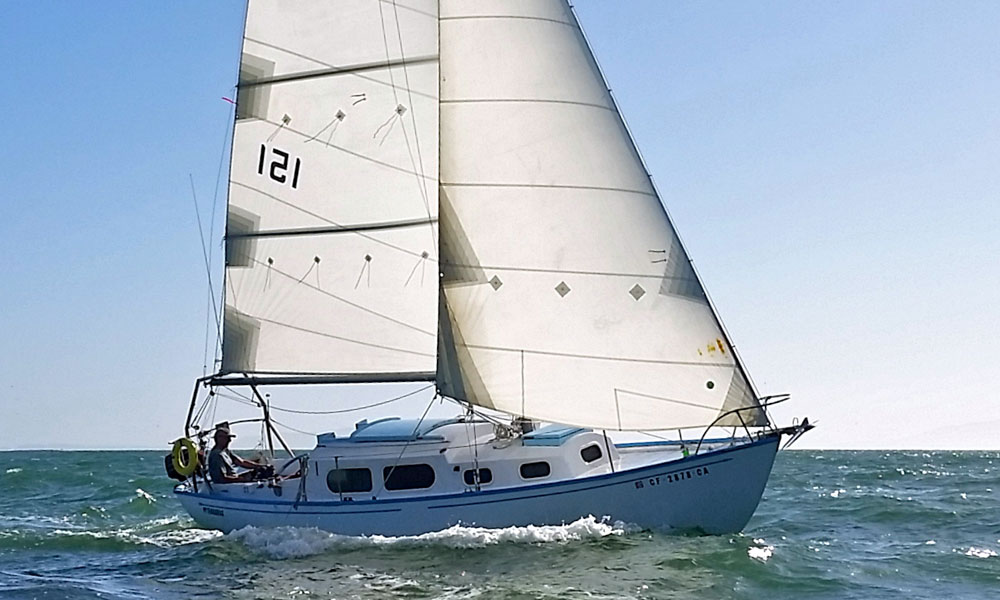
If a sloop has an additional sail between the headsail and the mainsail, then it's no longer a sloop - it's a cutter.
Some cutters - like the one shown here - have the foresail set forward on a bowsprit, with the inner forestay permanently rigged to the stemhead where the foresail otherwise would be, or to a central chainplate further aft on the foredeck.
Read more about cutters...
Examples of Cutters
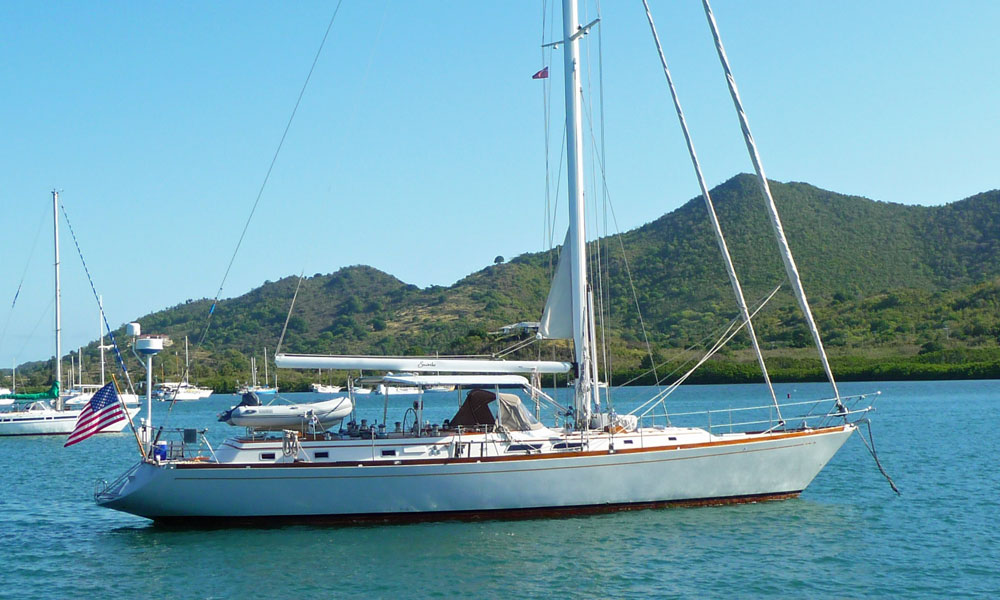
The following boats may look like cutters with their double headsails, but they're not cutters at all...
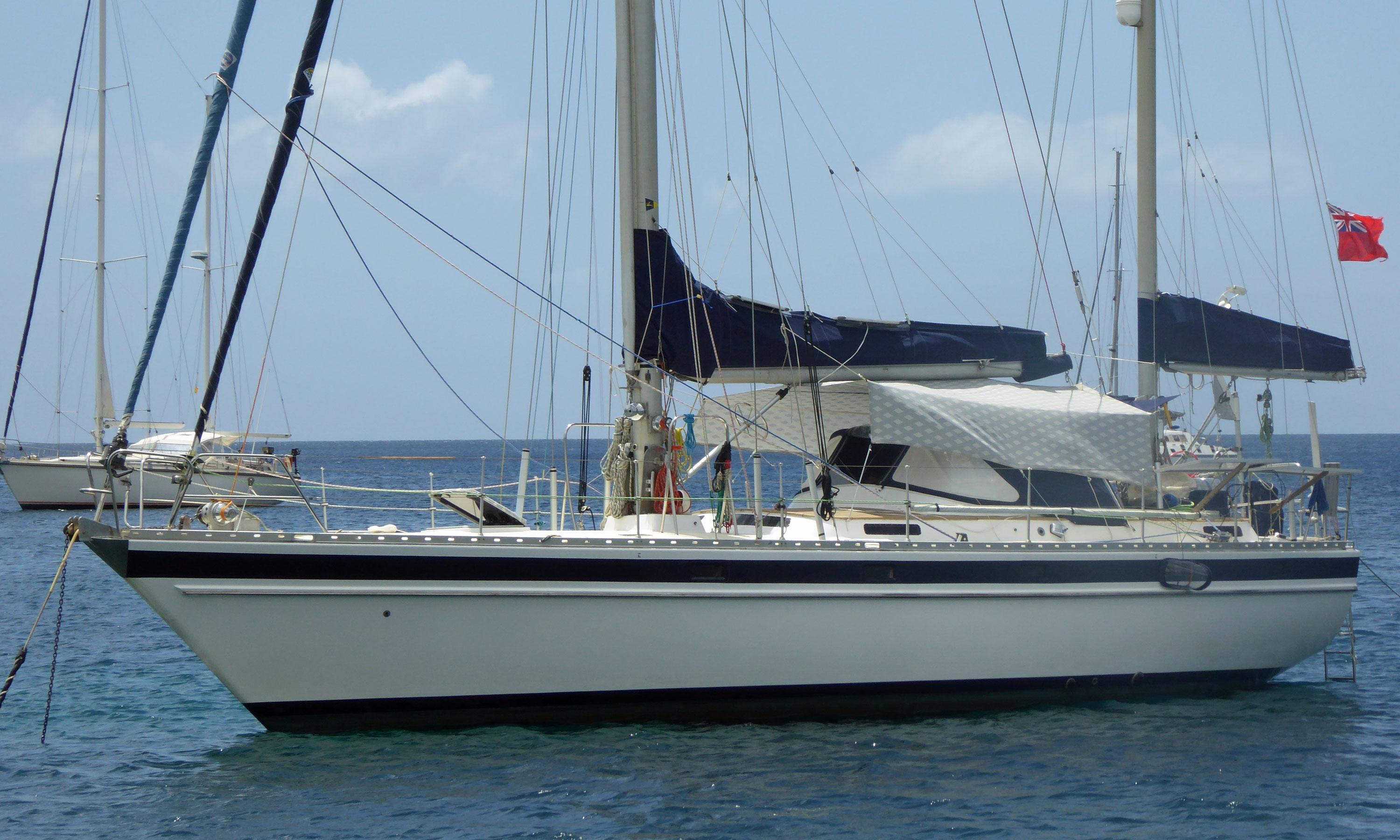
To find out why, click here...
A ketch is a two-masted sailboat, a main mast forward and a shorter mizzen mast aft.
But not all two-masted sailboats are ketches — they might be yawls (see below).
A ketch may also sport a staysail, with or without a bowsprit, in which case it would be known as a cutter-rigged or staysail ketch.
Read more about ketches...
Examples of Ketches
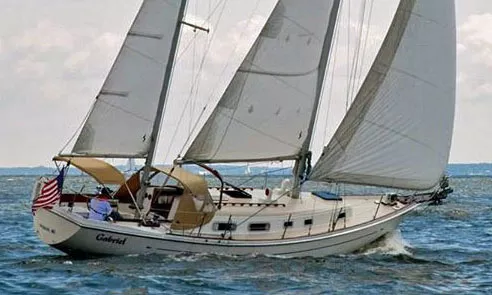
Note that the Ocean 71 and the Irwin 52 are cutter-rigged, and are traditionally referred to as Staysail Ketches .
Cat Ketches
Cat-ketches are recognised by the lack of any standing rigging to support their pair of unstayed masts.
And yes, if the after mast is taller than the foremast then it's called a cat- schooner sailboat.
Read more about cat-ketches...
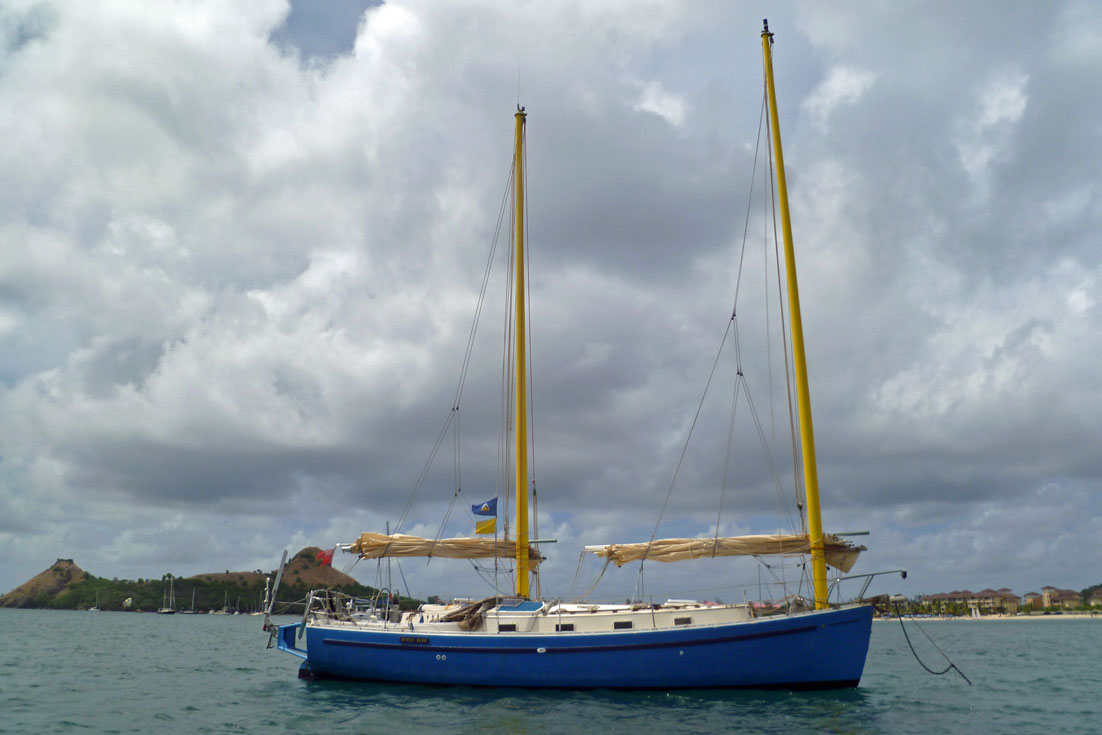
Yawls have their origins as old-time sail fishing boats, where the small mizzen sail was trimmed to keep the vessel steady when hauling the nets.
Much like a ketch, the difference being that the yawl has the mizzen mast positioned aft of the rudder post whereas the ketch has its mizzen mast ahead of the rudder post.
You’ll not be surprised to learn that a yawl with a staysail is known as cutter-rigged yawl.
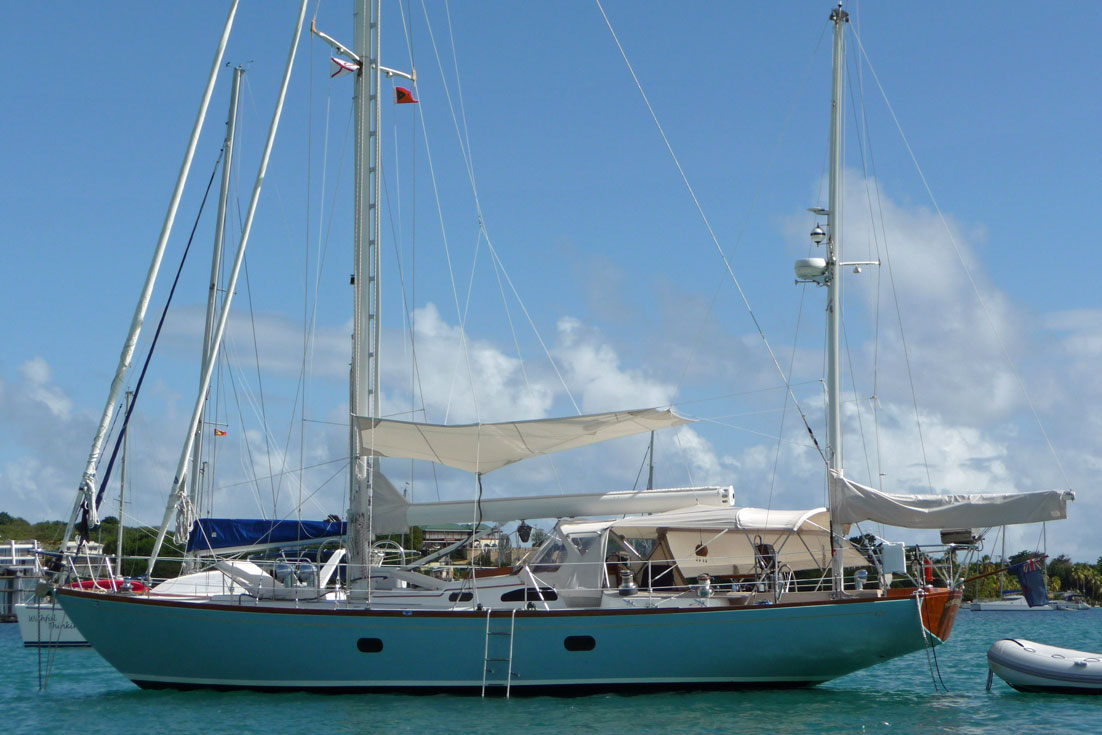
A schooner is a two-or-more masted sailboat, in which the aft-most mast - the mainmast - is the same height or taller than the foremast.
The one shown here is gaff cutter rigged, with a topsail set on the mainmast.
Many sailors agree that of all the different types of sailboats, a schooner under full sail is one of the most beautiful sights afloat.
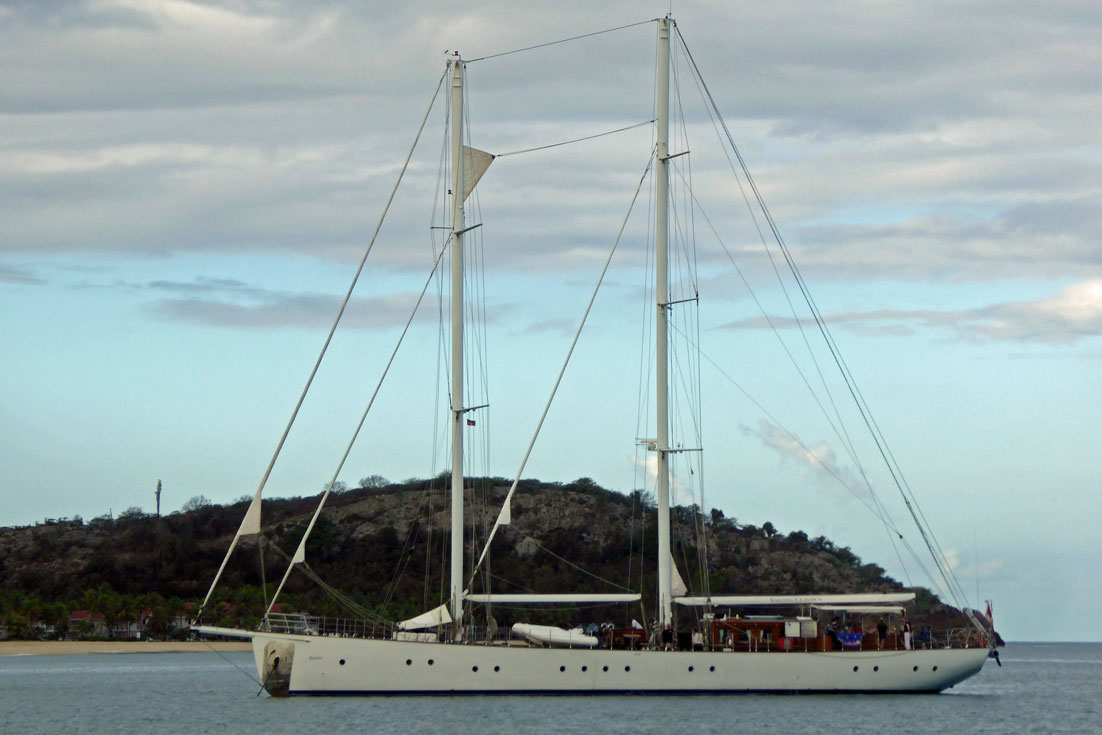
Gaffed-rigged sailboats, or 'gaffers', have their mainsail supported by a spar - the 'gaff' - which is hauled up mast by a separate halyard.
Often these types of sailboats are rigged with a topsail, as shown here and in the gaff schooner above, which really adds some grunt in light airs.
All this comes at a price of course, both in terms of material cost and weight aloft, which is why very few modern yachts are fitted with gaff rigs these days.
All artwork on this page is by Andrew Simpson
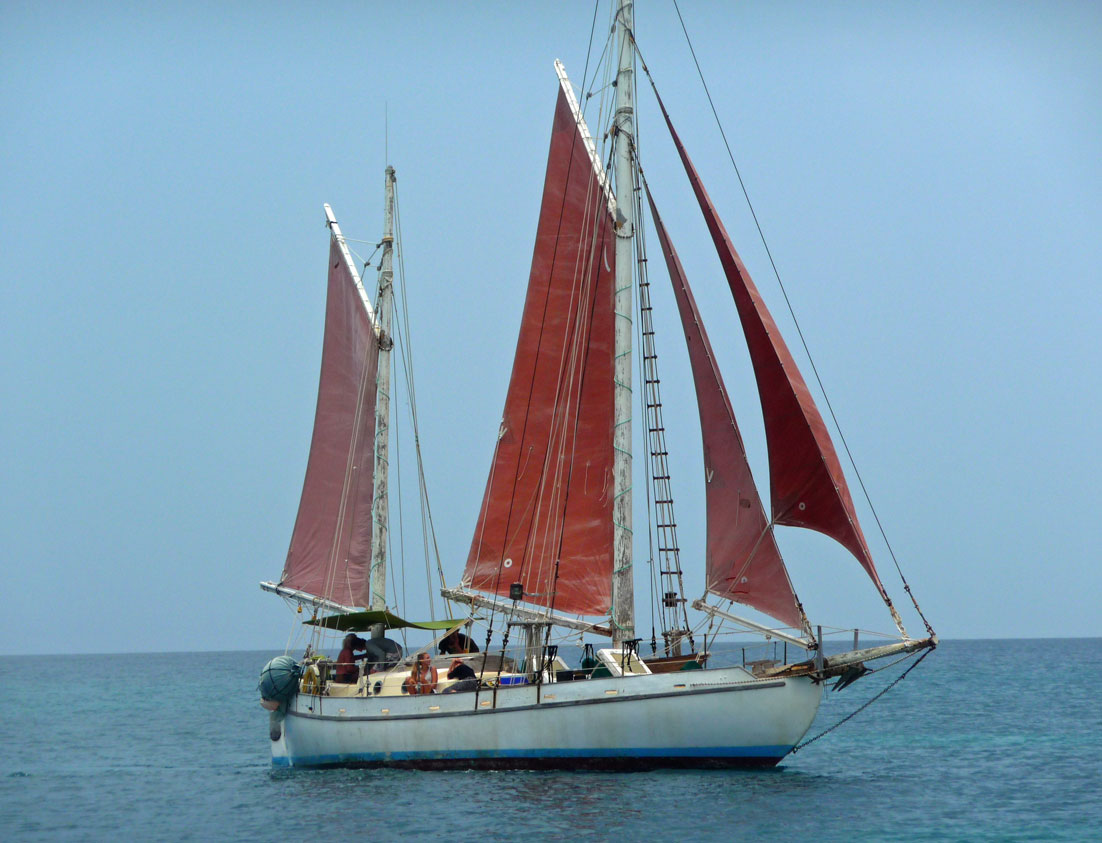
Examples of the Various Types of Sailboats...
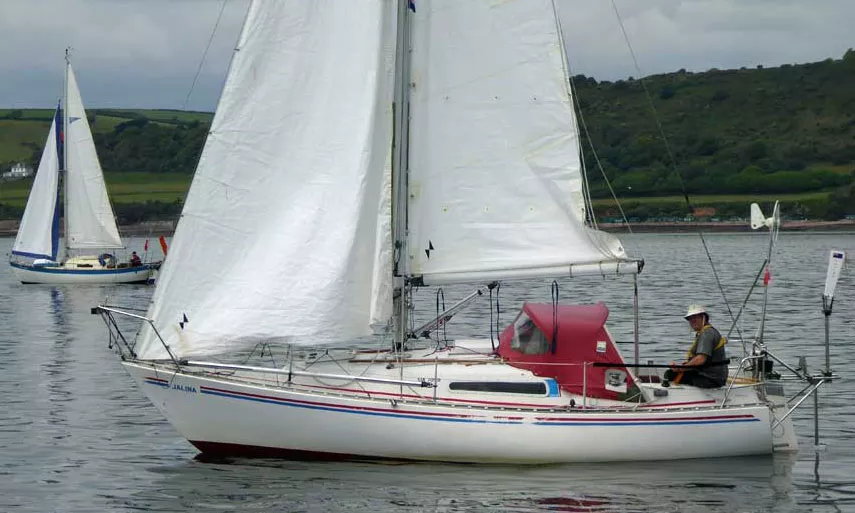
Other Types of Sailboats
The seven sailboat rig variations shown here are the most popular types of modern cruising boat rigs, but there are other rig versions which were once found on commercial, fishing, and naval sailing vessels.
They include:
- Full square-rigged sailing vessels
- Barkentines
- Brigantines
And you can see examples of them here ...
In this article I've said that ketches, yawls and schooners with two headsails can be called cutter rigged. This is a commonly used description but strictly speaking, there's only one rig that can accurately be called a cutter - and that's a single-masted sailboat with two headsails. My thanks to 'Old Salt' for drawing my attention to this!
Recent Articles
The Moody 54 Sailboat
Jun 29, 24 02:09 AM
The Brewer 44 Sailboat
Jun 28, 24 03:21 AM
Used Sailing Equipment For Sale
Jun 14, 24 03:54 AM
Here's where to:
- Find Used Sailboats for Sale...
- Find Used Sailing Gear for Sale...
- List your Sailboat for Sale...
- List your Used Sailing Gear...
Our eBooks...

A few of our Most Popular Pages...

Copyright © 2024 Dick McClary Sailboat-Cruising.com
The Various Types of Sailboats and Rigs
Aditya Adjie / EyeEm / Getty Images
The Modern Sloop
The most common type of small-to-midsize sailboat is the sloop. The rig is one mast and two sails. The mainsail is a tall, triangular sail mounted to the mast at its leading edge, with the foot of the sail along the boom, which extends aft from the mast. The sail in front called the jib or sometimes the headsail, mounts on the forestay between the bow and the masthead, with its trailing corner controlled by the jib sheet.
The Bermuda or Marconi Rig
These tall triangular sails are called the Bermuda rig, or sometimes the Marconi rig, named for their development more than two centuries ago in Bermudan boats. Because of the physics of how force is generated by wind blowing past a sail, tall thin sails generally have more power when the boat is sailing into the wind.
Racing Sloop
Gail Oskin / Getty Images
Here is another example of a sloop with a Bermuda rig. This is PUMA Ocean Racing's il Mostro, one of the fastest monohull sailboats in the world, in the 2008/2009 Volvo Ocean Race. The sails are much bigger than found on most cruising sailboats, but the general rig is the same. In both of the sloops shown so far, the jib reaches to the top of the masthead. These are sometimes called masthead sloops.
Fractional Sloop Rig
Ahunt [CC0] / Wikimedia Commons
Here, notice a small racing dinghy with a sloop rig. This is still a Bermuda rig, but the mainsail is proportionally larger and the jib smaller, for ease of handling and maximum power. Note that the top of the jib rises only a fraction of the distance to the masthead. Such a rig is called a fractional sloop.
KenWiedemann / Getty Images
While a sloop always has two sails, a cat-rigged boat generally has only one. The mast is positioned very far forward, almost at the bow, making room for a very long-footed mainsail. The mainsail of a cat rig may have a traditional boom or, as in this boat, a loose-footed mainsail attached at the aft corner to what is called a wishbone boom.
Compared to Bermuda Rigs
A primary advantage of a cat rig is the ease of sail handling, such as not having to deal with jib sheets when tacking. Generally, a cat rig is not considered as powerful as a Bermuda rig, however, and is more rarely used in modern boats.
Cat-Rigged Racing Dinghy
technotr / Getty Images
In this photo, there is another cat rig, which works well on small racing dinghies like this Laser. With a small boat and one sailor, a cat rig has the advantages of being simple to trim and very maneuverable when racing.
John White Photos / Getty Images
A popular rig for midsize cruising boats is the ketch, which is like a sloop with a second, smaller mast set aft called the mizzenmast. The mizzen sail functions much like a second mainsail. A ketch carries about the same total square footage of sail area as a sloop of the equivalent size.
Make Sail Handling Easy
The primary advantages of a ketch are that each of the sails is usually somewhat smaller than on a sloop of equivalent size, making sail handling easier. Smaller sails are lighter, easier to hoist and trim and smaller to stow. Having three sails also allows for more flexible sail combinations. For example, with the wind at an intensity that a sloop might have to double-reef the main to reduce sail area, a ketch may sail very well under just jib and mizzen. This is popularly called sailing under “jib and jigger”—the jigger being an old square-rigger term for the aft-most mast flying a triangular sail.
While a ketch offers these advantages to cruisers, they may also be more expensive because of the added mast and sail. The sloop rig is also considered faster and is therefore used almost exclusively in racing sailboats.
Public Domain
A yawl is very similar to a ketch. The mizzenmast is usually smaller and sets farther aft, behind the rudder post, while in a ketch the mizzenmast is forward of the rudder post. Aside from this technical difference, the yawl and ketch rigs are similar and have similar advantages and disadvantages.
Tomás Fano [ CC BY-SA 2.0 ], via Wikimedia Commons
A typical schooner has two masts, and sometimes more, but the masts are positioned more forward in the boat. Unlike in a ketch or yawl, the forward mast is smaller than the aft mast (or sometimes the same size). One or more jibs may fly forward of the foremast.
Traditional Schooners
While some modern schooners may use triangular, Bermuda-like sails on one or both masts, traditional schooners like the one shown here have gaff-rigged sails. At the top of the sail is a short spar called the gaff, which allows the sail to extend back along a fourth side, gaining size over a triangular sail of the same height.
Gaff-rigged schooners are still seen in many areas and are well loved for their historic appearance and sweeping lines, but they are seldom used anymore for private cruising. The gaff rig is not as efficient as the Bermuda rig, and the rig is more complicated and requires more crew for sail handling.
Schooner With Topsail and Flying Jibs
Print Collector / Getty Images
Above is another gaff-rigged schooner that is using a topsail and several flying jibs. Tacking or gybing a complicated sail plan like this takes a lot of crew and expertise.
Square-Rigged Tall Ship
Bettmann / Getty Images
In this illustration, notice a large three-masted square-rigger flying five tiers of square sails, several headsails, and a mizzen sail. Although this is a modern ship, one of many still used around the world for sail training and passenger cruise ships, the rig is essentially unchanged from centuries ago. Columbus, Magellan, and the other early sea explorers sailed in square-riggers.
Generating Power
Remarkably efficient sailing downwind or well off the wind, square sails do not generate power from their leading edge as in the Bermuda rig, which has become predominant in modern times. Thus, square-riggers generally do not sail upwind. It was due to this limitation that the great trade wind sailing routes around the world were developed centuries ago.
Buying a Sailboat: Sloop vs. Ketch
The 10 Best Inflatable Stand-Up Paddleboards of 2024, Tested and Reviewed
Learn the Parts of a Sailboat and How to Communicate Them
Owner's Review of the MacGregor 26 Sailboat Models
How to Rig Your Small Sailboat and Prepare to Sail
West Wight Potter 19 Sailboat Review
Review of the O'Day Mariner 19 Sailboat
Learn How to Sail a Small Sailboat
Tall Ships in Los Angeles and Southern California
12 Best Things to Do in Juneau During an Alaska Cruise
How to Charter a Private Yacht
The 11 Best Two-Person Tents of 2024, Tested and Reviewed
13 New Ocean Cruise Ships in 2018
Where to Go in 2023: The Most Exciting Destinations to Explore This Year
Heavy Weather Sailing
The 8 Best Sunglasses for Men of 2024, Tested and Reviewed

Types of Sailboats: A Complete Guide

Last Updated by
Daniel Wade
June 15, 2022
Learning the different types of sailboats can help you identify vessels and choose the right boat.
In this article, we'll cover the most common kinds of sailboats, their origins, and what they're used for. We'll also go over the strengths and weaknesses of each design, along with when they're most useful.
The most common kind of sailboat is the sloop, as it's simple to operate and versatile. Other common sailboat types include the schooner, cutter, cat, ketch, schooner, catamaran, and trimaran. Other sailboat variations include pocket cruisers, motorsailers, displacement, and shoal-draft vessels.
The information found in this article is sourced from boat reference guides, including A Field Guide to Sailboats of North America by Richard M. Sherwood and trusted sources in the sailing community.
Table of contents
Distinguishing Types of Sailboats
In this article, we'll distinguish sailboats by traits such as their hull type, rig, and general configuration. Some sailboats share multiple characteristics with other boats but fall into a completely different category. For example, a sailboat with a Bermuda rig, a large engine, and a pilothouse could technically be called a sloop, but it's more likely a motorsailer.
When discerning sailboat type, the first most obvious place to look is the hull. If it has only one hull, you can immediately eliminate the trimaran and the catamaran. If it has two or more hulls, it's certainly not a typical monohull vessel.
The next trait to consider is the rig. You can tell a lot about a sailboat based on its rig, including what it's designed to be used for. For example, a long and slender sailboat with a tall triangular rig is likely designed for speed or racing, whereas a wide vessel with a complex gaff rig is probably built for offshore cruising.
Other factors that determine boat type include hull shape, overall length, cabin size, sail plan, and displacement. Hull material also plays a role, but every major type of sailboat has been built in both wood and fiberglass at some point.
Sailboat vs. Motorsailer
Most sailboats have motors, but most motorized sailboats are not motorsailers. A motorsailer is a specific kind of sailboat designed to run efficiently under sail and power, and sometimes both.
Most sailboats have an auxiliary engine, though these power plants are designed primarily for maneuvering. These vessels cannot achieve reasonable speed or fuel-efficiency. Motorsailers can operate like a powerboat.
Motorsailers provide great flexibility on short runs. They're great family boats, and they're popular in coastal communities with heavy boat traffic. However, these features come at a cost. Motorsailers aren't the fastest or most efficient powerboats, and they're also not the most agile sailboats. That said, they make an excellent general-purpose sailing craft.
Monohull vs. Multi-hull: Which is Better?
Multihull sailboats are increasingly popular, thanks to advances and lightweight materials, and sailboat design. But are they better than traditional sailboats? Monohulls are easier to maintain and less expensive, and they offer better interior layouts. Multihulls are more stable and comfortable, and they're significantly easier to control. Multihull sailboats also have a speed advantage.
Monohull Sailboats
A monohull sailboat is a traditionally-shaped vessel with a single hull. The vast majority of consumer sailboats are monohulls, as they're inexpensive to produce and easy to handle. Monohull sailboats are proven and easy to maintain, though they lack the initial stability and motion comfort of multi-hull vessels.
Monohull sailboats have a much greater rig variety than multi-hull sailboats. The vast majority of multihull sailboats have a single mast, whereas multi-masted vessels such as yawls and schooners are always monohulls. Some multi-hull sailboats have side-by-side masts, but these are the exception.
Catamaran Sailboats
The second most common sailboat configuration is the catamaran. A catamaran is a multihull sailboat that has two symmetrical hulls placed side-by-side and connected with a deck. This basic design has been used for hundreds of years, and it experienced a big resurgence in the fiberglass boat era.
Catamarans are fast, efficient, and comfortable. They don't heel very much, as this design has excellent initial stability. The primary drawback of the catamaran is below decks. The cabin of a catamaran is split between both hulls, which often leaves less space for the galley, head, and living areas.
Trimaran Sailboats
Trimarans are multi-hull sailboats similar to catamarans. Trimarans have three hulls arranged side-by-side. The profile of a trimaran is often indistinguishable from a catamaran.
Trimarans are increasingly popular, as they're faster than catamarans and monohulls and considerably easier to control. Trimarans suffer from the same spatial limitations as catamarans. The addition of an extra hull adds additional space, which is one reason why these multi-hull vessels are some of the best-selling sailboats on the market today.
Sailboat Rig Types
Rigging is another way to distinguish sailboat types. The rig of a sailboat refers to it's mast and sail configuration. Here are the most common types of sailboat rigs and what they're used for.
Sloops are the most common type of sailboat on the water today. A sloop is a simple single-mast rig that usually incorporates a tall triangular mainsail and headsail. The sloop rig is easy to control, fun to sail, and versatile. Sloops are common on racing sailboats as they can sail quite close to the wind. These maneuverable sailboats also have excellent windward performance.
The sloop rig is popular because it works well in almost any situation. That said, other more complex rigs offer finer control and superior performance for some hull types. Additionally, sloops spread their entire sail area over just to canvases, which is less flexible than multi-masted rigs. The sloop is ideal for general-purpose sailing, and it's proven itself inland and offshore.
Sloop Features:
- Most popular sailboat rig
- Single mast
- One mainsail and headsail
- Typically Bermuda-rigged
- Easy to handle
- Great windward performance
- Less precise control
- Easier to capsize
- Requires a tall mast
Suitable Uses:
- Offshore cruising
- Coastal cruising
Cat (Catboat)
The cat (or catboat) is a single-masted sailboat with a large, single mainsail. Catboats have a thick forward mast, no headsail, and an exceptionally long boom. These vessels are typically gaff-rigged, as this four-edged rig offers greater sail area with a shorter mast. Catboats were popular workboats in New England around the turn of the century, and they have a large following today.
Catboats are typically short and wide, which provides excellent stability in rough coastal conditions. They're hardy and seaworthy vessels, but they're slow and not ideal for offshore use. Catboats are simple and easy to control, as they only have a single gaff sail. Catboats are easy to spot thanks to their forward-mounted mast and enormous mainsail.
Catboat Features:
- Far forward-mounted single mast
- Large four-sided gaff sail
- Short and wide with a large cockpit
- Usually between 20 and 30 feet in length
- Excellent workboats
- Tough and useful design
- Great for fishing
- Large cockpit and cabin
- Not ideal for offshore sailing
- Single sail offers less precise control
- Slow compared to other rigs
- Inland cruising
At first glance, a cutter is difficult to distinguish from a sloop. Both vessels have a single mast located in roughly the same position, but the sail plan is dramatically different. The cutter uses two headsails and often incorporates a large spar that extends from the bow (called a bowsprit).
The additional headsail is called a staysail. A sloop only carries one headsail, which is typically a jib. Cutter headsails have a lower center of gravity which provides superior performance in rough weather. It's more difficult to capsize a cutter, and they offer more precise control than a sloop. Cutters have more complex rigging, which is a disadvantage for some people.
Cutter Features:
- Two headsails
- Long bowsprit
- Similar to sloop
- Gaff or Bermuda-rigged
- Fast and efficient
- Offers precise control
- Superior rough-weather performance
- More complex than the sloop rig
- Harder to handle than simpler rigs
Perhaps the most majestic type of sailboat rig, the schooner is a multi-masted vessel with plenty of history and rugged seaworthiness. The schooner is typically gaff-rigged with short masts and multiple sails. Schooners are fast and powerful vessels with a complex rig. These sailboats have excellent offshore handling characteristics.
Schooners have a minimum of two masts, but some have three or more. The aftermost large sail is the mainsail, and the nearly identical forward sail is called the foresail. Schooners can have one or more headsail, which includes a cutter-style staysail. Some schooners have an additional smaller sale aft of the mainsail called the mizzen.
Schooner Features:
- At least two masts
- Usually gaff-rigged
- One or more headsails
- Excellent offshore handling
- Precise control
- Numerous sail options (headsails, topsails, mizzen)
- Fast and powerful
- Complex and labor-intensive rig
- Difficult to adjust rig single-handed
- Offshore fishing
Picture a ketch as a sloop or a cutter with an extra mast behind the mainsail. These vessels are seaworthy, powerful, excellent for offshore cruising. A ketch is similar to a yawl, except its larger mizzen doesn't hang off the stern. The ketch is either gaff or Bermuda-rigged.
Ketch-rigged sailboats have smaller sails, and thus, shorter masts. This makes them more durable and controllable in rough weather. The mizzen can help the boat steer itself, which is advantageous on offshore voyages. A ketch is likely slower than a sloop or a cutter, which means you aren't likely to find one winning a race.
Ketch Features:
- Headsail (or headsails), mainsail, and mizzen
- Mizzen doesn't extend past the rudder post
- Good offshore handling
- Controllable and mild
- Shorter and stronger masts
- Easy self-steering
- Slower than sloops and cutters
- Less common on the used market
A dinghy is a general term for a small sailboat of fewer than 28 feet overall. Dinghys are often dual-power boats, which means they usually have oars or a small outboard in addition to a sail. These small boats are open-top and only suitable for cruising in protected waters. Many larger sailboats have a deployable dinghy on board to get to shore when at anchor.
Dinghy Features:
- One or two people maximum capacity
- Easy to sail
- Works with oars, sails, or an outboard
- Great auxiliary boat
- Small and exposed
- Not suitable for offshore use
- Going from anchor to shore
- Protected recreational sailing (lakes, rivers, and harbors)
Best Sailboat Type for Stability
Stability is a factor that varies widely between sailboat types. There are different types of stability, and some sailors prefer one over another. For initial stability, the trimaran wins with little contest. This is because these vessels have a very high beam-to-length ratio, which makes them much less prone to rolling. Next up is the catamaran, which enjoys the same benefit from a wide beam but lacks the additional support of a center hull section.
It's clear that in most conditions, multihull vessels have the greatest stability. But what about in rough weather? And what about capsizing? Multihull sailboats are impossible to right after a knockdown. This is where full-keel monohull sailboats excel.
Traditional vessels with deep displacement keels are the safest and most stable in rough weather. The shape, depth, and weight of their keels keep them from knocking over and rolling excessively. In many cases, these sailboats will suffer a dismasting long before a knockdown. The primary disadvantage of deep-keeled sailboats is their tendency to heel excessively. This characteristic isn't hazardous, though it can make novice sailors nervous and reduce cabin comfort while underway.
Best Sailboat Type for Offshore Cruising
The best sailboat type for offshore cruising is the schooner. These graceful aid robust vessels have proven themselves over centuries as durable and capable vessels. They typically use deep displacement keels, which makes them stable in rough weather and easy to keep on course.
That said, the full answer isn't quite so simple. Modern multihull designs are an attractive option, and they have also proven to be strong and safe designs. Multihull sailboats are an increasingly popular option for offshore sailors, and they offer comfort that was previously unknown in the sailing community.
Many sailors cross oceans in basic Bermuda-rigged monohulls and take full advantage of a fin-keel design speed. At the end of the day, the best offshore cruising sailboat is whatever you are comfortable handling and living aboard. There are physical limits to all sailboat designs, though almost any vessel can make it across an ocean if piloted by a competent skipper and crew.
Best Sailboat Type for Racing The modern lightweight Bermuda-rigged sailboat is the king of the regatta. When designed with the right kind of hull, these vessels are some of the fastest sailboats ever developed. Many boats constructed between the 1970s and today incorporate these design features due to their favorable coastal and inland handling characteristics. Even small sailboats, such as the Cal 20 and the Catalina 22, benefit from this design. These boats are renowned for their speed and handling characteristics.
Related Articles
I've personally had thousands of questions about sailing and sailboats over the years. As I learn and experience sailing, and the community, I share the answers that work and make sense to me, here on Life of Sailing.
by this author
Learn About Sailboats
Most Recent

What Does "Sailing By The Lee" Mean?
October 3, 2023

The Best Sailing Schools And Programs: Reviews & Ratings
September 26, 2023
Important Legal Info
Lifeofsailing.com is a participant in the Amazon Services LLC Associates Program, an affiliate advertising program designed to provide a means for sites to earn advertising fees by advertising and linking to Amazon. This site also participates in other affiliate programs and is compensated for referring traffic and business to these companies.
Similar Posts

Affordable Sailboats You Can Build at Home
September 13, 2023

Best Small Sailboat Ornaments
September 12, 2023

Discover the Magic of Hydrofoil Sailboats
December 11, 2023
Popular Posts

Best Liveaboard Catamaran Sailboats
December 28, 2023

Can a Novice Sail Around the World?
Elizabeth O'Malley

4 Best Electric Outboard Motors

How Long Did It Take The Vikings To Sail To England?

10 Best Sailboat Brands (And Why)
December 20, 2023

7 Best Places To Liveaboard A Sailboat
Get the best sailing content.
Top Rated Posts
Lifeofsailing.com is a participant in the Amazon Services LLC Associates Program, an affiliate advertising program designed to provide a means for sites to earn advertising fees by advertising and linking to Amazon. This site also participates in other affiliate programs and is compensated for referring traffic and business to these companies. (866) 342-SAIL
© 2024 Life of Sailing Email: [email protected] Address: 11816 Inwood Rd #3024 Dallas, TX 75244 Disclaimer Privacy Policy
'Ghost ship' belongs to Texas man whose world sailing dreams might be dashed
A “ghost ship” that recently washed up on a Florida Panhandle beach was traced to a Texas man who’ll likely lose much of his life savings after purchasing the vessel he had hoped to sail around the world.
Francine Farrar couldn’t believe her eyes early on the evening of June 18 when a 45-foot sailboat with no one aboard eerily floated toward her family’s beach rental in Pensacola.
“I saw this tattered sailboat, it looked ghostly, just kind of coming in,” Farrar, a 46-year-old Meridian, Mississippi, homemaker, told NBC News last week.
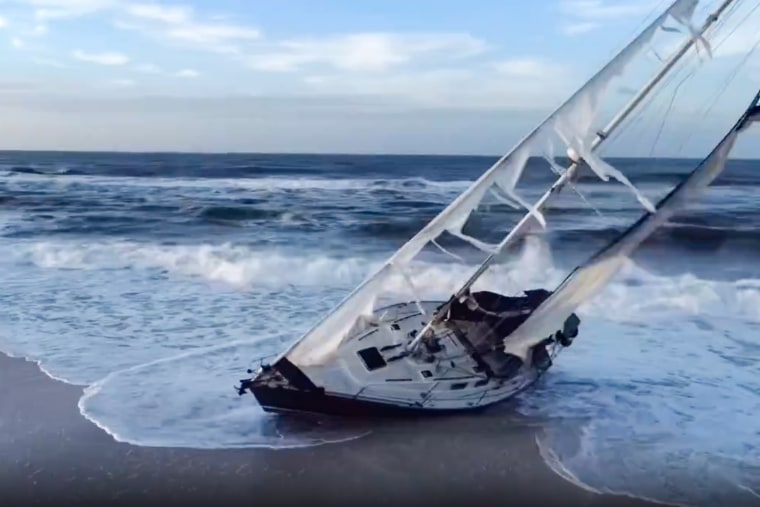
The craft washed ashore and the strange sight of a sailboat on the sand quickly became a source of neighborhood fascination, said 35-year-old Pensacola resident Allie Garrett.
“We called it the ‘ghost ship.’ It quickly became known as the ‘ghost ship’ across Pensacola beach,” said Garrett, a meteorologist and storm chaser who took multiple photos and drone footage of the prone vessel.
Wayward boats are common during Florida hurricane season as vessels succumb to high winds and get taken off their moorings.
“We just thought this sailboat broke loose from the marina, that someone didn’t tie it down well enough,” Farrar said.
But this beached ship turned out to have a far more complicated journey to where it now sits in Pensacola.
Shortly after locals posted images of the craft on social media, those pictures gained the attention of 39-year-old Michael Barlow, whose life was saved weeks earlier during a harrowing Coast Guard rescue in the Gulf of Mexico.
Barlow immediately recognized the images and video to be The Lady Catherine III, which he purchased in Fort Pierce, Florida, in May.
“I knew it was her,” Barlow said.
The Catherine pushed off from Fort Pierce on May 21, Barlow said, with plans to dock in Rockport, Texas, where he was closing down an excavation business and selling off belongings to start a new wandering life.
“We were just going to explore the world,” Barlow said of his wife and 9-year-old son. “We’re normal people. We have normal finances, very, very basic. And this is the only way I could take my son and show him there’s a whole world out there, beyond what’s in America. It’s the only way to do this realistically until this happened.”
Barlow and a friend were headed back to Texas when high winds and massive waves that would eventually become Hurricane Alberto lashed the Catherine and rendered it inoperable.
“We went through storms one after another, after another, after another, and then that last storm just hit us and exploded my front headsails,” Barlow said in an interview from Honduras, where he’s temporarily living and teaching scuba. “We lost our headsail, we lost our motor, and we were getting turned. It was unforecast and it was devastating.”
He added: “The seas were the craziest thing I’ve ever seen. I’ve been on the water my entire life, worked on offshore fishing boats, and I’ve seen some gnarly seas. But this was the craziest thing I’ve ever seen in my life.”
A Garmin satellite communication device was one of the few electric or gas-powered tools not destroyed by crashing seawater, and Barlow was able to get word to authorities on shore that he was stuck in dangerous waters.
“We were fine right now, but we have no control of the boat and it’s getting worse,” Barlow said, recalling his message to the Coast Guard. “We starting to get turned sideways. The waves were rolling the boat. There was not much we could do.”
The Coast Guard in New Orleans said it was alerted to two boaters whose “vessel became disabled approximately 190 miles south of Panama City” on June 1.
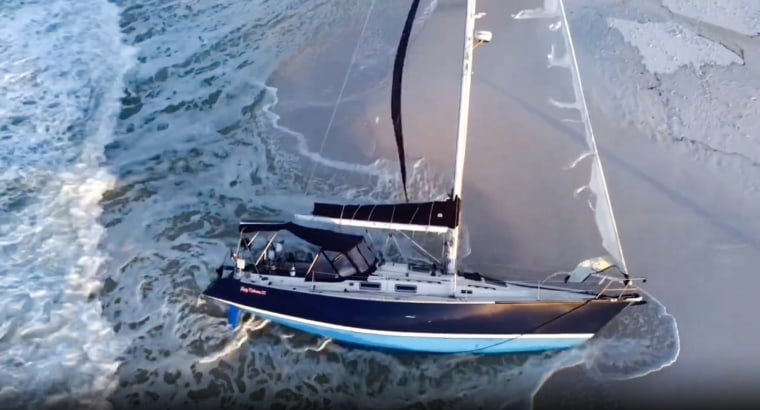
A Coast Guard helicopter and surveillance plane found Barlow and his friend on the Catherine, officials said, but a boat-to-boat rescue was out of the question in those unstable waters.
“‘We can come get you right now, but you have to leave the vessel,’” said Barlow, recalling the choice Coast Guard rescuers gave him. “‘You’re definitely rolling the dice on your life if you stay.’ It was just a bad situation, and it was getting progressively worse.”
Barlow picked a rescue over the boat he purchased for $80,000.
“The aircrews arrived on scene, the helicopter aircrew hoisted the two persons aboard and transported them to Panama City Airport in Panama City, Florida,” a Coast Guard statement said.
Barlow said he was reasonably confident the Catherine would show up again, and it did, 17 days later and nearly 200 miles away.
“We did our best to leave her in the best condition to make it through the storm,” Barlow said. “We lashed everything down and we hoped she could ride it out.”
Now, the sailor has nothing but bad choices ahead of him.
He could pay $20,000 to have the Catherine taken to dry dock for repairs that could very well total more than its pre-Alberto value.
Or he could shell out about $28,000 to simply have the vessel taken away and demolished, which would at least stop the financial hemorrhage .
“If we’re talking about business numbers, it’d make more sense to scrap the boat,” Barlow said. “That’s just the stone-cold truth.”
He’s now in talks with state and local officials in hopes of finding a solution in coming weeks.
As the owner of a “derelict vessel,” Barlow has to move it away or possibly face a third-degree felony, punishable by a fine of up to $5,000 and even prison time, officials said.
“Yes, our officers have been in contact with Mr. Barlow,” Florida Fish and Wildlife Conservation Commission spokesperson Faith Fawn said in statement. “He has 30 days from the date the uniform boating citation was issued to bring his vessel into compliance.”
Barlow said he’s not giving up on his world-sailing dreams even if this Catherine misadventure costs him so much of his life savings.
“I said I can make another 80,000 bucks and we can carry on with life and try again or we can sit around here and try to be tough guys and really lose it all,” Barlow said of his final moments on the water aboard the Catherine.
“This definitely did not shake my resolve as far as sailing goes. I love the ocean. I respect the ocean. It’s relentless and beautiful at the same time.”
David K. Li is a senior breaking news reporter for NBC News Digital.
Payton May is an intern with NBC News' Social Newsgathering team.
Rima Abdelkader is a senior reporter for Social Newsgathering at NBC News in New York.
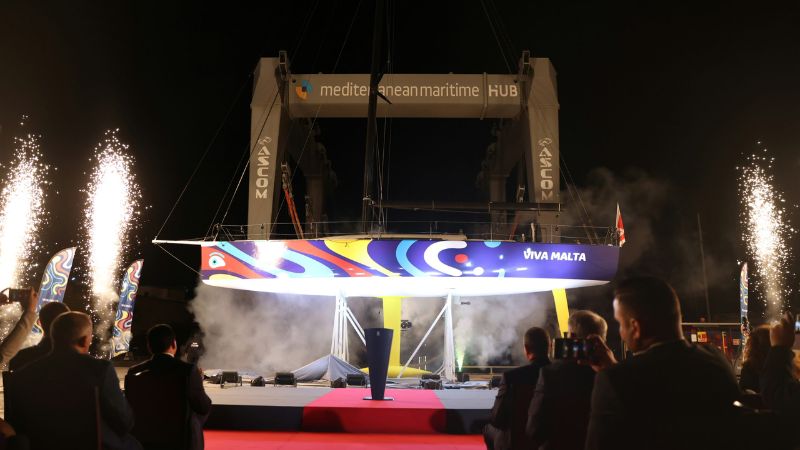
The 'Viva Malta' boat inaugurated with fireworks in December 2022.
€500,000 publicly-funded sailing boat left idle for 18 months
A second-hand sailing boat bought by the government for half a million euro to be used for international sailing competitions has been left idle for 18 months as it is still “being upgraded”, The Shift is informed.
The boat was inaugurated in December 2022. During a lavish ceremony at Marsa’s Malta Maritime Hub, Sports Minister Clifton Grima said the investment would create opportunities for Maltese sailors to compete in prestigious races overseas.
Yet a year and a half later, sources close to the Malta Sailing Federation told The Shift that the boat had not yet participated in a single race and had been left unused for months as tens of thousands were being spent to upgrade it for racing requirements.
The Cookson 50, named ‘Viva Malta’, was acquired by Yachting Malta Ltd – a government private-public partnership with the Malta Sailing Federation. No details were ever given about the seller of the second-hand boat or if any intermediary agents were involved in the sale.
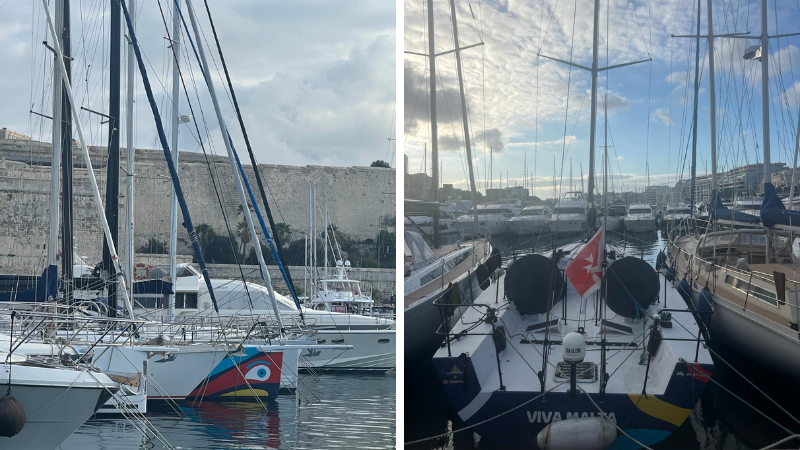
‘Viva Malta’ berthed at Msida Creek.
While attending a parliamentary sitting of the Public Accounts Committee last week, Yachting Malta chairman and Labour MP Chris Agius and CEO Michael Mifsud (who is also the President of the Malta Sailing Federation) said the boat was still not being used, but training was about to start.
As he was being questioned by PN MPs Graham Bencini and David Agius, Mifsud admitted that this project had taken too long to get off the ground but promised that Yachting Malta intended to compete in at least one race by the end of this year.
According to Mifsud, the boat needed upgrading, which was taking time. It is as yet unclear how much the upgrading of the sailing boat has already cost taxpayers.
Mifsud also said that Yachting Malta would invest a further €150,000 a year in state funds for training and yearly participation in overseas races.
‘Viva Malta’ will have a crew of 12, but they have yet to start training to man the sailing boat.
SportMalta, the government entity entrusted to manage Maltese sports, is supposed to manage the new €500,000 boat investment.
Sign up to our newsletter
Stay in the know, get special updates directly in your inbox.
Yet another great example of a ministry whose only scope is to get control of the running of amateur sports organisations.
Previous article
Next article
Related Stories
Opinion: The fake surplus and our blinding deficit

Opinion: Labour’s grand conspiracy

Opinion: Mind the Gap – Europe
Editor's Picks

Concerns on press freedom in Malta sustained in new report
Caroline Muscat
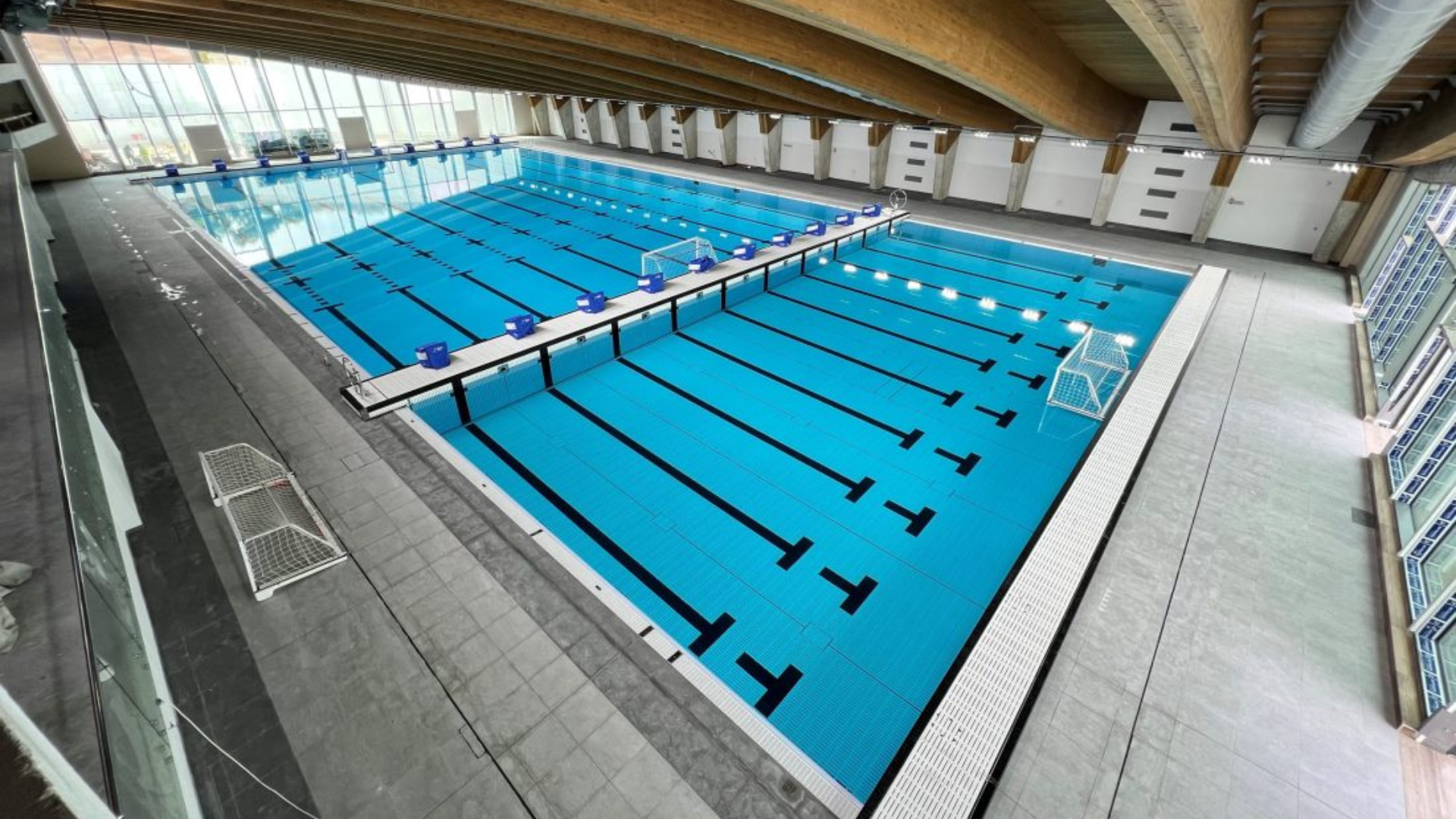
Government awards late, overbudget pool as its ‘project of the year’
The Shift Team

Our Awards and Media Partners

The Shift is an independent online news platform committed to investigative journalism and the defence of press freedom. It is also a platform for political, cultural and social commentary from civil society.
Advertising Rates Advertising Policy

- Share full article

F1 on the Water? Yachts Race at the Statue of Liberty.
Thousands of spectators turned out over the weekend for SailGP, which brought a high-speed competition, and lots of champagne, to the New York Harbor.
The catamarans used to compete in SailGP races cost about $5 million. Credit... Dolly Faibyshev for The New York Times
Supported by

By Alyson Krueger
- Published June 24, 2024 Updated June 26, 2024
At 11:30 a.m. Sunday morning, with New York City under a heat advisory, a gaggle of sailing enthusiasts, dressed in polo shirts and summer dresses, boarded a ferry for Governors Island to watch towering F50 catamarans race along the skyline of Lower Manhattan and in front of the Statue of Liberty.
It was the second day and the finals of the New York Sail Grand Prix, part of SailGP, the growing international sailing competition in which teams, grouped by country, compete in $5 million boats that race up to 60 miles per hour.
The competition was founded in 2018 by Larry Ellison, the tech billionaire, and Russell Coutts, a five-time America’s Cup winner, to build a mainstream sailing league. Unlike America’s Cup, which occurs roughly every four years, SailGP has events around the globe throughout the year, allowing audiences to follow along.
“It’s this high-adrenaline, high-speed sort of racing product right in front of you,” Mr. Coutts said.

Organizers and fans are comparing the competition to Formula 1 racing on the water, which also has billionaire and celebrity backers and flashy backdrops including St. Tropez and Dubai. Now in its fourth season, the number of SailGP teams and events has doubled. The races, filled with Olympic sailors and state-of-the-art catamarans, are broadcast throughout the world and attract millions of viewers, according to organizers.
The sold-out race was held at the tip of Manhattan. Thousands of spectators gathered to watch the race by boat or from Governors Island, a 172-acre island in New York Harbor. (Tickets started at $85 for the grandstand.)
A private tent on a paved area by the water was reserved for team owners and invited ticket holders. There was sushi and dumplings and tea service catered by the Plaza.
The teams were spread around the lounge, marked by flags. Lindsey Vonn, the Olympic ski racer, is on the board of directors for the team from the United States.
“I love speed and adrenaline, so when the opportunity presented itself it was a no-brainer,” Ms. Vonn said in a text message. She attended the race live on Saturday.
On Sunday, the races started around 1 p.m., prompting many guests to put down their champagne and Aperol spritzes and approach the edge of the water to take in the sailing.
Unlike in Formula 1, where a spectator can see only a short stretch of the track at a time, all of SailGP’s racing happens in a tight area in full view of the crowd.
The event is a series of three short races (each one lasts about 15 minutes) in which the boats circle the course multiple times, depending on the wind conditions.
For the boat to turn, 32 functions have to be performed by the team in unison. The catamarans are close enough to shore to see the sailors — there are usually six on each boat — in action.
Jennifer Falvey, 63, a real estate agent, had traveled from Woodstock, Vt., for the event after hearing it about it from a friend. “The boats are just so sexy,” she said.
Daniela Forte, who came with her husband from Westport, Conn., was struck by the speed.
“I don’t have a sailing background, and I had never heard of SailGP before this event, but it’s kind of an amazing idea,” she said. “Sailing has always felt like something you had to do, not just something you can watch, but this is amazing.”
An hour and a half after the first race started, the team from New Zealand was declared the winner (a television broadcaster announced: “The Kiwis have conquered Manhattan.”) The top three contenders are now New Zealand, Australia and Spain — ahead of the season finals in San Francisco in the middle of July.
Then sailors, still wet from the water, filled the lounge for “Apres Sail.” Hundreds of people remained in the private lounge for hours, snacking on fresh plates of pasta and freshly shucked oysters.
Despite the stifling, 90-degree temperatures the party continued until late afternoon. Dance music blared over the loudspeakers, fans mingled with the sailors, and at least one bar ran out of champagne.
Explore Our Style Coverage
The latest in fashion, trends, love and more..
Late-in-Life Lesbian Experience: Social media and websites have become a valuable resource to some women who have come out in their later years or after marriages to men.
Partying Without Regrets: Forty-three highly sociable people, from Ivy Getty to Rufus Wainwright, offer tips on how to be a stellar guest and a gracious host .
A Generational Sock War: Social media is awash in another intergenerational fashion debate: Ankle socks or crew socks ?
Murray Hill’s Showbiz Dream: For years the comedian wowed ’em in the clubs with his drag-king lounge act. Now, against all odds, he’s breaking out .
NOFX Eyes Retirement: The punk rock pioneers chose freedom — and chaos — over major labels. Pulling the plug while things are still working is one final act of rebellion .
Advertisement

These 3 lesser-known cruise lines offer amazing voyages on sail-powered ships
There is nothing quite as magical — or romantic — as a cruise on a sailing ship.
To stand on the deck of a vessel topped with dozens of billowing sails, propelled through the waves by the power of the wind alone, is to go back in time to an earlier age of travel, when crossing the world's oceans was as adventurous as it was challenging.
It's an experience that's all about the feeling of the wind in your hair, the lean of the vessel (known as the heel) as it's pushed by the wind and the sway from the waves (which is actually smoother than what you get on a motor ship).
For more cruise guides, news and tips, sign up for TPG's cruise newsletter .
In contrast to what you'll find on so many motor-powered ships, cruising on a masted ship is about the simple thrill of traveling across the sea and not about all the many attractions you'll find on board.
Only a handful of small cruise brands — so small that you might never have heard of them — offer trips on sailing ships. Here, we look at the three biggest players in this niche subset of the cruise industry.
Sea Cloud Cruises
If it's an authentic, old-style sailing experience you want, then Sea Cloud Cruises is the line for you. The Germany-based company operates three large sailing ships where the sails are unfurled by hand, just as they were on sailing ships centuries ago.
On the biggest of these three vessels, the 136-passenger Sea Cloud Spirit , 18 deckhands scurry high into the rigging on sea days to manually untie and prepare the sails, an amazing sight. Unveiled in 2021 , it's a full-rigged, three-masted sailing ship of the sort that hasn't been common on the world's oceans for more than a century.
Related: Why Sea Cloud Spirit is a sailing vessel you'll want to try
Sea Cloud Cruises' two other vessels — Sea Cloud 2 and Sea Cloud — are smaller but offer a similar show as the sails are set by hand the old-fashioned way. The former is a 23-year-old, three-masted barque propelled by 23 sails (five fewer than Sea Cloud Spirit); the latter is a 93-year-old, four-masted barque with 30 sails and a storied past.
Now configured to carry 64 paying passengers, Sea Cloud was originally the private yacht of Postum Cereals heiress Marjorie Merriweather Post and her husband, the famed financier E. F. Hutton. At the time, the vessel was the largest private yacht in the world. It later served the U.S. Navy as a weather ship during World War II, after which it became the presidential yacht for the Dominican Republic. It only began sailing as a cruise vessel in the 1980s.
If you have money to spare, you can still book Post's opulent private quarters on Sea Cloud, now its owner's suite. It'll set you back around $5,000 per day per couple. Her husband's slightly smaller quarters are also available to book at a similar rate.
Post, the wealthiest woman in the U.S. during her lifetime, notably also built Mar-a-Lago, the massive estate in Florida that is now the official residence of Donald Trump.
Sea Cloud Cruises is the most all-inclusive and upscale of the three brands listed in this story, with pricing to match. Expect to pay nearly $1,000 per person per day or more for many sailings.
Sea Cloud Cruises' three vessels offer a diverse array of sailings in the Mediterranean, Northern Europe, the Canary Islands and Morocco, the Caribbean or along the west coast of Central America.
Related: Cruising Costa Rica, Panama with Sea Cloud Cruises
Windstar Cruises
Founded in the 1980s, Windstar Cruises got its start as a sailing ship line. While it now operates traditional motor-powered ships, too, voyages on sailing ships are still a big part of its business.
Three of the Seattle-based brand's six vessels — Wind Spirit, Wind Star and Wind Surf — are sailing vessels, and they all offer a similar yacht-like, small-ship experience.
Two of the three vessels (Wind Spirit and Wind Star) are particularly intimate, measuring 5,407 tons and carrying just 148 passengers with every berth full.
Related: The 2 types of Windstar ships, explained
The line's third sailing vessel, Wind Surf, is nearly three times the size at 14,745 tons. It's one of the biggest sailing ships in the world (only a sister vessel that sails for Club Med is bigger). Wind Surf carries 342 people, an enormous number for a sailing ship.
Unlike on the vessels operated by Sea Cloud, the sails on Windstar's sailing ships aren't unfurled by hand in the old-fashioned way but by the push of a button from the bridge. It's a fully automated system that is much more modern, if less dramatic.
Still, the experience of slicing through the waves by the power of the wind alone on Windstar ships is as glorious and romantic as it is on the Sea Cloud ships.
Windstar Cruises is less all-inclusive and pricey than Sea Cloud but still offers a relatively upscale experience. Its dining program is done in partnership with the food-focused James Beard Foundation, which also brings James Beard Award-winning chefs to the ships regularly for food-themed itineraries.
For an extra $89 per person per day, passengers can also make the experience more all-inclusive with included Wi-Fi, unlimited beer, wine and cocktails, and gratuities (three things that aren't included in regular fares).
The line's three vessels typically spend nearly all of their time sailing in the Mediterranean, the Caribbean or along the west coast of Central America.
Related: Read more about Windstar's itineraries
Star Clippers
Like Sea Cloud and Windstar, Star Clippers operates three sailing vessels that are among the biggest and most elegant sailing vessels in the world.
The belle of the ball at the line is Royal Clipper, a stunning five-masted ship that is billed as the largest square-rigged ship in the world. Its enormous array of 42 sails has a sail area of 56,000 square feet — significantly more than the sails atop any of the Sea Cloud or Windstar vessels. (Only Sea Cloud Spirit comes relatively close with a sail area of 44,100 square feet spread across 28 sails.)
Built to resemble Preussen, a legendary tall ship of the 19th century, the 24-year-old Royal Clipper shares the spotlight at Star Clippers with two smaller sister vessels, Star Flyer and Star Clipper.
Carrying 166 passengers apiece, the smaller vessels were designed to resemble the speedy clipper ships of the 19th century, which were known for their narrow profile and large sail area. Each vessel has a sail area of 36,000 square feet spread across 16 sails, a large amount for the size.
When it comes to the setting of sails, Star Clippers vessels offer a level of old-style authenticity that is in between the ships of Sea Cloud and Windstar. Like on Sea Cloud vessels, the sails are pulled into position by a team of deckhands using hand power and winches to tighten the "sheets," or ropes.
Unlike on Sea Cloud vessels, the deck hands don't climb high into the rigging to untie and prepare the sails for winching. That part is done automatically at the push of a button from the bridge, as it is on Windstar vessels.
In one key difference, though, Star Clippers lets passengers harness up and climb into the crow's nest of its vessels — a thrilling experience. Just be prepared for your knees to go a bit wobbly as you get to the top; it's way up there.
Star Clippers sailings are the most affordable option among the three sailing brands, in part because the onboard experience is less all-inclusive and upscale.
The three Star Clippers vessels mostly operate sailings in the Mediterranean, the Canary Islands, the Caribbean and along the west coast of Central America.
Bottom line
It's still possible to get a taste of what traveling the world's oceans was like in the days before motor power. Three small cruise companies — Sea Cloud Cruises, Windstar Cruises and Star Clippers — offer voyages on large sailing ships that are as majestic as anything that has sailed the seas in centuries past.
Planning a cruise? Start with these stories:
- The 5 most desirable cabin locations on any cruise ship
- A beginners guide to picking a cruise line
- The 8 worst cabin locations on any cruise ship
- The ultimate guide to what to pack for a cruise
- A quick guide to the most popular cruise lines
- 21 tips and tricks that will make your cruise go smoothly
- Top ways cruisers waste money
- The ultimate guide to choosing a cruise ship cabin
Editorial disclaimer: Opinions expressed here are the author’s alone, not those of any bank, credit card issuer, airline or hotel chain, and have not been reviewed, approved or otherwise endorsed by any of these entities.
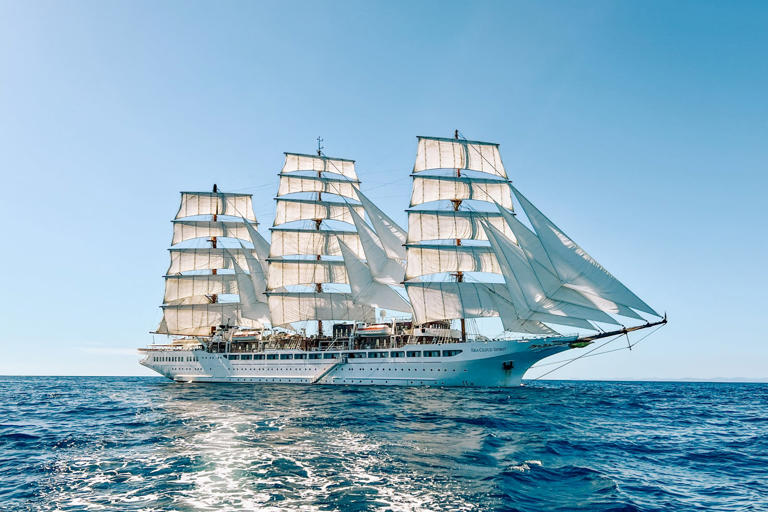
We've detected unusual activity from your computer network
To continue, please click the box below to let us know you're not a robot.
Why did this happen?
Please make sure your browser supports JavaScript and cookies and that you are not blocking them from loading. For more information you can review our Terms of Service and Cookie Policy .
For inquiries related to this message please contact our support team and provide the reference ID below.
Sailboat Parts Explained: Illustrated Guide (with Diagrams)
When you first get into sailing, there are a lot of sailboat parts to learn. Scouting for a good guide to all the parts, I couldn't find any, so I wrote one myself.
Below, I'll go over each different sailboat part. And I mean each and every one of them. I'll walk you through them one by one, and explain each part's function. I've also made sure to add good illustrations and clear diagrams.
This article is a great reference for beginners and experienced sailors alike. It's a great starting point, but also a great reference manual. Let's kick off with a quick general overview of the different sailboat parts.
General Overview
The different segments
You can divide up a sailboat in four general segments. These segments are arbitrary (I made them up) but it will help us to understand the parts more quickly. Some are super straightforward and some have a bit more ninja names.
Something like that. You can see the different segments highlighted in this diagram below:

The hull is what most people would consider 'the boat'. It's the part that provides buoyancy and carries everything else: sails, masts, rigging, and so on. Without the hull, there would be no boat. The hull can be divided into different parts: deck, keel, cabin, waterline, bilge, bow, stern, rudder, and many more.
I'll show you those specific parts later on. First, let's move on to the mast.

Sailboats Explained
The mast is the long, standing pole holding the sails. It is typically placed just off-center of a sailboat (a little bit to the front) and gives the sailboat its characteristic shape. The mast is crucial for any sailboat: without a mast, any sailboat would become just a regular boat.
I think this segment speaks mostly for itself. Most modern sailboats you see will have two sails up, but they can carry a variety of other specialty sails. And there are all kinds of sail plans out there, which determine the amount and shape of sails that are used.
The Rigging
This is probably the most complex category of all of them.
Rigging is the means with which the sails are attached to the mast. The rigging consists of all kinds of lines, cables, spars, and hardware. It's the segment with the most different parts.
The most important parts
If you learn anything from this article, here are the most important parts of any sailboat. You will find all of these parts in some shape or form on almost any sailboat.

Okay, we now have a good starting point and a good basic understanding of the different sailboat parts. It's time for the good stuff. We're going to dive into each segment in detail.
Below, I'll go over them one by one, pointing out its different parts on a diagram, listing them with a brief explanation, and showing you examples as well.
After reading this article, you'll recognize every single sailboat part and know them by name. And if you forget one, you're free to look it up in this guide.

On this page:
The hull is the heart of the boat. It's what carries everything: the mast, the sails, the rigging, the passengers. The hull is what provides the sailboat with its buoyancy, allowing it to stay afloat.
Sailboats mostly use displacement hulls, which is a shape that displaces water when moving through it. They are generally very round and use buoyancy to support its own weight. These two characteristics make sure it is a smooth ride.
There are different hull shapes that work and handle differently. If you want to learn more about them, here's the Illustrated Guide to Boat Hull Types (with 11 Examples ). But for now, all we need to know is that the hull is the rounded, floating part of any sailboat.
Instead of simply calling the different sides of a hull front, back, left and right , we use different names in sailing. Let's take a look at them.

The bow is the front part of the hull. It's simply the nautical word for 'front'. It's the pointy bit that cuts through the water. The shape of the bow determines partially how the boat handles.
The stern is the back part of the hull. It's simply the nautical word for 'back'. The shape of the stern partially determines the stability and speed of the boat. With motorboats, the stern lies deep inside the water, and the hull is flatter aft. Aft also means back. This allows it to plane, increasing the hull speed. For sailboats, stability is much more important, so the hull is rounded throughout, increasing its buoyancy and hydrodynamic properties.
The transom is the backplate of the boat's hull. It's the most aft (rear) part of the boat.
Port is the left side of a sailboat.
Starboard is the right side of a sailboat
The bilges are the part where the bottom and the sides of the hull meet. On sailboats, these are typically very round, which helps with hydrodynamics. On powerboats, they tend to have an angle.
The waterline is the point where the boat's hull meets the water. Generally, boat owners paint the waterline and use antifouling paint below it, to protect it from marine growth.
The deck is the top part of the boat's hull. In a way, it's the cap of the boat, and it holds the deck hardware and rigging.
Displacement hulls are very round and smooth, which makes them very efficient and comfortable. But it also makes them very easy to capsize: think of a canoe, for example.
The keel is a large fin that offsets the tendency to capsize by providing counterbalance. Typically, the keel carries ballast in the tip, creating a counterweight to the wind's force on the sails.
The rudder is the horizontal plate at the back of the boat that is used to steer by setting a course and maintaining it. It is connected to the helm or tiller.
Tiller or Helm
- The helm is simply the nautical term for the wheel.
- The tiller is simply the nautical term for the steering stick.
The tiller or helm is attached to the rudder and is used to steer the boat. Most smaller sailboats (below 30') have a tiller, most larger sailboats use a helm. Large ocean-going vessels tend to have two helms.
The cockpit is the recessed part in the deck where the helmsman sits or stands. It tends to have some benches. It houses the outside navigation and systems interfaces, like the compass, chartplotter, and so on. It also houses the mainsheet traveler and winches for the jib. Most boats are set up so that the entire vessel can be operated from the cockpit (hence the name). More on those different parts later.
Most larger boats have some sort of roofed part, which is called the cabin. The cabin is used as a shelter, and on cruising sailboats you'll find the galley for cooking, a bed, bath room, and so on.
The mast is the pole on a sailboat that holds the sails. Sailboats can have one or multiple masts, depending on the mast configuration. Most sailboats have only one or two masts. Three masts or more is less common.
The boom is the horizontal pole on the mast, that holds the mainsail in place.
The sails seem simple, but actually consist of many moving parts. The parts I list below work for most modern sailboats - I mean 90% of them. However, there are all sorts of specialty sails that are not included here, to keep things concise.

The mainsail is the largest sail on the largest mast. Most sailboats use a sloop rigging (just one mast with one bermuda mainsail). In that case, the main is easy to recognize. With other rig types, it gets more difficult, since there can be multiple tall masts and large sails.
If you want to take a look at the different sail plans and rig types that are out there, I suggest reading my previous guide on how to recognize any sailboat here (opens in new tab).
Sail sides:
- Leech - Leech is the name for the back side of the sail, running from the top to the bottom.
- Luff - Luff is the name for the front side of the sail, running from the top to the bottom.
- Foot - Foot is the name for the lower side of the sail, where it meets the boom.
Sail corners:
- Clew - The clew is the lower aft (back) corner of the mainsail, where the leech is connected to the foot. The clew is attached to the boom.
- Tack - The tack is the lower front corner of the mainsail
- Head - The head is the top corner of the mainsail
Battens are horizontal sail reinforcers that flatten and stiffen the sail.
Telltales are small strings that show you whether your sail trim is correct. You'll find telltales on both your jib and mainsail.
The jib is the standard sized headsail on a Bermuda Sloop rig (which is the sail plan most modern sailboats use).
As I mentioned: there are all kinds, types, and shapes of sails. For an overview of the most common sail types, check out my Guide on Sail Types here (with photos).
The rigging is what is used to attach your sails and mast to your boat. Rigging, in other words, mostly consists of all kinds of lines. Lines are just another word for ropes. Come to think of it, sailors really find all kinds of ways to complicate the word rope ...
Two types of rigging
There are two types of rigging: running and standing rigging. The difference between the two is very simple.
- The running rigging is the rigging on a sailboat that's used to operate the sails. For example, the halyard, which is used to lower and heave the mainsail.
- The standing rigging is the rigging that is used to support the mast and sail plan.
Standing Rigging

Here are the different parts that belong to the standing rigging:
- Forestay or Headstay - Line or cable that supports the mast and is attached to the bow of the boat. This is often a steel cable.
- Backstay - Line or cable that supports the mast and is attached to the stern of the boat. This is often a steel cable.
- Sidestay or Shroud - Line or cable that supports the mast from the sides of the boat. Most sailboats use at least two sidestays (one on each side).
- Spreader - The sidestays are spaced to steer clear from the mast using spreaders.
Running Rigging: different words for rope
Ropes play a big part in sailing, and especially in control over the sails. In sailboat jargon, we call ropes 'lines'. But there are some lines with a specific function that have a different name. I think this makes it easier to communicate with your crew: you don't have to define which line you mean. Instead, you simply shout 'mainsheet!'. Yeah, that works.
Running rigging consists of the lines, sheets, and hardware that are used to control, raise, lower, shape and manipulate the sails on a sailboat. Rigging varies for different rig types, but since most sailboats are use a sloop rig, nearly all sailboats use the following running rigging:

- Halyards -'Halyard' is simply the nautical name for lines or ropes that are used to raise and lower the mainsail. The halyard is attached to the top of the mainsail sheet, or the gaffer, which is a top spar that attaches to the mainsail. You'll find halyards on both the mainsail and jib.
- Sheets - 'Sheet' is simply the nautical term for lines or ropes that are used to set the angle of the sail.
- Mainsheet - The line, or sheet, that is used to set the angle of the mainsail. The mainsheet is attached to the Mainsheet traveler. More on that under hardware.
- Jib Sheet - The jib mostly comes with two sheets: one on each side of the mast. This prevents you from having to loosen your sheet, throwing it around the other side of the mast, and tightening it. The jib sheets are often controlled using winches (more on that under hardware).
- Cleats are small on-deck hooks that can be used to tie down sheets and lines after trimming them.
- Reefing lines - Lines that run through the mainsail, used to put a reef in the main.
- The Boom Topping Lift is a line that is attached to the aft (back) end of the boom and runs to the top of the mast. It supports the boom whenever you take down the mainsail.
- The Boom Vang is a line that places downward tension on the boom.
There are some more tensioning lines, but I'll leave them for now. I could probably do an entire guide on the different sheets on a sailboat. Who knows, perhaps I'll write it.
This is a new segment, that I didn't mention before. It's a bit of an odd duck, so I threw all sorts of stuff into this category. But they are just as important as all the other parts. Your hardware consists of cleats, winches, traveler and so on. If you don't know what all of this means, no worries: neither did I. Below, you'll find a complete overview of the different parts.
Deck Hardware

Just a brief mention of the different deck hardware parts:
- Pulpits are fenced platforms on the sailboat's stern and bow, which is why they are called the bow pulpit and stern pulpit here. They typically have a solid steel framing for safety.
- Stanchons are the standing poles supporting the lifeline , which combined for a sort of fencing around the sailboat's deck. On most sailboats, steel and steel cables are used for the stanchons and lifelines.
Mainsheet Traveler
The mainsheet traveler is a rail in the cockpit that is used to control the mainsheet. It helps to lock the mainsheet in place, fixing the mainsails angle to the wind.

If you're interested in learning more about how to use the mainsheet traveler, Matej has written a great list of tips for using your mainsheet traveler the right way . It's a good starting point for beginners.
Winches are mechanical or electronic spools that are used to easily trim lines and sheets. Most sailboats use winches to control the jib sheets. Modern large sailing yachts use electronic winches for nearly all lines. This makes it incredibly easy to trim your lines.

You'll find the compass typically in the cockpit. It's the most old-skool navigation tool out there, but I'm convinced it's also one of the most reliable. In any way, it definitely is the most solid backup navigator you can get for the money.

Want to learn how to use a compass quickly and reliably? It's easy. Just read my step-by-step beginner guide on How To Use a Compass (opens in new tab .
Chartplotter
Most sailboats nowadays use, besides a compass and a map, a chartplotter. Chartplotters are GPS devices that show a map and a course. It's very similar to your normal car navigation.

Outboard motor
Most sailboats have some sort of motor to help out when there's just the slightest breeze. These engines aren't very big or powerful, and most sailboats up to 32' use an outboard motor. You'll find these at the back of the boat.

Most sailboats carry 1 - 3 anchors: one bow anchor (the main one) and two stern anchors. The last two are optional and are mostly used by bluewater cruisers.

I hope this was helpful, and that you've gained a good understanding of the different parts involved in sailing. I wanted to write a good walk-through instead of overwhelming you with lists and lists of nautical terms. I hope I've succeeded. If so, I appreciate any comments and tips below.
I've tried to be as comprehensive as possible, without getting into the real nitty gritty. That would make for a gigantic article. However, if you feel I've left something out that really should be in here, please let me know in the comments below, so I can update the article.
I own a small 20 foot yacht called a Red witch made locally back in the 70s here in Western Australia i found your article great and enjoyed reading it i know it will be a great help for me in my future leaning to sail regards John.
David Gardner
İ think this is a good explanation of the difference between a ”rope” and a ”line”:
Rope is unemployed cordage. In other words, when it is in a coil and has not been assigned a job, it is just a rope.
On the other hand, when you prepare a rope for a specific task, it becomes employed and is a line. The line is labeled by the job it performs; for example, anchor line, dock line, fender line, etc.
Hey Mr. Buckles
I am taking on new crew to race with me on my Flying Scot (19ft dingy). I find your Sailboat Parts Explained to be clear and concise. I believe it will help my new crew learn the language that we use on the boat quickly without being overwhelmed.
PS: my grandparents were from Friesland and emigrated to America.
Thank you Shawn for the well written, clear and easy to digest introductory article. Just after reading this first article I feel excited and ready to set sails and go!! LOL!! Cheers! Daniel.
steve Balog
well done, chap
Great intro. However, the overview diagram misidentifies the cockpit location. The cockpit is located aft of the helm. Your diagram points to a location to the fore of the helm.
William Thompson-Ambrose
An excellent introduction to the basic anatomy and function of the sailboat. Anyone who wants to start sailing should consider the above article before stepping aboard! Thank-you
James Huskisson
Thanks for you efforts mate. We’ve all got to start somewhere. Thanks for sharing. Hoping to my first yacht. 25ft Holland. Would love to cross the Bass Strait one day to Tasmania. 👌 Cheers mate
Alan Alexander Percy
thankyou ijust aquired my first sailboat at 66yrs of age its down at pelican point a beautifull place in virginia usa my sailboat is a redwing 30 if you are ever in the area i wouldnt mind your guidance and superior knowledge of how to sail but iam sure your fantastic article will help my sailboat is wings 30 ft
Thanks for quick refresher course. Having sailed in California for 20+ years I now live in Spain where I have to take a spanish exam for a sailboat license. Problem is, it’s only in spanish. So a lot to learn for an old guy like me.
Very comprehensive, thank you
Your article really brought all the pieces together for me today. I have been adventuring my first sailing voyage for 2 months from the Carolinas and am now in Eleuthera waiting on weather to make the Exumas!!! Great job and thanks
Helen Ballard
I’ve at last found something of an adventure to have in sailing, so I’m starting at the basics, I have done a little sailing but need more despite being over 60 life in the old dog etc, thanks for your information 😊
Barbara Scott
I don’t have a sailboat, neither do l plan to literally take to the waters. But for mental exercise, l have decided to take to sailing in my Bermuda sloop, learning what it takes to become a good sailor and run a tight ship, even if it’s just imaginary. Thank you for helping me on my journey to countless adventures and misadventures, just to keep it out of the doldrums! (I’m a 69 year old African American female who have rediscovered why l enjoyed reading The Adventures of Robert Louis Stevenson as well as his captivating description of sea, wind, sailboat,and sailor).
Great article and very good information source for a beginner like me. But I didn’t find out what I had hoped to, which is, what are all those noisy bits of kit on top of the mast? I know the one with the arrow is a weather vane, but the rest? Many thanks, Jay.
Louis Cohen
The main halyard is attached to the head of the mainsail, not the to the mainsheet. In the USA, we say gaff, not gaffer. The gaff often has its own halyard separate from the main halyard.
Other than that it’s a nice article with good diagrams.
A Girl Who Has an Open Sail Dream
Wow! That was a lot of great detail! Thank you, this is going to help me a lot on my project!
Hi, good info, do u know a book that explains all the systems on a candc 27,
Leave a comment
You may also like, guide to understanding sail rig types (with pictures).
There are a lot of different sail rig types and it can be difficult to remember what's what. So I've come up with a system. Let me explain it in this article.

The Ultimate Guide to Sail Types and Rigs (with Pictures)

The Illustrated Guide To Boat Hull Types (11 Examples)

How To Live On a Boat For Free: How I'd Do It

How To Live on a Sailboat: Consider These 5 Things

COMMENTS
Especially since some of these terms date back to prehistoric times and are kept around for the sole purpose of elitism. So to help you navigate this world for which you often need a dictionary, here is one. These are sail names explained for beginners. Here are the 15 most common sails: Mainsail. Foresail.
Luff: The forward edge of the sail. Leech: Back edge of the sail. Tack: The lower front corner of the sail. Clew: The bottom back corner of the sail. Foot: Bottom of the sail. There are two sail shapes, the fore-and-aft rigged sails, and square-rigged sails.
The 5 most common two-masted rigs are: Lugger - two masts (mizzen), with lugsail (cross between gaff rig and lateen rig) on both masts. Yawl - two masts (mizzen), fore-and-aft rigged on both masts. Main mast much taller than mizzen. Mizzen without mainsail. Ketch - two masts (mizzen), fore-and-aft rigged on both masts.
5. Gennaker. As the name suggests, the Gennaker sail combines a spinnaker and a Genoa sail. They are as large as the spinnaker, although they're not symmetrical. They come in handy whenever the wind changes from a pure dead run to a reaching point of sail, as sailors can navigate various wind types with the same sail.
Headsail/Jib. The headsail, or the jib, is likely the second most popular kind of sail found on sailboats. This is because it often accompanies the mainsail, the most popular kind. On all sailboats, the headsail is put at the front of the mast over the sailboat's bow. It is always a smaller sail than the mainsail.
A sailboat uses two sails because the wind left over by the first sail is easily caught by the second sail. This helps in steering the sailboat to a better extent and gives the sailboat more power. Final Thoughts. Sails are one of the major assets of a sailboat. From managing wind to maximizing the performance and longevity of a sailboat, the ...
There are different types of sails used in specific boats. Check out some of the names of sails listed below to find out the most common sails names …. In This Article hide. Common Types of Sails. Mainsail. Staysail. Genoa. Spinnaker. Gennaker.
Spinnaker sails are a type of downwind sail that can be used to increase boat speed when sailing in light winds. They are typically used in wind conditions below 10 knots, which are considered light air sails. Spinnakers come in two types: symmetrical and asymmetrical. Author: Ken Heaton CC BY-SA-4..
The Most Popular Types Of Sails On A Sailboat. A sloop-rigged sailboat typically features a mainsail, a headsail, and an additional light-wind sail, such as a spinnaker or Gennaker. The mainsail is rigged aft of the mast, while the headsail is attached to the forestay. The two most commonly used headsails are the Genoa and Jib.
The mainsail, headsail (or jib), genoa, spinnaker, and gennaker are the most popular types of sails on sailboats. There are also a number of different configurations when considering the type of sail and mast in use including a sloop, fractional rig sloop, cutter, ketch, schooner, yawl, and cat. Simply put, different sailboat sails serve ...
June 17, 2024. Sailboats are powered by sails using the force of the wind. They are also referred to as sailing dinghies, boats, and yachts, depending on their size. Sailboats range in size, from lightweight dinghies like the Optimist dinghy (7'9") all the way up to mega yachts over 200 feet long. The length is often abbreviated as LOA (length ...
The two-masted rigs are: Lugger - two masts (mizzen), with lugsail (a cross between gaff rig and lateen rig) on both masts. Yawl - two masts (mizzen), fore-and-aft rigged on both masts. Main mast is much taller than mizzen. Mizzen without a mainsail. Ketch - two masts (mizzen), fore-and-aft rigged on both masts.
Short answer: Names of sails on a sailboat: Sails on a sailboat are commonly referred to by various names, including the mainsail, jib, genoa, spinnaker, staysail, and mizzen. Each sail serves a specific purpose in harnessing wind power for propulsion. Understanding the Basics: A Guide to the Names of Sails on a SailboatUnderstanding the Basics:
Many sail controls, including the boom vang, backstay, main halyard, and even the cunningham, to name a few, focus on keeping this curve perfect. ... Downwind Sails. Modern sailboats are a lot easier to maneuver thanks to the fore-and-aft rig. Unfortunately, when sailing downwind they catch less wind, and downwind sails are a great way of ...
A schooner is a two-or-more masted sailboat, in which the aft-most mast - the mainmast - is the same height or taller than the foremast. The one shown here is gaff cutter rigged, with a topsail set on the mainmast. Many sailors agree that of all the different types of sailboats, a schooner under full sail is one of the most beautiful sights afloat.
The Modern Sloop. The most common type of small-to-midsize sailboat is the sloop. The rig is one mast and two sails. The mainsail is a tall, triangular sail mounted to the mast at its leading edge, with the foot of the sail along the boom, which extends aft from the mast. The sail in front called the jib or sometimes the headsail, mounts on the ...
A gaff rig is named for the extra spar, called a gaff, which is raised with the sail and results in a four-sided mainsail (and/or mizzen). Gaff rigged boats are generally less efficient at sailing upwind. The end of the gaff near the mast is called the throat and the end furthest away is called the peak. Ketch.
The most common kind of sailboat is the sloop, as it's simple to operate and versatile. Other common sailboat types include the schooner, cutter, cat, ketch, schooner, catamaran, and trimaran. Other sailboat variations include pocket cruisers, motorsailers, displacement, and shoal-draft vessels. The information found in this article is sourced ...
The following is a partial list of sailboat types and sailing classes, including keelboats, dinghies and multihull (catamarans and trimarans). Olympic classes Laser. Name Year of first construction ... Name Number built Year of first construction Designer Builder Notes Albacore: 1950: Uffa Fox: Several: 420: 56,000: 1959: Christian Maury ...
Sailboat Rig Options. A sailing vessel's rig refers to its configuration of masts, sails, and rigging. Different names are applied to different rig configurations. Examples of rigs include the schooner rig, cutter rig, and junk rig, among others. Rigs can generally be categorized as "fore-and-aft," "square," or a combination of both.
Sail Croatia's new Wines of Croatia cruise to learn all about the ancient grape varieties of the Dalmatia coast region of Croatia, while sailing in luxury on a small ship. New for 2024, the ...
The pleasure derived from sailing is largely contingent on the kind of boat employed and, crucially, the sailor's ability to navigate it. A sailor will find it greatly more enjoyable to sail a ...
The Trabaccolo is a small cargo ship used in the Adriatic Sea. It has lug sails. A lug rig is a rectangular sail, but on a long pole or yard that runs fore-and-aft. It was a popular Venetian sailboat used for trade. The name comes from the Italian word trabacca, which means tent, referring to the sails. How to recognize a Trabaccolo: wide and ...
The Coast Guard plucked Michael Barlow, 39, out of the Gulf of Mexico as he was forced to abandon a sailboat that survived Hurricane Alberto and washed up in Pensacola, Florida.
A second-hand sailing boat bought by the government for half a million euro to be used for international sailing competitions has been left idle for 18 months as it is still "being upgraded", The Shift is informed. The boat was inaugurated in December 2022. During a lavish ceremony at Marsa's Malta Maritime Hub, Sports Minister Clifton ...
At 11:30 a.m. Sunday morning, with New York City under a heat advisory, a gaggle of sailing enthusiasts, dressed in polo shirts and summer dresses, boarded a ferry for Governors Island to watch ...
The former is a 23-year-old, three-masted barque propelled by 23 sails (five fewer than Sea Cloud Spirit); the latter is a 93-year-old, four-masted barque with 30 sails and a storied past.
New cruise ships don't exactly go up overnight. That makes Disney's timing all the more fortuitous ...
The biggest US banks passed the Federal Reserve's annual stress test, paving the way for higher shareholder payouts as the industry awaits a watered-down version of a separate proposal for ...
The hull is what most people would consider 'the boat'. It's the part that provides buoyancy and carries everything else: sails, masts, rigging, and so on. Without the hull, there would be no boat. The hull can be divided into different parts: deck, keel, cabin, waterline, bilge, bow, stern, rudder, and many more.